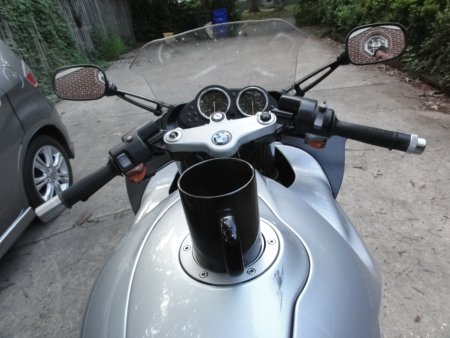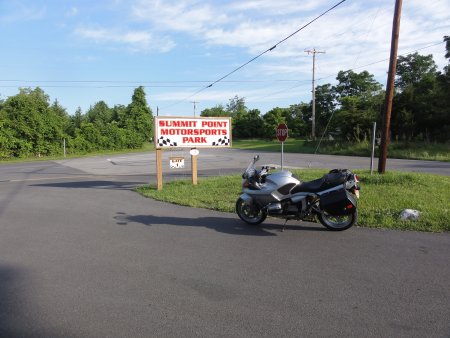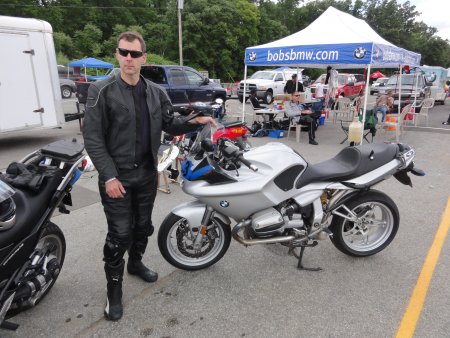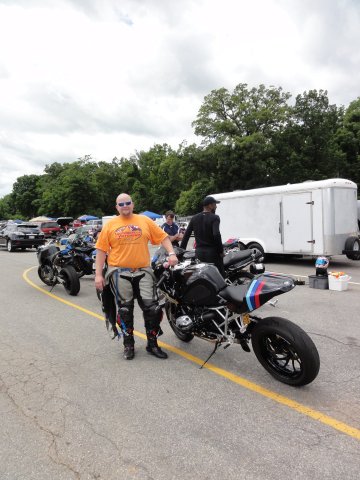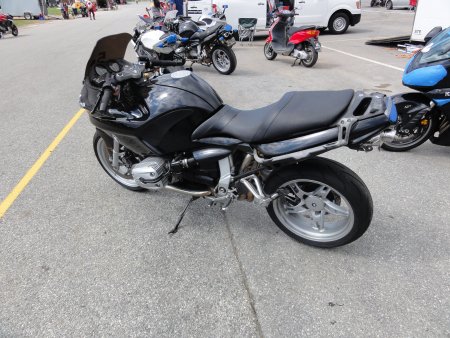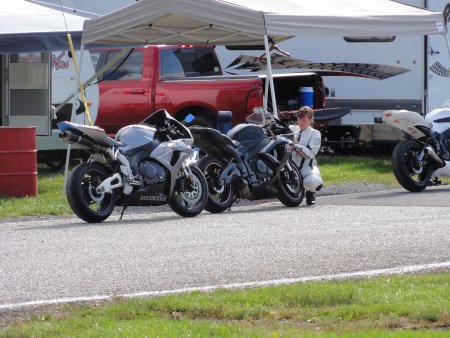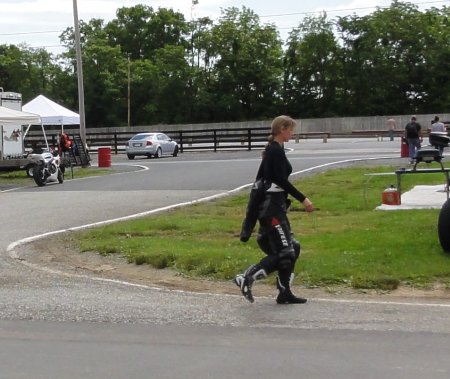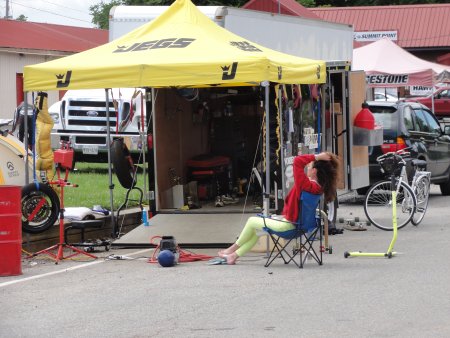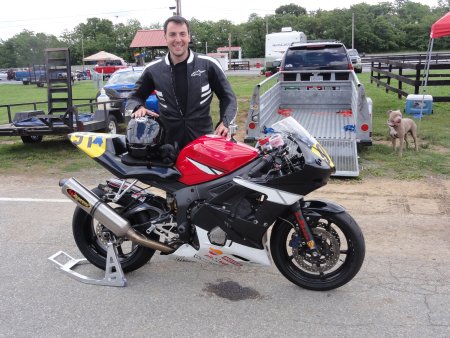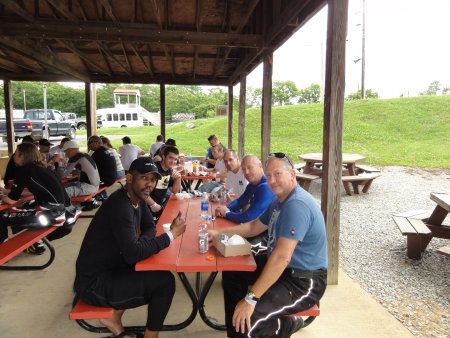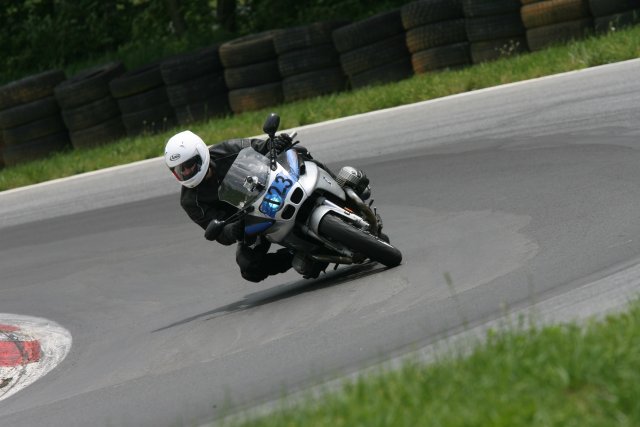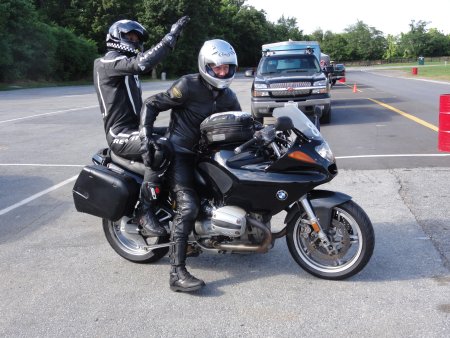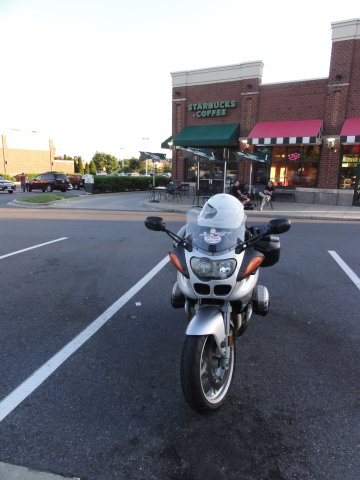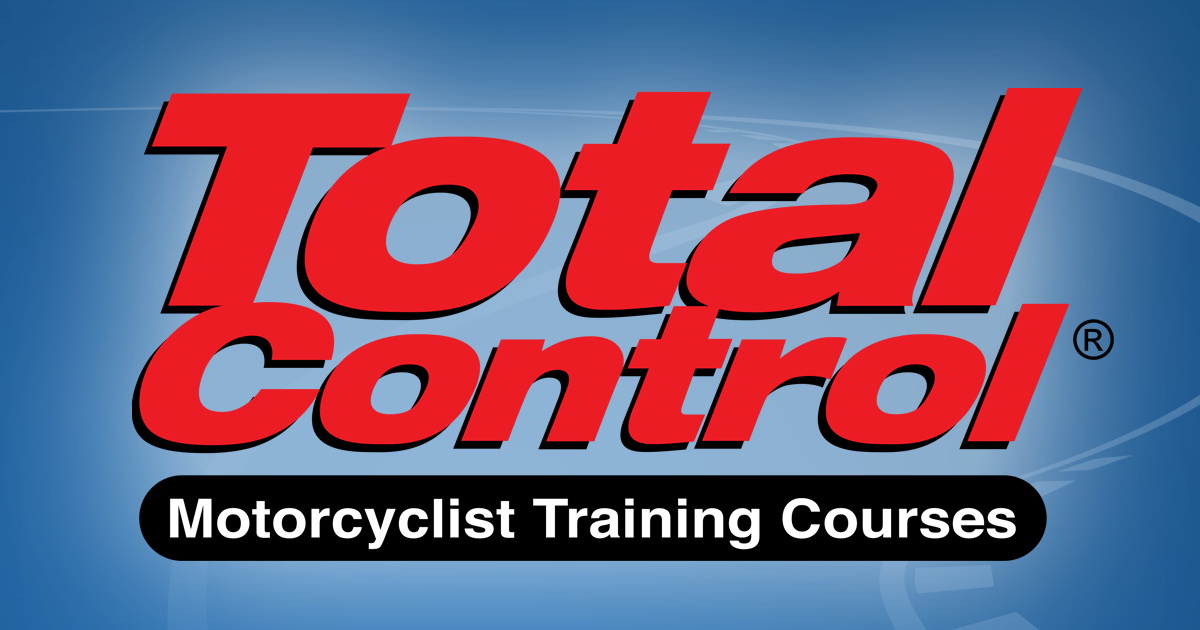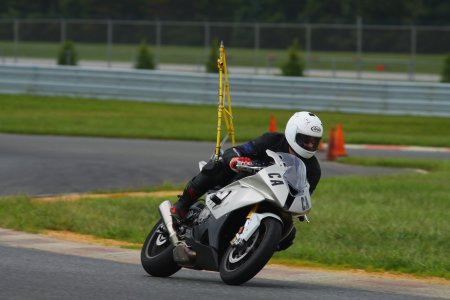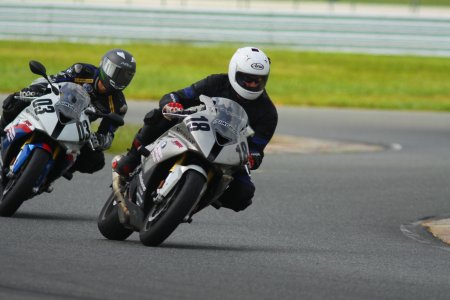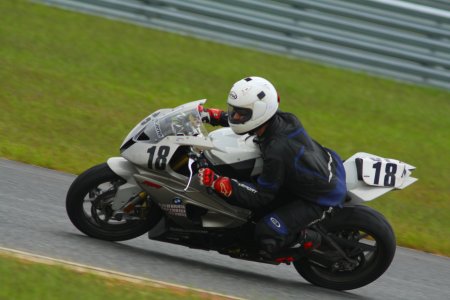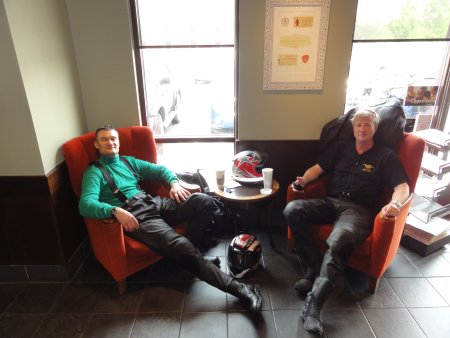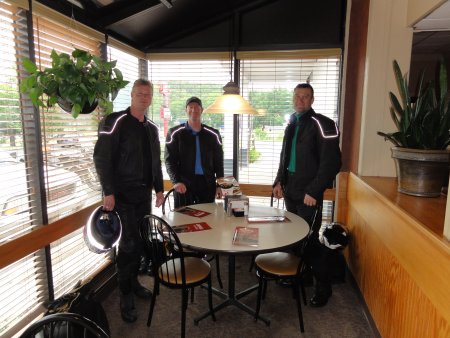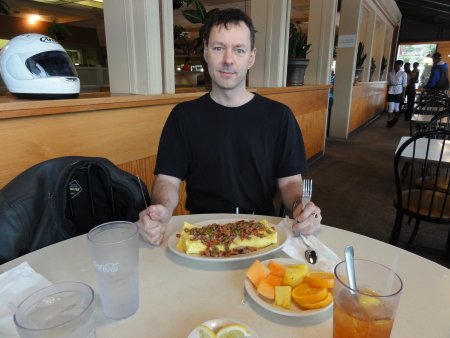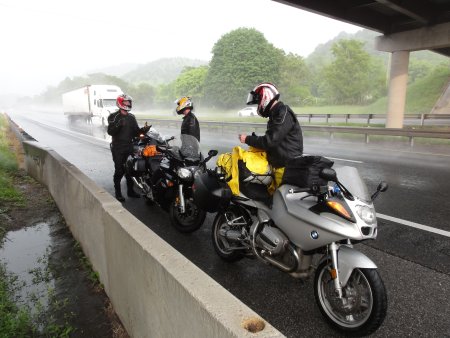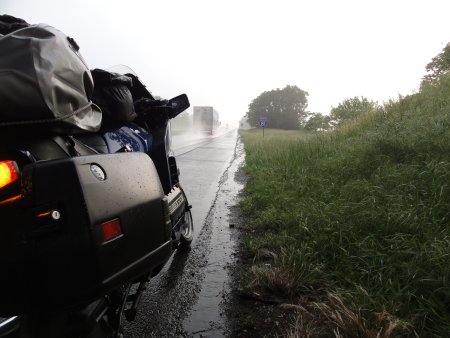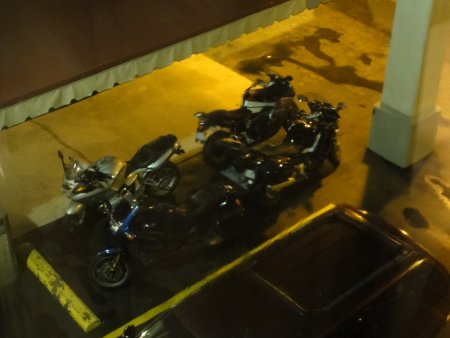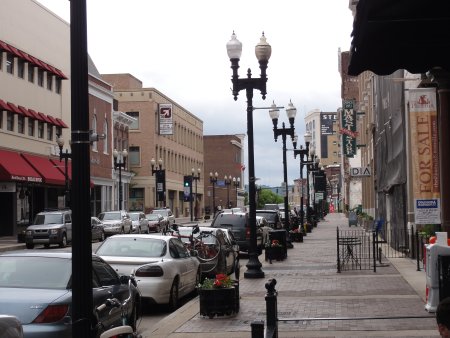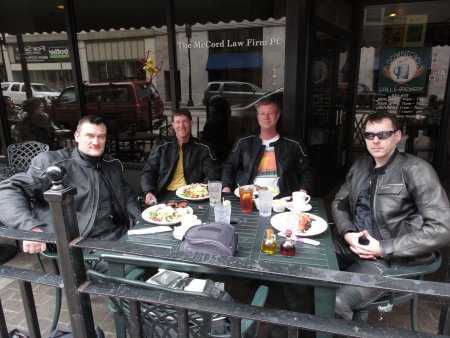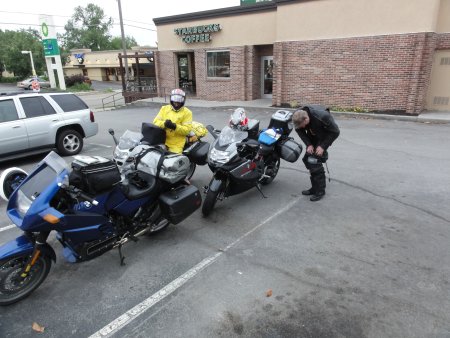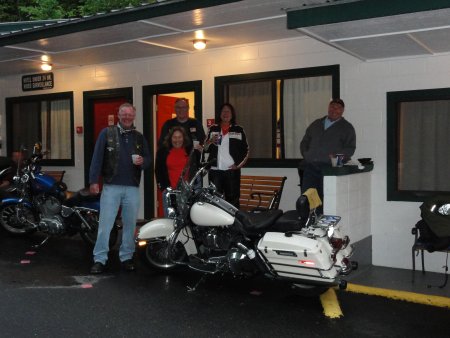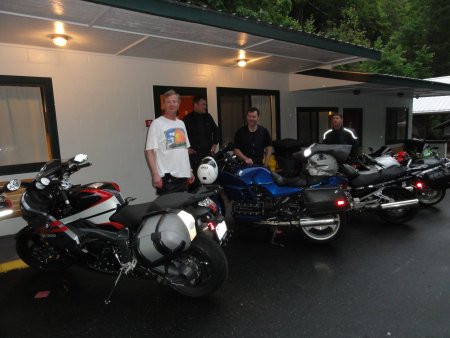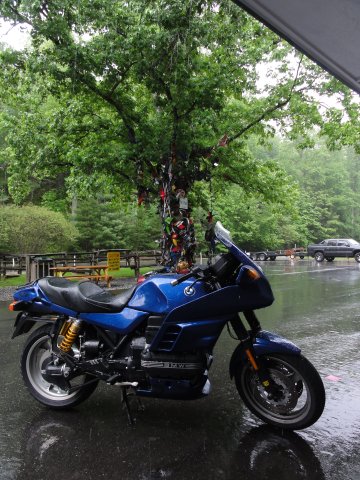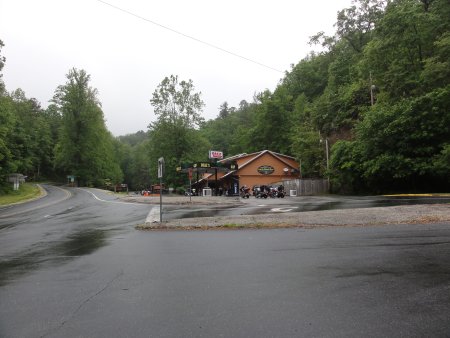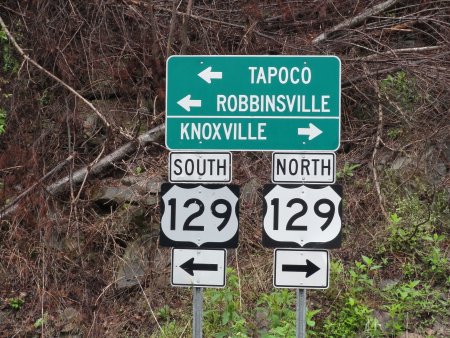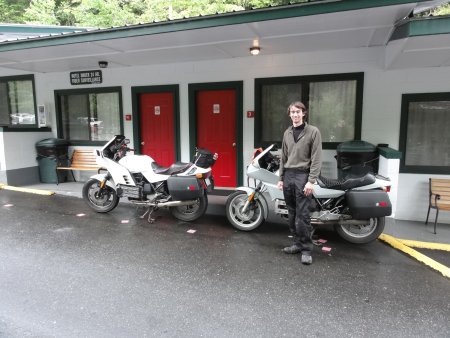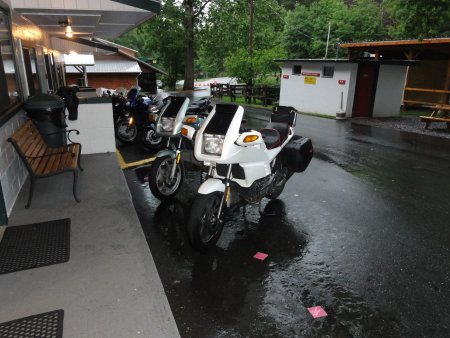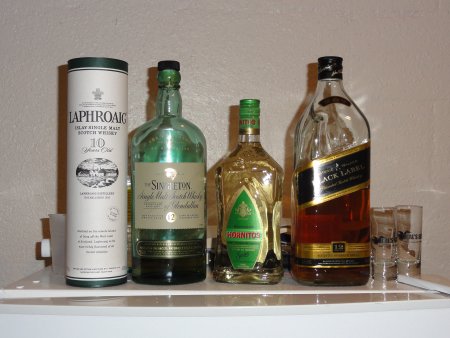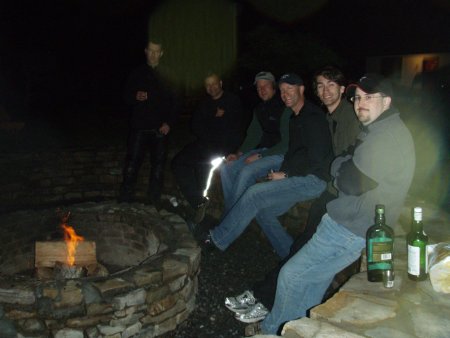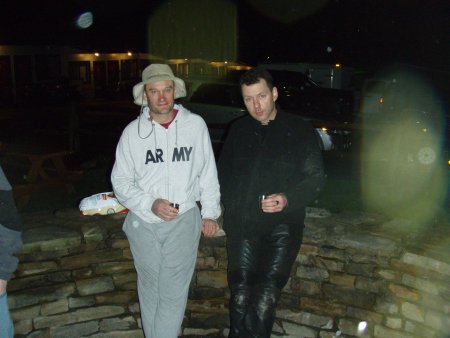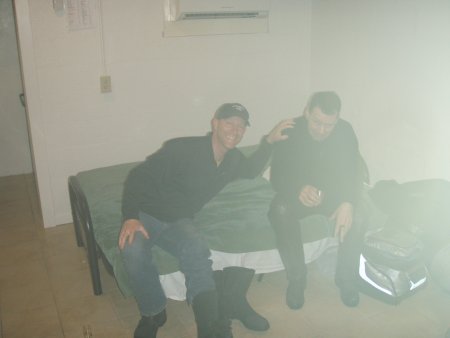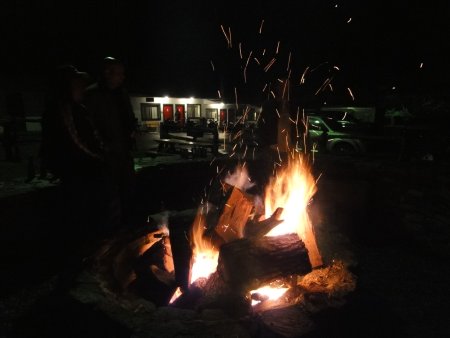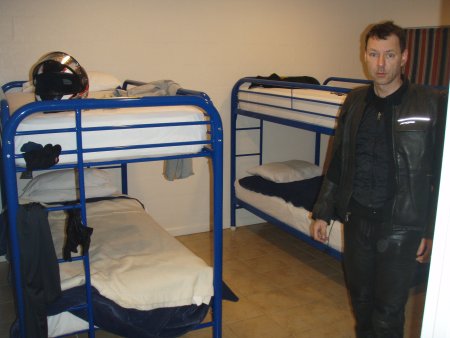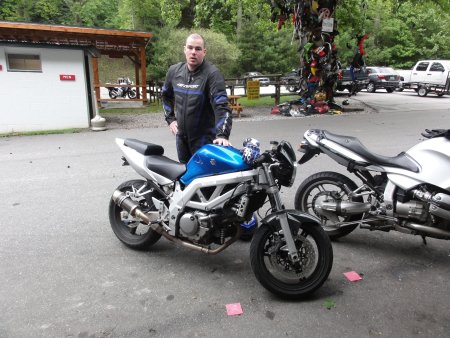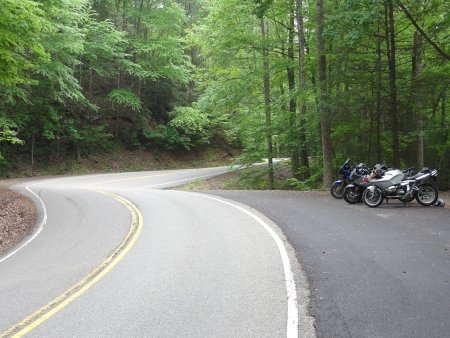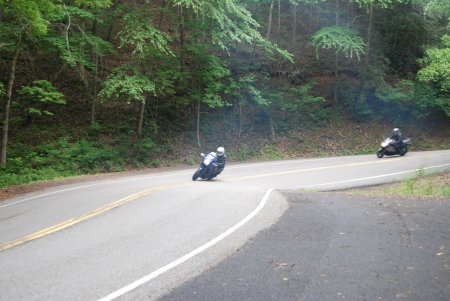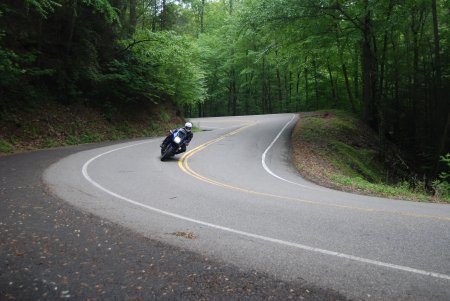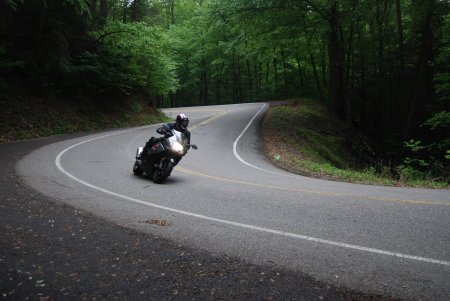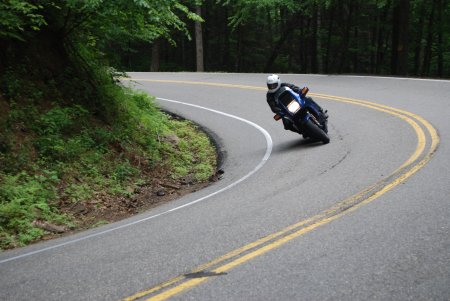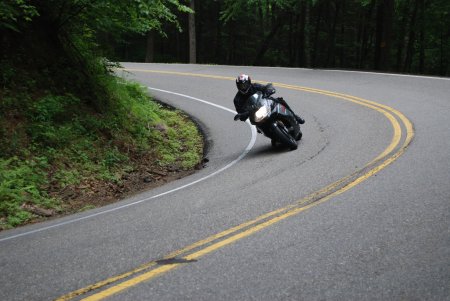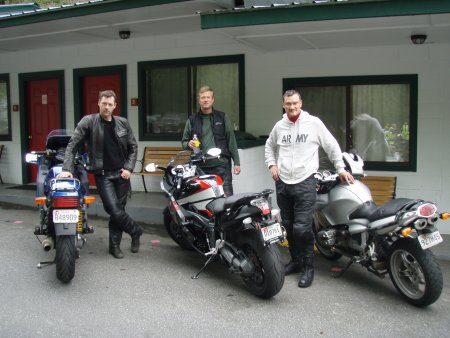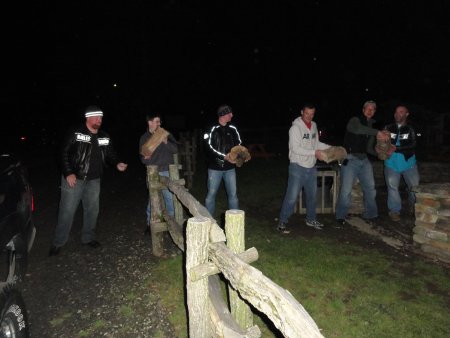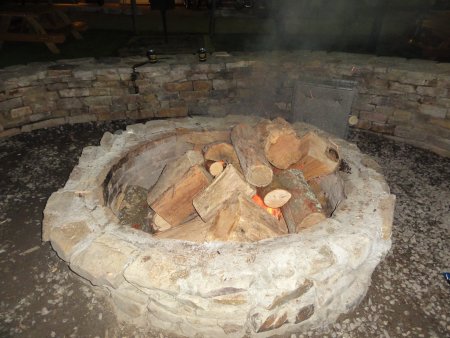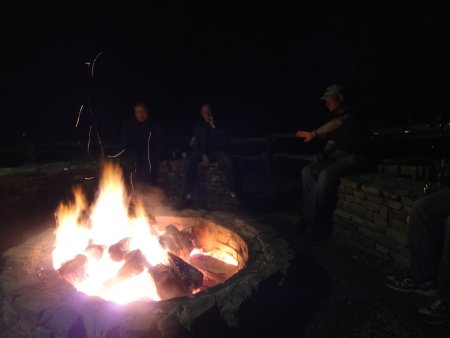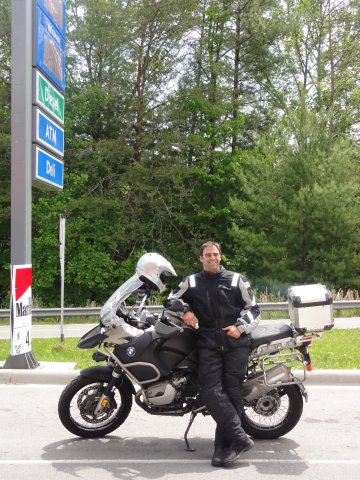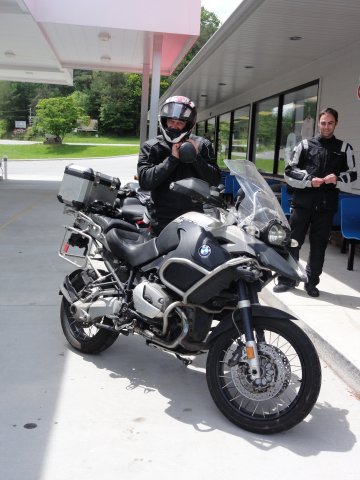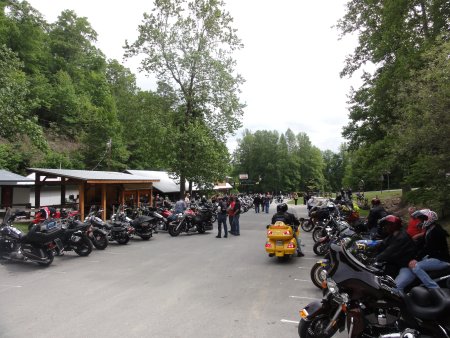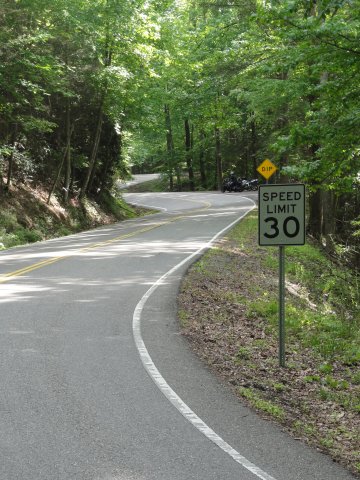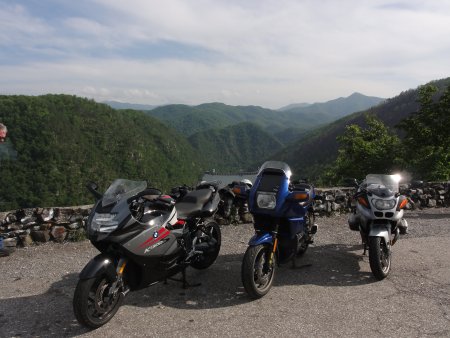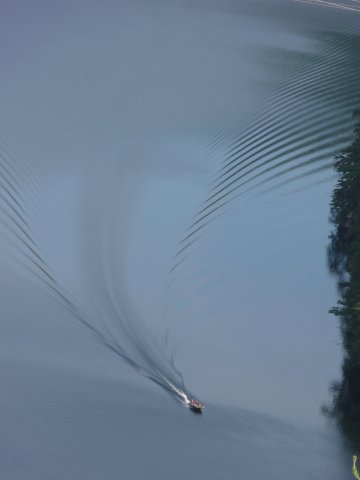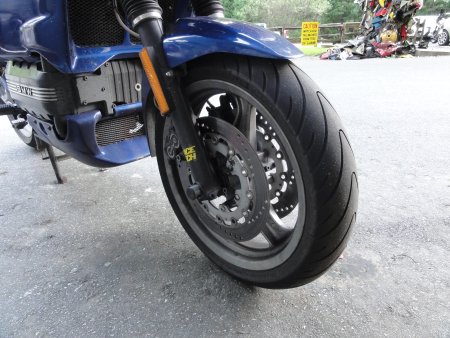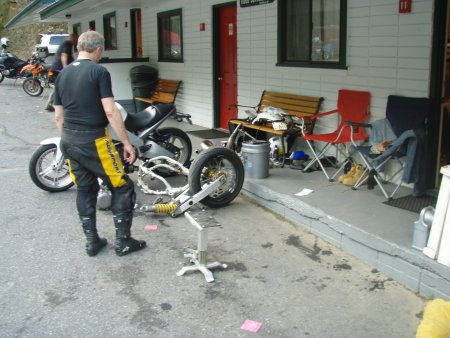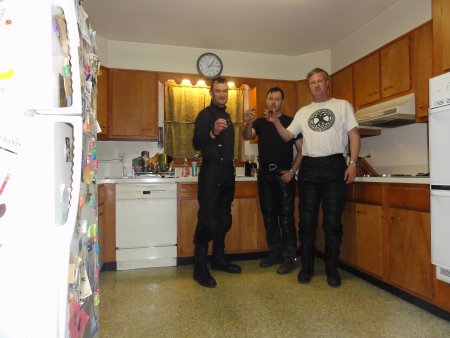
The road reports for the recent trip to Deal's Gap are coming, but in the meantime ...
I've been told that in the good 'ol days the only way you could ride on a race track was to be in a race. Now a days, there's this thing called a "Track Day". The idea of a track day is you get to take your regular street bike and ride it around on a track at whatever speed you happen to feel comfortable. There are no speed limits. Literally.
The thought of a track day had scared me for some time. I would imagine a mess of bikes with riders of varying skill levels careening down a straight getting bunched up haphazardly in a corner. I would imagine the mess of broken metal and body parts that could result. I was especially concerned about riding a much slower bike in a field of super bikes and getting rear-ended at speed.
Shudder.
Thanks to a skillful hand played by Sonia, Ryan's wife, last year in September, I found myself on a track learning how to improve my riding in ways I never imagined possible at Keith Code's California Superbike School. Since then I've wanted to practice what I had learned.
So it came to pass one day, that Bob's BMW in cooperation with Motorcycle Xcitement hosted a Track Day event up at Summit Point Raceway. What I didn't realize is that it would be a more controlled environment than I had imagined. Given that it was Bob's and the average age of their clientele is probably a bit older than myself, I figured it would probably not be "too fast". After all, I'm not a fast rider. It's my story and I'm sticking to it.
I decided to take the guest bike since it's a more capable machine and I had just redone the suspension with a set of premium Ohlins shocks which Bob's service department had set up for me. I had ordered a set of Michelin Pilot Power 2CT tires as soon as I got back from Deal's Gap. My friend Audrey came over two nights before to help me prep the bike. Through a couple of recent tire changes she had learned to use the No Mar Tire Changer. She mounted the tires while I focused on trying to get the front end to align. Do I have good friends or what? Without her help I doubt everything would have gotten done. There had been a little slow speed mishap a Deal's Gap the week before and the bike had been in a minor get-off that left the front suspension tweaked. No, I wasn't riding it at the time. I did the best I could to line things up but I'm afraid the forks are probably irreparably bent. It seemed to do ok but I wasn't sure if I would notice any issues going at break-neck track speed. After quite a bit of soul searching and over 100 miles of test rides, I decided it was probably still better to take the guest bike tweaked front suspension and all rather than risk my less capable Beloved Blue Bike.
Summit Point Raceway is a little over 80 miles from my house. The paperwork for the event said the riders orientation meeting was to be at 8:30. Considering the possibility of traffic, I decided to get up at 5:30 and leave by 6:15. The last thing I wanted was to be rushed and overwhelmed.
5:30 is a harsh mistress. Why 45 minutes you say? Well, without coffee there is no life.
I had done pretty well the night before to prep everything so there wasn't much to do but drink enough coffee to stay awake and hit the road. Unfortunately, there was more traffic than I was expecting. I arrived at Summit Point Raceway at 7:55AM.
I went through and found the Bob's BMW area. Lex, Darryl and Charlie who work at Bob's were there along with a few customers. I would later come to understand what a benefit it is to have someone there with a canopy, chairs, and snacks. They had grapes, apples, bananas, junk food and water. It was also very helpful to have some friendly faces there to guide me through the registration and tech inspection processes.
Charlie instructed me to rush and see if I could get through registration and have my bike inspected before the riders meeting which was scheduled to start at 8:15.
"8:15!?! But the paperwork said 8:30." I said. So the rushing and stress began. This is much the way I felt at Track School. There's a bustle of activity. You have to constantly watch out for bikes coming and going. People are everywhere. "Go to the red roofed building to get your registration card." Charlie said. I had to ask three times because there were several red roofed buildings. I could feel myself getting unsettled and my vision narrowing.
But I remembered this feeling and knew it would pass.
So if you ever want to do a track day, it's important to note that registration happens first. They give you a little card. You take the little card, your bike and your helmet over to the tech inspection stand where a tech will give it a quick 30 second once over. He'll check the tires, the brakes and the levers. If it's a street bike you need to tape up not only the mirrors but all the lights. I did not know this. Electrical tape is not good to use because it's hard to remove and leaves a residue. It's apparently best to use the blue painters tape. Bob's had tape there and showed me what to tape up. The tech will also look at your helmet to make sure it does not have any major defects. You need to have good gloves, boots, and a jacket/pants combination that zips together or a one piece race suite. The paperwork makes it sound like the tech inspection is a big deal but it's apparently just a quick once over.
I did notice that most people seemed to be wearing full race gear. This should have been a Sign(tm).
The riders meeting was starting just as I got through inspection. I hate being rushed. I truly despise it.
There were a disturbingly large number of people here. Roger Lyle, the man behind the Motorcycle Xcitement organization, gave a briefing. He has an unusual presentation style that seemed a bit out of place for a Track Day orientation. He invokes "God", the "Bible" and other Christian imagery quite often. Just as I began to fear this was going to turn into a sermon, he turned the briefing to the topic at hand and started the introduction to the track rules.
Riders are divided up into a bunch of different groups. The noobs are put in the beginners group. Everyone starts there. There are also intermediate, advanced and race school groups. Most of the Bob's guys were in the intermediate group. Only one group of riders are on the track at any given time. Each track session lasts about 15 minutes. The beginners have additional rules placed on them. As a beginner you are not allowed to pass in corners. This would prove to be a noticable limitation for me given that I have a slow bike. It was also made clear that there would be coaches on the track with us and that they would be available to answer questions.
The first session on the track was to be a slow speed orientation session to let riders get to know the track. I was starting to feel much more comfortable about the whole thing. They stressed repeatedly that this is not a race. Do not ride at the limit of your capability. Leave some room for error. This further built my comfort level.
He went on to talk about "finding a buddy". "Find someone out there that rides at about your level and follow him or her. That'll be your buddy and you'll have a better time."
All good things come to an end as was the case with my feelings of comfort.
An EMT service was there with ambulances at the ready. The main guy whose name I forget said, "Now this is really important. If you have an accident we'll come up and we'll ask you your name. If you don't respond or you're too busy moaning, we'll call for the bird. So it's really important. Stop moaning and answer with your name. Got it?" he said matter of factly.
"Remember, when asked, stop moaning in agony. Say my name. Resume moaning in agony. Check." I would remind myself tentatively. Safe they said. Exactly how fast would we be going?
After the riders meeting I headed back over to the Bob's tent to store my bags and get ready to ride. The advanced riders went out first. The intermediate went second. So I had at least half an hour before my first track session.
Lex, on the left, is the Bob's contact for the event. Darryl, on the right, works in the service department. I don't know Lex very well having only spoken to him a few times over the many years he's worked at Bob's. Darryl and I have spoken more often. He's a really good guy and has always been kind to me. I was looking forward to riding on the track with him. He's got a Miles-By-Motorcycle sticker on his black R1100S bike. Pretty cool.
Announcements would come over the loudspeaker indicating which group was to be up next. They would announce 10 minutes or so ahead. It was time for the intermediate group to ride. They lined up waiting for the signal to go.
I watched for a little while. To my surprise they were certainly going much faster than we had been at the Keith Code school. I was not sure what to expect. The first session for the beginners group was called sooner than I expected so it was yet another rush to put my gear back on, get my bike and line up. I was surprised to see how many of the so called "Beginners" had full race leathers. Many seemed to have dedicated track bikes with numbers on them. I'm pretty sure my 1999 R1100S was by far the slowest bike in the group. Once again I felt a bit intimidated and was afraid I was going to be holding things up.
Onto the track we went slowly. A group of 10 of us putted around the track. To my surprise, it was almost too slow. The riders ahead of me, even the ones in full race gear on dedicated race bikes, were more tentative negotiating these long sweeping corners than I would have expected. Once again, I have to remind myself not to judge a book, positively or negatively, based on it's cover. It did, however, give me a chance to get a pretty good look at the track but I would have liked to have gone a little faster in that first session so I could have gotten a better sense of it.
In the second session, I was able to pick up the pace a bit but found that I kept getting behind riders that would bolt from corner to corner much faster than I could only to slow down painfully in corners. "No passing in corners." was the rule even if they are crawling. This was stressing me out because I really wanted to practice cornering. A coach started following me around and would occasionally lead. But inevitably we would get caught behind a bunch of very slow riders. Once we came around to the straights everyone would get on the gas and leave me behind. There was no catching up. And the story would repeat itself at the next corner where I would catch up and have to slow way down. This really was no fun at all. So I attempted to hold back a little bit and bolt out of a corner in some of the slower sections to get ahead of people. It felt really rude and I was trying very hard to pass without unsettling anyone.
After the session, the coach, a pleasant enthusiastic guy named Greg, came over and talked to me. "You pass very politely. You're not unsettling anyone. You're doing well." I mentioned I was having trouble passing in the straights because compared to these 150+hp monstrosities out there my little 85hp bike just can't keep up in the straights. "Out brake them. They'll hit the brakes earlier. You can get by them right before going into the turns." he suggested.
During the next session things started to become fun. I did as Greg suggested and in the main straight where I could reach maybe 132 mph I would simply wait a bit longer to brake. As the others hit the brakes early to tentatively go around turn 1, I would rush past, waiting to brake at the last moment I felt comfortable. The first two or three times I did this it was a little scary because I misjudged where to brake and damn near had to do a panic stop. The rear of the bike got light and started wiggling and I wasn't sure if I could make the turn but I did manage to save it with some margin for error. Slowing down from 130 to 30 in a hurry is challenging and isn't something I've done before. It's a good skill to have but hard to practice when you're surrounded by other bikes you're trying to get past.
I noticed I wasn't being passed very much. At one point I came upon a guy on a Yamaha R6 who was moving along at a really good pace. I started following him and stayed with him for the rest of the session. "This is my buddy." I thought. It was a blast. As I rolled up, I saw he was talking to Greg. I waited patiently. Greg said to me, "You and this other guy, Nathan, are the two fastest riders in the beginners group by far. You're lapping many of the others. I think you should get bumped up to the intermediate group. At your pace, you're a solid mid-level intermediate rider. But it takes two coaches to sign off so let's go find one to follow you."
We chatted for a bit. He used to race motocross but said that as he's gotten older he no longer has that win-at-all-costs mentality that's necessary for racing. "I prefer coaching now. It's relaxing." he said. He seemed to really enjoy sharing knowledge.
We talked to a coach, Lucas, who agreed to follow me for an evaluation. I went back to the Bob's tent to get some water and take a break.
I found myself thinking, as I sat there sipping on the water that Bob's provided, that on the one hand having a little canopy, some chairs and water doesn't seem like much but man would I miss it if it weren't there. Because of the work the Bob's BMW stuff does and all the stuff they bring, someone can just ride up on their street bike and take it on the track. They make it so much easier for someone to do this than it would be otherwise. Without them there, I'd likely be baking in the sun not having any place in the shade, which on this day wasn't too bad as the weather was absolutely beautiful. A cool breeze was ever present. If I do a future track day event where the Bob's crew aren't there I'll have to figure something out. I must admit if you've never done a track day and would like to get a taste of it, joining the Bob's BMW track day event is about as trouble free an introduction as one could get.
Most other riders had trailers and cars and their own canopies to sit under. There's just all this additional stuff you need to do these things on your own.
I was hoping to ride with Darryl on the next session, but unfortunately, he had some bad news. He had mentioned before track day that his bike was making some unusual noises and it looks like it self destructed on the track with just under 90,000 miles on the clock. He was visibly bummed about this.
I think this is his bike. if it isn't it's very similar to his bike. Since I was still in the beginners group and he was in the intermediate group, I offered to let him ride the guest bike but unfortunately he wasn't interested. I did have good coffee with me, of course, so I offered him some. Bummer, I had really been looking forward to riding with him.
Down at Deal's Gap I had noticed that there were many more female riders than I had ever seen before. I noticed the same phenomenon here. There were far more female riders than I would have expected and all of the women riders I saw were on full sport bikes wearing full race leathers. My thoughts turned to Tara, the Canadian who handed me my ass and set me on this course to become a better rider than I thought possible.
This woman was in the beginners group as well and was probably somewhere around my age. I forget what she rode. It was some kind of superbike. GSXR? CBR? R1? Ducati? I don't remember. In the last session of the day, practicing something the coach Lucas had suggested I try, I was attempting to pass her in a short straight when she got on the gas. Her bike was much more powerful than mine and launched forward faster than I expected. Lucas said I made the pass cleanly but it was a little closer than he would have liked. It was certainly much closer than I had intended or was comfortable with. I tried to find the woman afterwards to apologize but I wasn't able to find her. I hate when that kind of thing happens.
Nevertheless, there were far more women riders than I was expecting. The times are changing and it's a good thing.
There were, however, a number of women around who looked pretty bored. I assumed they were the girlfriends of racers. I guess it's possible they were support staff. Who knows?
I found myself thinking I probably wouldn't invite a non-rider up to an event like this. Even then, I probably wouldn't want to go with someone who wasn't participating in the event.There wouldn't be anything for them to experience, I don't think. It would be a day of sitting in the sunshine listening to the roar of fast moving machines go by while having largely nothing to do. This woman spent most of her time reading a book. I felt bad for these women who were just hanging around.
It turns out Nathan, the other fast beginner rider, was set up just across the way from the Bob's BMW canopy. Every now and then I meet someone who I just hit it off with. It happens very rarely, but Nathan is just a great guy. He's got a calmness and lack of arrogance to him and he's a damn good rider.
While I was supposed to be evaluated for a bump up to the intermediate level, the coaches bumped him up to the I level immediately. They were impressed with his riding. Unfortunately, on the very first turn of the very first intermediate level session he participated in his rear wheel came out in turn one and he went down. His gear worked. He was completely fine and his bike was undamaged other than being covered in dirt. He wasn't sure what he had done wrong. Too much throttle? It's not clear. But he was very reasonable about it and kept an even head.
It shook his confidence quite a bit and it tooks a couple of sessions before he got his groove back. I was impressed with how quickly he recovered and how he didn't let his off and subsequent demotion back to the beginner group dampen his spirits. He still had a blast and it meant we got to ride at the same time. Unfortunately, as fate would have it I didn't see much of him on the track as we constantly got separated at the start, me being in one group of 10 and him in another.
The racer, Jeremy Cook that Bob's BMW sponsors, was there with an assistant. He was riding as a coach in a few of the session. At one point he needed to add some air to his tires but was running short on time. "I have a mini-compressor." I mentioned to him. We used my mini-compressor to add some pressure to a tank of his. They got a kick out of the little gadget. "I've got to get one of these." he said. "I should have brought the espresso maker." I replied.
They called up the last beginner session before lunch and out I went with Lucas. I ran around the track at a pretty good pace focusing on my body positioning and cornering. At the end of the session, Lucas found me and we spoke. He said that Keith Code school had clearly worked for me and that I was doing everything correctly except my line through the corners wasn't what people would expect and it would likely not play well at the intermediate level. So he denied me the bump up. He seemed ready for a negative reaction from me but he got none. "The last thing I want to do is something that's going to spook someone." I replied. "I have no ego in this. I'm just here to learn."
"Tone down your speed and practice your lines. Then I'll follow you again and if you improve I'll agree to bump you up." Cool.
It was time for lunch. There wasn't much for me to eat but I managed. I sat down with Darryl and a few others.
I was talking about how I'd rather be passed that have to pass. Getting around slow people when they bolt from corner to corner was getting a bit old. The conversation moved to the kinds of bikes out there and how fast the S1000RR, BMW's 190hp technological superbike wonder, was. "I think there are a couple S1000RR's in the beginners group." someone said.
"I didn't notice." I replied "My mirrors are taped over."
After finishing lunch, I walked back over to the Bob's tent. Jeremy was there telling stories about drifting his rear wheel around corners. Advanced racers can actually slide the rear wheel free to force the front of the bike to point sharper into the corner improving their times. "How the hell do you learn to do that?" I asked incredulously. "How do you develop that feel?"
I didn't think he would take as much time to talk about his progression in riding. Strangely, I've done many of the things he has. I did Total Control. I did the Superbike school. He learned things and pushed himself in ways I can't imagine doing. It's amazing how two people can be exposed to the same things, the same ideas, and one will jump forward in ability to become something extraordinary and the other, me, will just gradually progress. He went on to talk about trust. "You have to learn to trust the machine. You have to learn to trust the engineers and the mechanics. You have to learn to trust that the tires will stick and that the bike will corner better than you can. Once you can build that trust, then the only thing you have to work on is inside your own head." he explained. "It's a chain of trust." I commented. "Yea." he replied.
And it suddenly made sense. Sometimes you will hear motorcyclists say you simply have to "believe" that the bike will do what you need it to. It's obviously more nuanced than this, context being key. You have a finite quantity of attention you can spend at any given moment. Worry is a kind of attention. If you worry about the tires, if you worry about the bike, if you worry about the brakes, if you worry that the mechanic made a mistake or that you'll have some catastrophic failure, you'll have significantly less attention for the task at hand. "You have to have a chain of trust." not because tires can't fail or machines can't break, but that these things have gotten so good that these days the much bigger danger is that you're moving so fast that you have a lapse in attention. Anything, any doubt, any fear, that takes away your attention is likely to lead to problems.
And then, if you have this chain of trust built, if something does go wrong with one thing or the other you'll likely be in a better headspace to recognize it and deal with it calmly because you have excess attention to spend on it. It's like how your attention to driving is drained by a child that constantly asks, "Are we there yet?". "Has the tire failed yet? The brakes? The steering? Do I have traction?" over and over and over. It's tiring and robs you of critical attention and counter-intuitively makes it more likely you'll have an issue.
"And remember, no matter how fast you are going, there's someone else here who has gone faster, one handed sipping a latte." one coach said. "The bike can make it around the corner. You are the limiting factor." I remembered these words as I was pondering what Jeremy was saying.
We are on a track to go fast. When you go fast you have to eliminate doubt so that you can free yourself to be situationally aware of your surroundings and where you are headed.
As incredibly improbable and counterintuitive as it is, you can in fact take corner 10 at more than 85mph despite the fact you can think of 1000 reasons in the blink of an eye why it could and should go horribly wrong. Then you realize that 85mph for corner 10 is probably 20 or more miles an hour slower than is possible by someone with skill.
After thinking about it, I realized the corrolary to "chain of trust" is that in order to build a "chain of trust" you have to give up the illusion of control. Being completely self-reliant is an ideal many of us hold on to. It's like being the rider who worries about every last detail of the bike, the tires, etc. It's safe to be self-reliant. It's safe to feel like we have control over every last little aspect. It is, however, an illusion and it makes us slow and likely more dangerous. To ride a motorcycle well, to ride a motorcycle fast, means giving up the control over your own life and placing it into the hands of potentially thousands of other people who built everything that's made it possible for you to go fast at that particular moment.
Of course we have to choose wisely who or what we give that control up for, but after some time, with some experience it seems to be a skill that can be honed. I suspect, given that the motorcycle seems to be a mirror for my own pychological limitations, these concepts probably apply in many other areas. Entrepreneurship is clearly one.
After lunch, the sessions continued. I attempted to follow the advice Jeremy had given me, not blindly, but to simply assume the bike would make it around whatever corner I wanted it to as long as I did what i needed, namely smooth throttle control, body position, vision, etc. In other words, I narrowed my attention just down to what I was doing and let the bike take care of itself. I also focused on controlling my fear. It's scary going around those corners that fast. You get scared, you tense up, suddenly the bike doesn't handle as well as it did before because you grip the bars too tightly. Unlike Deal's Gap, however, these corners are long sweepers. There's one where you lean the bike over and it seems like you're in that position forever.
I had learned to be first in line when the beginners group was called up. This made all the difference in the world. I would typically get the track to myself allowing me to go as fast as I wanted. I would usually have several minutes before I came up on another rider. I got more comfortable diving deep into corners to pass riders who had much faster bikes. I practiced my lines.
Lucas followed me. Doing as I had been told, I reduced my speed and demonstrated I could hit the lines he had suggested. In the post session de-brief he told me, "Now I want to see that you can follow your lines but go back to the same speed you had before." "But you said I should slow down." I replied. "Yea, I know I said that. But now I need to see you demonstrate speed."
And so it continued. On the very last session of the day it seemed like all the beginner riders were going faster. I was flying and after some point I got passed by Nathan on his R6. Given equivalent riders, there's no catching an R6 on an R1100S. To be honest, Nathan is a better more fearless rider than I am. He says he got video of me on the track from his bike. I'm hoping to get a copy.
At one point, Nathan was talking to one of the female riders. I don't think she was in the beginners group. "What do you ride?" she asked me. I pointed at the R1100S and said "The slowest bike in the group. That R11S". "There's nothing wrong with being slow. We're just out here to have fun." she replied. Nathan explained, "Oh, his bike is slow but he isn't."
The day was over. Lucas rolled up next to me and asked me what I thought. I gave him my assessment. "My lines are better but not as consistent as yours. I passed that one woman out of turn 2 closer than I wanted." He agreed and after some discussion told the organizer Roger that I should be bumped up to the intermediate level. Roger replied, "We don't bump people up after the last session." So if and when I go back for another track day, I'll have to spend the first half of the day at the beginner level. No problem.
It was time to pack things up. Luckily for Darryl, there was room in the Bob's tailer for his bike. Unfortunately for him, there wasn't room for him. So he had to return home on the back of Lex's bike.
It was all very funny.
It was over. I was incredibly tired. It was an exhausting day of going much faster than I thought I would. I rolled out of the parking lot and onto the small country roads barely moving already missing the feeling of ever so slightly lifting the front wheel while accelerating out of turn 10. I suspect I may have to do something like this again.
The scenery out near Harper's Ferry is beautiful especially as the sun starts to set.
So tired, I rode many miles on my guest motorcycle to find a Starbucks, of course, because as everyone knows, I'm a Starbucks Stopper.
I reflected on my day. The Bob's BMW guys made the experience much more pleasant and easier to try as a first timer than it would have been otherwise. I'm pretty sure the next time they schedule a track day I'll participate.
The skill levels in the beginners group were all over the place. There are clearly street riders who had never taken any riding courses. There were riders who had been on the track before. And then there were Nathan and I. I think, to get more first time people to participate in a Bob's Track Day it might be good for the Bob's folks to arrange something with the Total Control folks. I would strongly recommend that anyone considering a track day to at least take the Total Control Advanced Rider Clinic before going out on a track. You'll have so much more fun and you'll be safer out there.
Is a track day "safer" than a day down at Deal's Gap or anywhere else on the road? I guess the answer depends on who you are. As I mentioned to Rob the other day, higher performance in both ability and machinery is vastly safer given a disciplined rider. From my experiences on a track witnessing what I did I suspect the track is not safer for a disciplined rider, it's just more controlled with better and closer services. The "illusion" of safety on a track allows you to ride much closer to your own limits, which is inherently not safe. However, again context being key, if you are a reckless rider regardless of where you ride, then yes, I suspect the track is vastly safer. But I do agree, the track is the only place to go truly fast even if all you're doing is riding a very slow bike.
Interestingly, I thought the Keith Code school made me a much better rider in all conditions. This Track Day event was more specialized and what I learned here doesn't seem, at first glance, to translate much to road riding. It was, however, a completely enthralling blast of a time.
As the sun set over the horizon, I rode the lonely cool road back home.
With kind feedback from Lee Parks who founded Total Control Motorcycling, I've updated this article to correct some mistakes and to reflect some changes that have occurred over the last 10 years.
tl;dr;
- Don't buy a bike. Sign up for a beginner riders course in your state. If you can, take the Total Control Beginner Riding Clinic. In my humble opinion, even if you have to travel over a state or two it's worth it.
- Don't buy the bike. Get good gear including a DOT rated helmet, armored jacket and pants, gloves, and boots.
- Get an inexpensive smaller bike first. You will drop it. So put your first few thousand miles on it. Then get your first dream bike.
- For the first thousand miles or so, don't ride alone. Find yourself a trusted coach to ride with.
- Never stop learning. Never stop practicing
I've been asked by so many people, "How do I get into motorcycling?".
Because there are many people who do not take responsibility for themselves and the outcomes of their own choices, I feel the need to preface this article with the simple fact that motorcycling, like life, is inherently dangerous. You may do absolutely everything I suggest here and still have a bad accident and be killed or even worse yet, maimed for life. If you get on a motorcycle, or you don't, you are solely responsible for yourself. If you ask me, "Should I get into motorcycling?", I will tell you no. It's a very serious endeavor and one that should never be taken lightly.
But you're an adult responsible for yourself and at this late date you've decided to get into motorcycling and you want to know how to get started.
I should point out that I pay a lot of attention to context. In my opinion, when someone is making a recommendation or giving you some advice, as I am in this article, it's often useful to define a context in which that advice is given. Otherwise, you can find yourself in a situation where someone tells you one thing and someone else tells you the exact opposite but both can be simultaneously correct given differences in context.
For me motorcycling is about controlling the motorcycle and more importantly gaining that self-knowledge to better control myself. Phil called my bike my meditation chamber. For me this is a deadly serious activity with potentially grave consequences and I approach it as such. I have no delusions about it's danger and neither should you. I also find it to be an intensely philosophical activity.
I've been riding for 47 years. In the last 18 or so, I've taken it much more seriously as a "sport" since I met a certain woman who ran circles around me in the Smokey Mountains. Before meeting her, I thought I could ride pretty well. Through that meeting a whole new world was opened to me that I did not expect could teach me so much or that would demonstrate how little I actually knew. Humbling me, it's radically changed how I teach people to ride. More than a teacher of motorcycling, I'm a continuing student always looking to learn something new.
Also, I should say, I am a "sport touring/adventure" rider. I enjoy going long distances over varied landscapes. But I also enjoy cornering and carving canyons. I enjoy the act of riding. I'm not much of a social motorcyclist. I don't belong to any clubs and I typically don't ride with people I haven't known for ages. I may ride quickly on occasion, but I don't ride irresponsibly. Like many serious BMW riders, I ride Out There far away from the crowd. I am not competitive so have little interest in racing but have found that I enjoy track days. I am inclusive. I wave at anyone on a motorcycle regardless of what they ride. (I'm not so sure about scooter riders for some reason.)
I intensely dislike stunters on public roads. You know the guys that pass you doing a buck 50 in a wheelie while wearing a wife-beater, shorts and flipflops. Every time I see one of these guys, and it's virtually always guys who do it, I find myself thinking I hope they've signed up to be an organ donor. There is a world wide shortage of transplantable organs after all.
I dislike disrespectful riders who split lanes and act as if traffic is an obstacle course. I get nervous watching people lacking what I would say are the necessary skills riding bikes way too powerful for them. In my humble opinion, your first bike should never be a Hayabusa, GSXR1000, R1, S1000RR, etc.
So the recommendations I make are based on the assumptions that:
- You are interested in the sport of motorcycling.
- You want to become a good rider who can control the motorcycle and yourself so you can be safe on the road and react as well as possible when Bad Things(tm) happen.
- You are willing to give yourself the time to become good at this.
- You want to manage the downside risks of motorcycling. You don't want to crash. If you do crash, you don't want to get injured. If you do get injured, you want it to be the smallest injury possible.
- You don't want to waste money.
- You want to enjoy the act of riding the motorcycle in contrast to others who may simply enjoy sitting at a bar talking about how cool it is to own a bike they rarely ride.
- Similar to learning to play a musical instrument, you want to start out developing good habits early that you can build upon rather than have your progress limited later by bad habits that need to be unlearned. For example, 47 years later I am still trying to unlearn bad riding habits I developed as a kid. Don't make the mistake that I made. The point is to become a better rider than I am.
- You want to be recognized by other riders who know what they are doing as someone who knows what they are doing.
There are many teachers out there and many points of view. Mine is just one. Learn from as many as you can.
So, now that you know where I am coming from and that I'm just one guy of many who might have something to say, here are my thoughts on the subject of getting into motorcycling.
Step 1. DON'T BUY A BIKE! Borrow some gear and go take the Beginner Rider Course in your state instead.
Typically I get the wrong question first. "Yermo, I like this bike. I want to buy it and learn to ride."
Regardless of what I say here, almost everyone does this one backwards. They get all enamored with some bike they see and they go and buy it. Don't do this. Don't buy the bike. Stop. Think.
You've never ridden. You have no way of knowing, at this point in your development as a rider, what the experience of riding is like. You don't know what kind of rider you might want to become. There are, after all, many different kinds of riders. You may like the look of a Ducati Monster and go buy one only to decide that not being able to lock things on the bike is a real pain. Or you may love it. You might like the classic look of an old BMW R80 only to realize it's not powerful enough for the kind of riding you might want. Or maybe you just want an around town bike. The bike may not even fit. I love my Beloved Blue Bike because it fits me better than any other bike I've ever tried. Who knows what kind of bike you might like?
Until you have some miles under your belt, you're just not going to know.
And you may not even like motorcycling, as one friend of mine found out. So save yourself some money and headache and go find out first.
So find yourself a Beginner Rider course to take. What courses are available vary by state. Here's a list to see what's available in your state.
Total Control now offers a Beginner Rider Clinic. If you can, this is the one to take but it is not offered in every state. You'll want to check that the location you choose provides the bikes. Not all do.
Beginner Riding Clinic | Total Control Training
The Total Control Beginner Riding Clinic is designed for the novice rider with no (or limited) street-riding experience. This course includes five hours of classroom and ten hours of on-cycle instruction.
https://www.totalcontroltraining.ne...
I am a shameless fan of this organization. I took their Advanced rider courses and it made me a better rider. Even if you have to travel, I would recommend it over all other options. I pondered becoming an instructor for them at one point.
If Total Control is not available in your state, there is also the Motorcycle Safety Foundation Basic Rider Course which is available, as of this writing, in all but 7 states.
They provide the bikes. Like with Total Control, they are little easy to control bikes. They teach you to operate the motorcycle and give you the basic mental tools you need to start learning how to become a good rider. The course ends with a license test. Some, if not all, insurance companies will even give you a discount if you complete the course. It is not as thorough as Total Control, but it will give you a taste of what riding is like for a minimal investment. I have long said the MSF Basic course is necessary but not sufficient.
All you need is a helmet and you should wear a jacket and gloves. Go find someone who will loan you gear. At this point, you don't need super expensive gear. You're just trying to see if motorcycling is for you.
There is no reason not to take a beginner rider course first.
Step 2. DON'T BUY A BIKE! Spend Real Money on Gear
You've taken the Total Control Beginner Rider Clinic or the MSF course and you now have your newly minted license. Now you think ... scratch that. If you hadn't ignored my advice above, you would now likely be thinking, "Time to buy a bike!".
Don't. Seriously. Don't buy a bike now. Wait. Patience Grasshopper, patience.
The first 6 months on a motorcycle are likely your most dangerous. For those first months you're still focusing a lot of attention on the controls, the physical operation of the motorcycle. You're still not comfortable with how the bike leans. You still want to overuse the rear brake. The simple act of getting on and off the bike, which is /never/ simple, is still a challenge. Getting the bike up on it's center stand continues to frustrate. While it's always possible to have a major accident at any time, from my personal experience here are the types of things that always seem to happen during the first six months of riding to almost everyone:
- You will drop the bike at a gas station because you rode too long, are tired or cold, and you won't notice that you got some oil on your boot so when you step down on the center stand your boot will slip off. If you do not jump away quickly enough, you will fall down.
- You will drop the bike on a very tight very slow corner, possibly in a parking lot, but definitely going uphill, because you don't have enough speed and you feel the bike tipping over and you panic. I'm embarrassed to say this has happened to me.
- You will drop the bike because you let the clutch out while in the wrong gear and the bike stalls and stops abruptly catching you off guard. If you are not lucky, the bike will fall on you.
- You will drop the bike at a stop light just after a light rain because you don't know that the center of the lane at an old intersection is both slightly raised and incredibly oily. You will put your foot down and it will slide out from under you. If you don't jump away from the bike, the bike will fall on you.
- You will drop the bike because you stop on a hill at an angle and you go to put your foot down only to realize the ground on that side of the bike is further down than you expected, the bike tips, and you fall. This happens daily at the Deal's Gap parking lot exit. The road is a hill that goes up to the right. The exit is a hill itself. So you're facing uphill but it also slopes off to your left. It's always the big touring bikes that fall there. Just this last time down at the Gap I helped picked two or three of them up.
- You will go into a corner faster than you intended and instead of leaning the bike you run wide, a.k.a. going wide in a corner. It's human. If you are very unlucky you will fall. If you are even unluckier you will really hurt yourself because you're moving at speed. It seems like I'm always helping to pull Harley's who've had this happen out of a ditch when I'm down at the Gap.
- You will drop the bike because you are cold, tired, hungry, sick, distracted, rushed, wet, thirsty, ...
- You will lock up the rear wheel because you don't trust the front brake and not stop where you intended. Or you will lock up the rear wheel panicking in a corner, which is very very easy to do, and fall.
You'll notice that the big bad scary accidents involving other cars, deer, trees and the like are not listed. These typically, in my experience, happen less frequently, probably given that once they happen it's unlikely the rider will be around to make future less costly mistakes.
But what people don't think about are the kinds of injuries that happen in very minor falls. When the bike tips over and you don't let it fall, which of course you won't because you didn't follow my suggestion and you did buy that expensive Ducati or that antique BMW that you can't get parts for, so you try your best to save your precious machine and you either wrench your back irreparably or the fool things falls on top of you. Either way, you get hurt and your precious expensive bike is damaged.
When you fall sideways, typically your hands always hit ground first, then your hipbone, then your elbow, shoulder and then head. Go outside with a step stool. On pavement stand on it. Look down to your left and right.. Imagine simply falling to your left or right. Ouch. Imagine the kind of concussion you can get from such a simple get off.
SO BUY GOOD GEAR!
By gear I mean:
- Helmet preferably full face to protect your jaw, which as a friend of mine will tell you, are terribly difficult to fix once they break. The helmet should be DOT certified. There are stickers on the helmets that let you know they meet the standard. Make sure the thing fits well. It should squish around your head slightly so that you can shake your head back and forth without it moving noticably.
- Reinforced leather gloves. Leather construction worker gloves can work but are not nearly as good as dedicated reinforced motorcycling gloves. I prefer gloves that have plastic over the knuckles and additional padding on the palm to absorb impact in addition to a longer gauntlet to wrap over the jacket sleeve, not under it. I learned this the very hard way once when a wasp flew up my sleeve.
- Riding boots. You want leather boots which go well above the ankle and provide some support. I have read that steel toed boots should not be worn in case the steel gets crushed under the bike because it can make it damned difficult for the EMTs to remove the boots afterwards. You preferably want motorcycle specific boots which have protection around the ankle. You'll see pucks on both sides of the ankle which are there to protect those frail bones when a bike falls on them. You also, if possible, want to get some that are pretty solid around the toes again so that if the bike falls on you your feet don't get crushed. I had a buddy have a very minor 10mph get-off some months go and the bike fell on his foot. He didn't suffer any permanent damage but it took a while before he was out of pain. He has since bought a set of near Sidi boots which, to my dismay, I am now envious of.
- A motorcycle specific jacket with armor in the shoulders and elbows in addition to at least a back protector pad if not a full armored back protector. You want to protect your fragile spine as best as is practical. Whether you buy a synthetic textile jacket or a leather one is a matter of preference. Leather gear tends to handle abrasion a bit better than textile but textile gear tends to be lighter and cooler. I wear leather gear primarily but I do have a textile oversuit that is fully armored.
- A motorcycle specific pair of riding pants. These should be reinforced in the seat and have armor in the knees and hips. I do have a pair of riding jeans which have perforated leather on the inside and slots of knee armor. They are better than just normal jeans but I don't think they would do all that well in a crash. I haven't tried them yet but there are what are essentially armored and reinforced long-johns that you can wear under jeans. That might be an option as well.
For example here is a review of the gear that I wear: Yermo's Transit Suit Review which shows the kind of armor and features a high-end riding suit has. I'm not suggesting you get a Transit Suit. I'm merely listing this as an example to illustrate armored gear.
The market for motorcycle gear is going nuts these days. There are so many options out there. There is always a trade-off between wearability and crash worthiness. Tourmaster makes a wide range of acceptable low cost gear. It's not the greatest quality in terms of fit and finish, but they have both leather and textile options. Josh, Yun, Bruce and Duncan all bought suits similar to the one Josh describes in his Tourmaster Review. I also have one of these. Yun recently picked up a suit by RevIt which, to my surprise, isn't that bad.
There are also quite a number of options for smaller female riders. Small sized helmet and suits are readily available. Bob's BMW has an entire section dedicated to women riders, which I think is awesome.
Another consideration when choosing gear is you should choose gear that you will actually use. It doesn't do much good if it's so uncomfortable or unwieldy that you don't actually wear it or you don't go riding because you don't want to put it on. For some an oversuit is the right answer. There's the Aerostich Roadcrafter oversuit, as an example. Tourmaster also makes something similar.
A further word on gear. Back in 1991, I taught a buddy of mine to ride. I made certain to give him my pitch on gear. He did as I suggested and bought the best gear he could which at the time was reinforced leather. Truly armored gear wasn't commonly available yet. After riding together for over 1000 miles we embarked on a cross country tour. In St. Louis on I70 he was leading when a car in front of him kicked up a piece of angle iron which hit his oil pan and acted like a lever arm launching his bike about 8 feet into the air and him about 10. Kobayashi Maru. At 65mph, he flew through the air and landed flat on his back and slid a ways. The bike was totalled.
My heart stopped. I was convinced that he was dead. There's no way anyone could survive a crash like that. To my utter amazement, he stood up, brushed himself off and with the exception of a few bruises he was ok. We camped out at BMW of St. Louis for a few days. He bought a new bike and we continued on.
Another buddy of mine took a corner too fast and went wide in a tight Deal's Gap corner. The bike slid. He tumbled. He also had good gear on. Helmet, boot, leathers took a beating but other than some bruises, he was fine and continued riding for the week, after replacing the helmet and getting his leather sewn.
Good gear can not only save your life, but it can also save a trip.
Remember the maxim: Dress for the crash, not the ride.
Roughly I would suggest you budget around $1200 for a set of gear. You should be able to get an armored suit for $600 or so. A decent helmet for $300 or so. Gloves for $100 or so. Boots for $200 or so.
I don't mean to belabor the point too much, but watch this video:
How to Avoid Skinning Yourself Alive - Brittany Morrow on Vimeo
Rock the Gear Inc. is a national, not-for-profit organization that focuses on safety apparel education and provides a community of support for those who want to
Step 3: Don't Buy The Bike of Your Dreams, Buy or Borrow A Light Inexpensive Starter Bike
No one does this. I tell everyone this but no one listens.
Go review the number of ways you are going to drop your bike in the first 6 months.
Also think about whether or not you know what kind of rider you want to be.
Now think about spending $16,000 on that shiny new S1000RR sport bike you've always wanted. 190hp monstrosity meant for racing but you're going to go out and buy this thing as a first bike. And it's going to scare the living shit out of you and each time you drop it it's going to cost you something like $1000 to fix all that bodywork.
So since you're most likely going to drop your bike, drop a bike that's cheap, light, easy to lift, and easy to fix. Make your mistakes on a bike you don't care about or that a friend doesn't care about. Do have it evaluated to make sure it's safe, that the brakes work, the suspension is ok, the tires are good, and that it's not going to be a liability.
The market for bikes has changed dramatically over the last 10 years. It's now possible to find fairly affordable small bikes that even come with fuel injection and ABS.
There are a bunch of bikes out there that fit the bill. Cheap. Small. Popular. Easy to sell when you're done with it.
Standard bikes without a fairing with a largely straight up and down seating position, i.e. not leaned too far forward like a sport bike and not leaned too far back like a cruiser are probably best, but this is also a matter of personal preference.
Most people don't get a little beater bike as their first bike. For some it works out. For many it turns into an expensive lesson. For some who are very unlucky it turns into injury or worse.
There are many ways to go about it and if you're willing to accept the expense of dropping a bike along with it's subsequent decrease in value then maybe a new "better" bike makes sense. Regardless of that, for the vast majority of riders my recommendation stands. If this is your first bike don't try to go out and get the bike of your dreams from the get-go. Get something small and light to learn on and build up to the bike of your dreams. It's likely to end up being a vastly different bike than you expect.
Step 4: Don't Ride Alone For The First 1000 Miles.
After getting gear, this is probably the single most important thing you can do. If you can avoid it, do not ride alone but also DO NOT RIDE WITH THE WRONG PEOPLE.
The MSF course is a great way to get an introduction to motorcycling. Starting out I will even go so far as to say it is necessary. But it is not sufficient. There is so much more to riding a motorcycle safely and well than can be covered in a few days.
I've taught a good number of people over the years how to ride and I've come up with my own approach which, I suppose, is a little different. It's not enough for me just to teach someone how to operate the controls. That's the easy part. I can teach you to ride a bike in a parking lot effectively in two days. The challenge and real danger in riding a motorcycle is Out There on the road where Bad Things(tm) happen. When I teach someone to ride my intention is to teach them to become a good, safe and responsible rider. It usually a few times a week for three or four months. I always ask those I teach to promise that for the first 1000 miles on the road they follow me or some other experienced responsible attentive and courteous rider. That's where the real learning happens.
At first riding a bike on the street is overwhelming. You have not yet built the muscle memory. So much of your available attention is spent on the simple operation of the bike. There isn't that much attention left over to spend on road conditions and hazards. You also have not yet developed the intuition of a rider. Eventually, after enough miles, you get a sense for cars and how they behave around bikes. Your experience in a car is your enemy here.
The law of gross tonnage applies and the motorcycle is on the bottom of the food chain. Cars will cut you off. Cars will not see you. Sometimes, cars will go aggressively out of their way to try to harm you. Yes, this has happened to me a few times.
You also, over time, develop a keen sense for the road. Sometimes I'm already looking for gravel in a corner up ahead and I don't even know what pattern I observed that led me to believe there would be gravel but I'm almost alway right. Josh seems to think it's magic.
Before you venture out on the road, find yourself an experienced rider. Find yourself someone who has taken the topic seriously. If you know me, find me. The person you choose as a coach, and that's really what I'm talking about here, needs to be someone who will ride for you, at your pace. While you're fumbling with controls and trying to get a sense for braking, traction, stopping, and going your coach leads. He or she is the one who watches out for hazards and warns you ahead of time. For instance, while I was riding with Yun on his first 1000 miles I would flash my brake lights three times if we came upon a tight slow corner. I would point out hazards in the road. Your coach should critique your riding but be patient enough to let you develop at your own pace.
Also, since you followed my advice and got yourself a beater bike, ask your coach to take you on some dirt roads or grass so you can feel what it's like to have no traction. Off road experience is, in my humble opinion, the best teacher.
When I was coaching Yun, I would carefully pick increasingly challenging roads. We didn't go out into real traffic for quite some time. We started out in parking lots. Then we would stay on slower back roads. We even went on a couple day tour so we could do some mountain roads. Eventually, we moved up to in-city riding and rushhour.
But more importantly, during those 1000 miles all kinds of topics come up that one forgets to address in a course. How do you handle fatigue when you're out on the road? How do you ride with someone else? What lines do you take through corners? What are the traditions of motorcyclists, which strangely seem to be univeral around the planet? How do you handle dealing with helmets, gloves, gear, etc?
And when you drop your bike, you have a coach there to help you pick it up again. When you run out of gas you have someone there. If something breaks, you have help.
It's just a really good idea, while you're aclimating yourself to this new sport, to have a coach.
But a word of caution. Do not ride with someone who pushes you too ride far beyond your limit. To learn, you need gradual slight escalation, but that's all. If someone rides too fast, too carelessly, too aggressively or doesn't take the time to teach you, then find yourself someone else to ride with.
Step 5: Motorcycling is About Continuous Education
You've taken the MSF course. You've gotten some gear. You've done your 1000 miles with one or more coaches. Congratulations, you are now a rank beginner.
To be a good motorcyclist is to be a constant student. There are always things to study and much like flying, it's the catastrophic 1 in 1000 events that we have to practice for the most. You're coming around a blind corner and there's gravel right in your line. You're leaned over and surprised. How do you manage the panic reaction? How do you create a mental space where you have the most options available to you and the clarity of focus to be able to execute?
Training and Study.
I strongly recommend reading this book:
Total Control: High Performance Street Riding Techniques, 2nd Edition: Lee Parks: 9780760343449: Amazon.com: Books
Total Control: High Performance Street Riding Techniques, 2nd Edition [Lee Parks] on Amazon.com. *FREE* shipping on qualifying offers. <DIV>Today's super high-performance bikes are the most potent vehicles ever sold to the public and they demand advanced riding skills. This is the perfect book for riders who want to take their street riding skills to a higher level. Total Control explains the ins and outs of high-performance street riding. Lee Parks
https://www.amazon.com/Total-Contro...
(affiliate link)
What Lee Parks has done is taken lessons learned by top racers and come up with a way to apply those lessons to normal street riding for the purpose of increasing your control of the motorcycle while expanding your available options when Bad Things(tm) occasionally happen. This is one of those rare cases where a company backs into a business model. He wrote the book and there was such a wide call for courses that he developed courses that provide instruction on the topics covered in the book.
Once you have about a year's worth of riding under your belt you should consider taking the advanced Total Control course. It's just a one day course divided up into classroom and parking lot exercises. It will likely blow your mind. I have taken two of his courses.

A Twist of the Wrist: The Motorcycle Roadracers Handbook: Keith Code: 9780965045018: Amazon.com: Books
A Twist of the Wrist: The Motorcycle Roadracers Handbook [Keith Code] on Amazon.com. *FREE* shipping on qualifying offers. <DIV>Here's everything you need to successfully improve your riding, novice or veteran, cruiser to sportbike rider. This book contains the very foundation skills for any rider looking for more confidence when cornering a motorcycle. Notes and comments by Eddie Lawson. Foreword by Wayne Rainey. </DIV>
https://www.amazon.com/gp/product/0...
(affiliate link)
A Twist of the Wrist Vol. 2: The Basics of High-Performance Motorcycle Riding: Keith Code, Doug Chandler: 9780965045025: Amazon.com: Books
A Twist of the Wrist Vol. 2: The Basics of High-Performance Motorcycle Riding [Keith Code, Doug Chandler] on Amazon.com. *FREE* shipping on qualifying offers. Straight facts about riding! A Twist of the Wrist, the acknowledged number one book on rider improvement for ten years straight
https://www.amazon.com/gp/product/0...
(affiliate link)

A twist of the wrist by KEITH CODE (2002-03-01): Amazon.com: Books
A twist of the wrist by KEITH CODE (2002-03-01) on Amazon.com. *FREE* shipping on qualifying offers.
https://www.amazon.com/twist-wrist-...
(affiliate link)
Amazon.com: A Twist of the Wrist II: Keith Code, Chief: Movies & TV
Find A Twist of the Wrist II at Amazon.com Movies & TV, home of thousands of titles on DVD and Blu-ray.
https://www.amazon.com/Twist-Wrist-...
(affiliate link)
As a word of warning, Keiths first DVD which dates from back in the '80's is very low budget and while it has a tremendous amount of good information and insights, it is almost unwatchably bad. Suffer through it, you'll learn something.
Step 6: Practice, Practice, Practice
Riding is a physical activity but it involves a tremendous amount mental energy and attention. It's a learned skill involving muscle memory. If Bad Things(tm) didn't happen then we could approach riding the way we do driving a car, just as transportation. The problem is Bad Things(tm) happen after long long intervals of quiet riding enjoyment. We get lulled into a false sense of security. This is especially true after a long hiatus from riding such as is likely to happen over the winter. The lessons we have learned most recently are the ones that we lose the quickest. This is one of the reasons it is so difficult to unlearn bad technique and the foundation of the reason why I suggest "Just do it seriously from the get-go. Build a foundation of good skills". I still have 30 years of bad riding technique to unlearn. When I run into problems I sometimes, even now, still fall back on old bad habits.
Probably the most dangerous thing one can do with the motorcycle is ride it only occasionally under the same circumstances each time. You develop a riders instinct by riding regularly over a wide range of conditions. Repeat practice builds the muscle memory you need.
Once you are proficient and have some miles under your belt it's often educational to ride with a variety of people. You'll quickly learn what kind of riders you enjoy riding with and which you don't. Some people have a military "team" approach to riding. Others feel that it's every man for himself. Personally, I prefer the team philosophy more. But you can learn something from any kind of rider. One of the riders who had the biggest influence on me was a Canadian racer chick who could ride like nobody's business.
I also think it's valuable to ride a range of bikes. You may find that as your skills improve the kinds of bikes you're drawn to may change. Ride bikes that you know you won't like to develop a vocabulary of what you like or dislike. No bike is perfect. Each is a compromise.
Step 7: Go Ahead, Buy That Bike
Now that you have some experience and a sense of what kind of rider you actually are or want to become, go ahead and buy your first dream bike or two.
Enjoy and always remember to keep the rubber side down and the shiny side up.
If you liked this article and would like to see more, please "Like" this on the Miles By Motorcycle Facebook Page. If you know anyone who's considering getting into motorcycling and you think this might be of some benefit to them, please forward or "share" the article out.
This is currently a rough draft. I suspect I will be editing this and writing additional how-to articles. If you have any suggestions or criticisms I'd like to hear them. I'm still feeling my way around with writing.
Like most people will tell you, I live in kind of an abstract world. I don't like, as a general rule, to be troubled with the details of the phyical world around me instead much preferring the space in my head where I am free to contemplate the intracies of my navel. There are, however, a few things that will bring me out of the abstract and back down to reality.
Tires, for instance.
Tires are important. To many, tires are religion and there are countless holy wars fought over the subject.
Whether you are in a truck, a car, or on a motorcycle tires act as the interface between your vehicle and the ground. The amount and composition of tire rubber that meets the ground combined with tread pattern and temperature determines how much traction you have in a given situation. Clearly, on a motorcycle, traction is key.
The area where the rubber meets the road is referred to as the "contact patch". You'll notice that on car tires the bottoms are squared off, if you look at it from the front of the car. This allows the tire to touch the road from sidewall to sidewall maximising the amount of rubber that touches the road. Even when cornering, it's the bottom of the tire that remains on the road. The tire never rides up on it's sidewalls. Well, at least not unless Very Bad Things(tm) have happened. The wider the tire, the greater the "contact patch", the more traction, the faster one can go around a corner without sliding. This is why you see sports cars have much wider tires than normal passenger automobiles.
Motorcycle tires are fundamentally different. First, because motorcycles have just two tires, the amount of rubber meeting the road is reduced. Additionally, the size of the tires is much smaller further reducing the contact patch. Beyond that, unlike a car, a motorcycle leans when it corners. This dictates that the profile of the tire as viewed from the front must be rounded off so that the bike can actually lean. As a result the contact patch is further reduced down to an area of just a few square inches. That's the entire area available for traction whether accelerating, decelerating or cornering.
As anyone who knows me will tell you, I'm a bit fanatical when it comes to tires. Traction is a good thing especially when Bad Things happen as they do from time to time. My feeling is that to the greatest degree possible I want as much traction out of the contact patch as I can get. But there are unfortunate trade-offs as seems to always be the case in the physical world.
One tradeoff is the compound that makes up the tire. In order to make a long lasting tires, one has to use harder compounds. Unfortunately, the harder the compound the less "sticky" it is, the less traction it has. Conversely, the softer the compound, the "stickier" it is, the shorter it will last.
For example, the hardest tire that I have any experience with is the Metzler Marathon series. These are super hard tires that last for well over 10,000 miles and are designed for long distance and very heavy bikes. You'll see them on Goldwings. I don't like them because in my humble opinion they are too hard and don't offer the kinds of traction that I like to have. The Screaming Chicken, which I will write about soon, runs them. It's funny how after a while you can really feel the difference in types of tires.
On the opposite end of the street spectrum you have full sport tires like the Michelin Pilot Power 2CT. It's a very sticky high traction tire but will likely only last 2500 to 3000 miles.
Another tradeoff has to do with riding conditions. The more sport oriented a tire, the less likely it is to be designed to handle varied weather conditions. Think of a Porsche in the snow. Yea, not a pretty sight. The ability of the tire to displace water without losing traction is a tradeoff. To displace water one needs more tread grooves but those tread grooves remove rubber from the contact patch. For dry clean conditions like you see on a racetrack you might have noticed guys running slick tires without any tread pattern on them. This provide maximum traction in dry conditions but are completely useless in the wet.
So tires are a tradeoff.
Another problem is if you mostly do around town and highway riding the center of the tire will get vastly more usage than edges simply because you have little opportunity to lean the bike over. This will cause the tire to "square off" which then produces a dangerous situation where, when you lean on that squared off edge, the contact patch is suddenly significantly reduced. It also feels awfully squirrelly as the bike starts to lean onto the squared off edge.
For sport touring riders like myself a new kind of tire has been introduced in the last decade or so called the "dual compound" tire. It has a harder compound in the center where you spend most of your straight up and down riding time and much softer compounds on the sides to provide more traction for cornering. The Pilot Road 2 by Michelin is such a tire. These are the tires I run now and I've been getting about 6000 miles out of a set before they square off.
Another tradeoff in tire design has to do with operating temperature. Tires when cold are less sticky and provide less traction than tires that are warmed up. It usually takes several minutes on a warm day for tires to warm up to their target temperature where they have maximum traction. It can take significantly longer on a day when it's cold or raining. When I start a ride I usually take it pretty easy for the first 5 or 10 minutes to give the tires some time to warm up. Sometimes you'll see racers at a track use "tire warmers" to pre-heat tires before a race so they have 100% of the available traction at the start.
How quickly a tire warms up under what conditions is another design compromise.
On a trip down to Deal's Gap I was talking to a racer about tires. He mentioned that many inexperienced riders will run full not-street-legal racetrack tires thinking that it provides some kind of benefit. As the racer explained to me, full race tires are designed to handle super high speeds and mega-aggressive cornering. As a result, it takes a lot more to "warm them up" than the comparable street tires. As a matter of fact, the racer said, in street riding conditions a race tire will never reach it's target temperature thus providing /less/ traction than the comparable street tire in those conditions. I haven't researched it, but this is what I was told. It seems to make sense.
The last aspect that I'm aware of with regard to tires has to do with heat cycles and age. Tires age just sitting on a shelf. Over time they get harder and lose traction just by off gassing. Once on a bike there are only so many times the tires can heat up and cool down before it starts to get lose it's stickiness, even when there is still significant tread life left on the tire. As an experiment, last season we ran a set of tires down to Deal's Gap that had been run the previous year. Bruce said he could really notice the difference as the bike didn't feel nearly as planted. Lesson learned. I change tires every year now before the trip to the Gap. If, or should I say when, I do track days this year I'll run fresh tires on each. I imagine those with significantly more experience in these matters than I can provide more nuanced perspectives.
As many know, financially things have been a little challenging. My business has tanked and the projects I had attempted to build up over the last year and a half since I came back from my trip have failed. My business partner and I have essentially parted ways as he's wandered off to get a full-time W-2 position. The horror.
Without much money coming in the door, my context has changed and jobs that made no sense for me to do myself suddenly make a lot of sense. Changing tires is one of them. I have over all the years that I've been riding motorcycles only participated in changing one tire. With Yun now riding regularly we have four bikes that will need regular tire changes. With what will hopefully be expanded motorcycling this year, there may be multiple sets that need to be done. The amount of money that can be saved by changing my own tires can really add up.
So it came to pass that Josh, who like Yun thinks about these things much more than I do, has forged ahead, purchased a tire changer and balancer, and learned how to change his own tires. On Saturday he invited me down so I could see the process and learn how to do it myself. He evilly thought this was a way of getting free labor. He was entirely correct.
Josh purchased the No-Mar Cycle Hill Motorcycle Tire Changer off a commercial listing on Ebay. He suggested getting it from Ebay since you get the scratch proof bead breaker with it which normally costs extra.
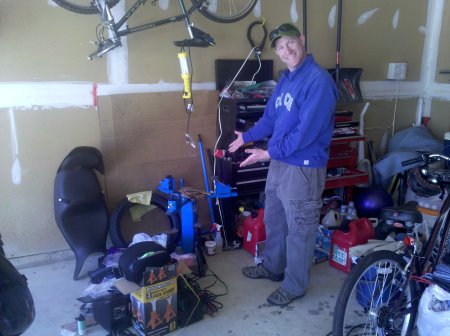
The tire changer needs to be mounted on the floor which was a concern of mine since I don't have enough spare room in my garage to permanently mount a tire changer. The solution Josh came up wtih seems to work very well.
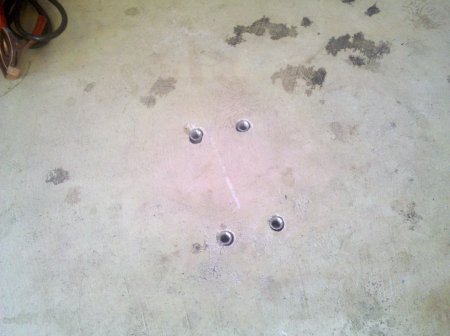
He drilled four oversized holes in the floor using, I think it was called, a hammer-drill with a concrete bit. He mentioned he destroyed the bit in the process. He then installed from threaded sleeves. I failed to ask him how he secured the sleeves in the hole. I will try to remember to ask him.
With this setup, it's a very straightforward process to mount the changer when one needs to work on tires.
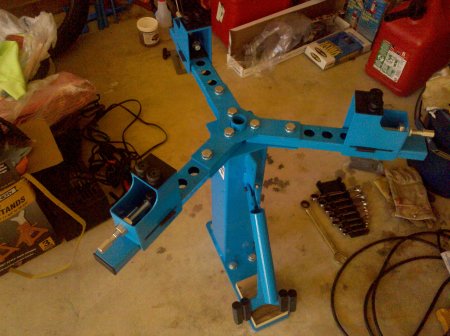
After removing the wheels from the bike, the first step is to remove the valve and let out the air in the tire. Josh chose to remove the valve directly. Please wear safety googles! The air pressure can cause the stem to shoot out. When I do this process here, I'll depress the valve and let the air out first before removing the valve.
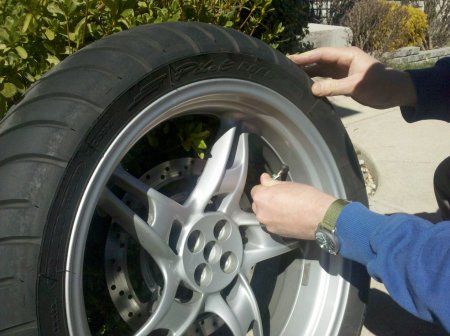
To remove the valve you need a little tool you can get at the auto-parts store, a valve remover.
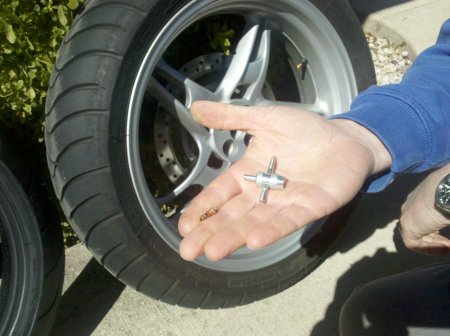
Once mounted the tire makes a hard seal on the rim. It forms a "bead" on the rim. The bead must be "broken" to remove the tire from the rim. It requires a somewhat brutal application of force. The wheel with the deflated tire is placed under the bead breaker.
A word to the wise, this entire job goes MUCH more easily if the tires are warm. Josh left both the wheels and new tires in the sun for quite some time. I will probably use my blast furnance to heat up the tires to make them more pliable. I doubt that one additional heat cycle from this will make much difference but I'll have to do some checking.
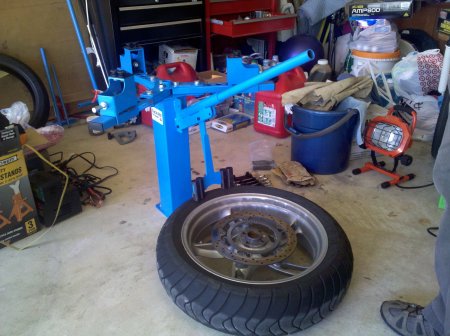
It's important to note, while it's not depicted in this photo that if the wheel has brake disks on both sides it needs to be raised up off the ground with a 2x4 or something similar so that when you apply force with the bead breaker you do not transmit any of that force onto the brake disk.
It's just a matter of lining up the tool and applying lots of force.
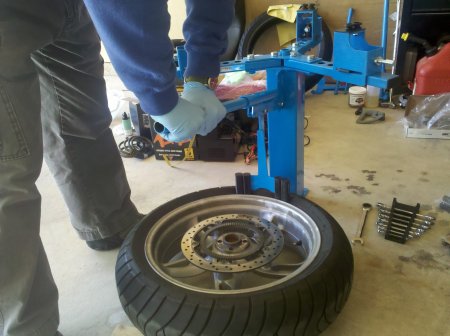
The rubber of the tire will contort. I haven't researched it but my understanding is that if the tires aren't too old one can mount and unmount them like this without ill-effect. Looking at how the tire deforms when this occurs it makes one wonder.
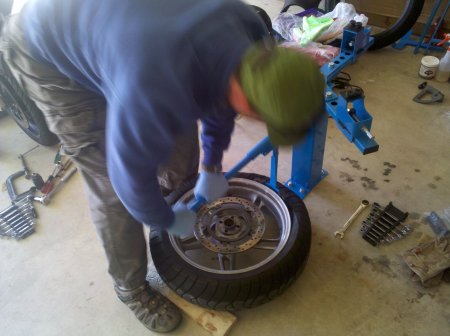
You have to work your way around the tire on both sides to make sure the bead is broken all the way around.
Once the bead is broken the tire is mounted to the changer. There are rollers that line up on the rim to hold it into place. These get tightened down good and tight as they are the only thing holding the wheel in place as you try to remove and reinstall the tire.
We had quite a bit of trouble with the wheel wanting to spin around while working on it.
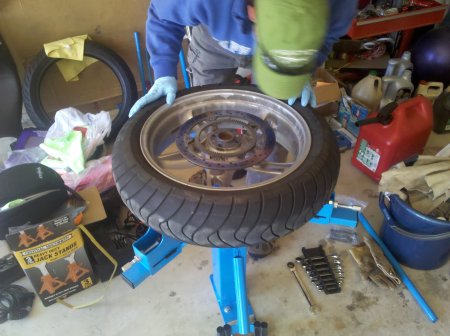
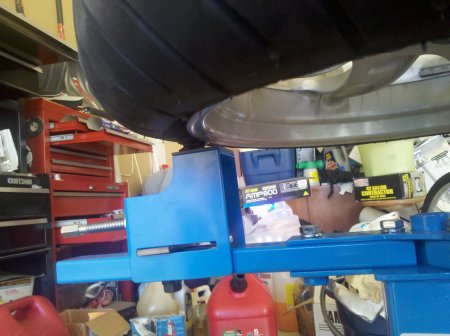
You can see how the rollers, center, fit onto the rim.
And, as Josh will not let you forget, many things are much easier when properly lubricated.
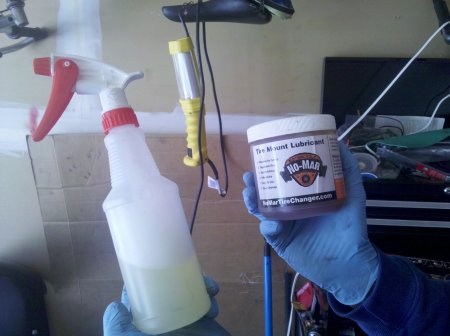
The changer comes with a lubricant that makes getting the bead edge of the tire over the rim much easier. You use it in two forms. One as a spray on liquid and the other as a grease.
First you spray the bead edge.
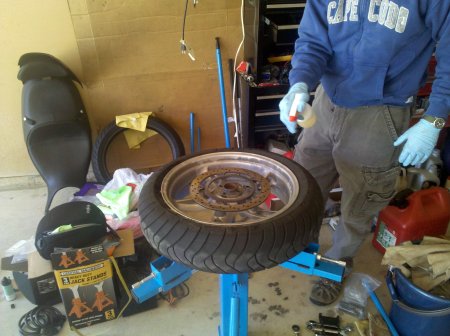
Then you use a clamp to push the bead edge of the tire down to make it easier to get the de-mounting tool under the lip.
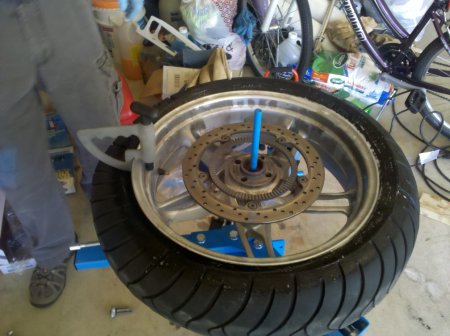
Working with the de-mounting bar is by far the most challenging part of the job. It has a hook on the end. You shove the tool between the rim edge and the tire bead edge, turn the tool 90 degrees and try to pull the bead over the edge of the rim. The tip of the de-mount tool seemed a bit fragile for the job. My impression is that given the force exerted on it that it might break. Maybe that is why they provide a second one with the changer.
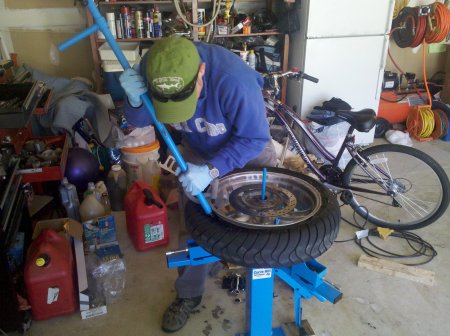
Once you get the de-mount tool in and the first section of the bead over the rim you forcefully pull the de-mount tool around the perimeter of the rim. The wheel kept wanting to turn when we did this.
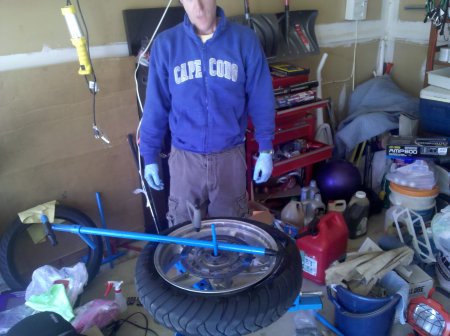
This took us a bit of time and was without a doubt a two person job. Read: Pain in the ass but entirely doable.

Once we had the first bead off the rim the next one pulled off without much troube.
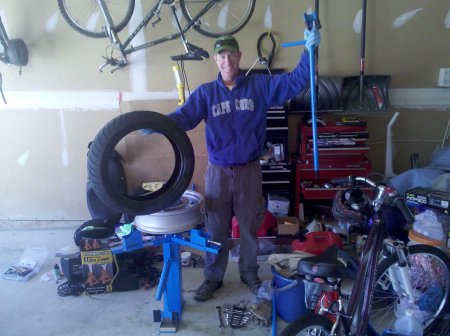
"Honey, look, see what I killed? ", the triumphant hunter exclaims. His wife and daughter did not seem impressed.
While the rim is off it should be cleaned.
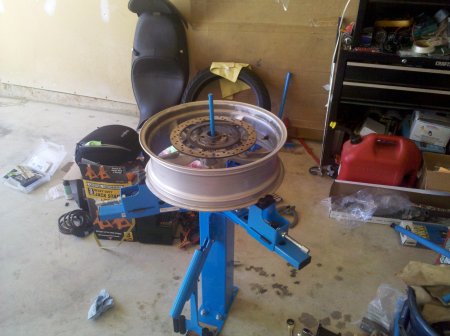
And then in order to make the job go much more smoothly the rim should be lubricated with the goop.
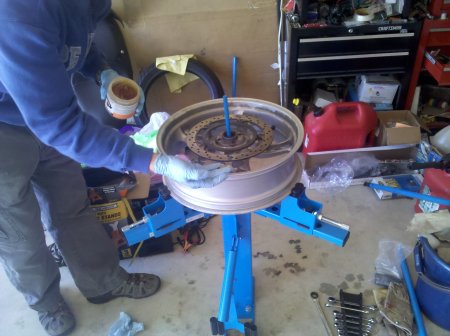
In addition, the inside bead edge of the new tires should have goop applied to it liberally.
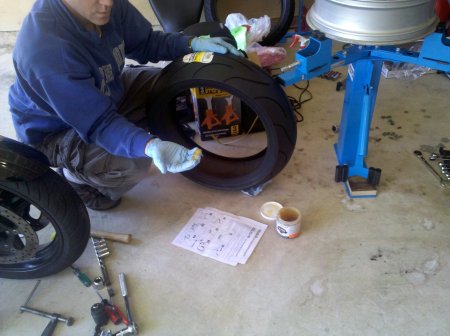
Then comes the second difficult part of the job. The mount tool looks like the demount tool except it two tips separated by a few inches. The process is pretty much the reverse of the de-mount. You shove the tool in grabbing the lip of the rim and then you attempt to force the tool around pushing the bead edge of the tire over the lip of the rim. This was also a pain in the ass. The last section required quite a bit of force.
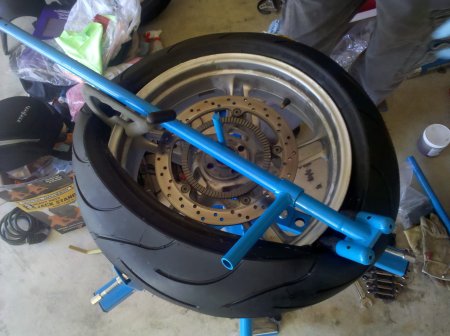
But once you get the hang of it it becomes much easier.
Tada!
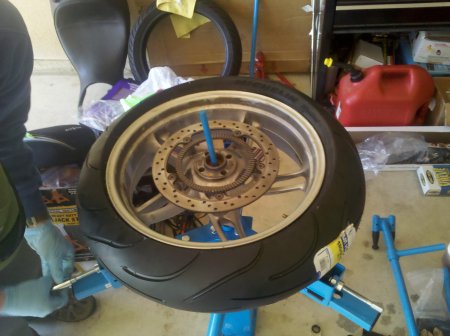
The bead edge of the tire was pushed in in places. To get it to "pop" out and make a good seal against the rim we used a compressor and while applying air bounced the wheel on the tire a bit. Eventually with two distinct pops the tire snapped into place and started accepting air.
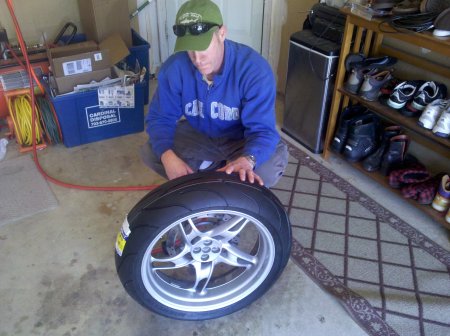
Tire mounted. But before the wheel can be re-installed on the bike the wheel must first be balanced.
Tires and wheels are not perfectly uniform in density. As a result, there tends to be a heavy side and a light side. If this discrepency in weight is not accounted for the wheel will shake violently as you ride. Imagine a laundry machine with an unbalanced load and you see the the problem.
So the idea is you attach weights to offset the imbalance to bring the wheel back into balance. For this you need a "Wheel Balancer". The one Josh got is Marc Parners Balancer for BMW's (BML). There's not much to it. It's a rod, some cones and two bases. The idea is you shove the rod through the center of the wheel, clamp down the cones on each side to support the wheel so it spins freely. You then slip on the bases and support the whole assembly on a couple of jack stands.
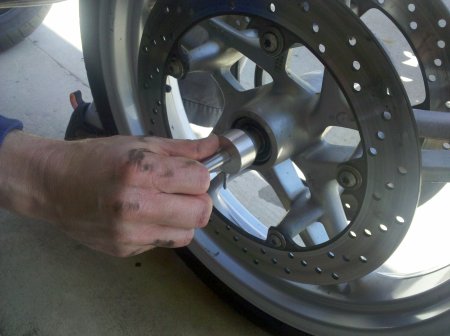
The cones are tightening with thumb screws. It should be noted that the thumb screws need to be on opposites side of the shaft so that the tool itself is not imbalanced. (i.e. thumb screw on the left side should face up and the one of the other side should face down.)
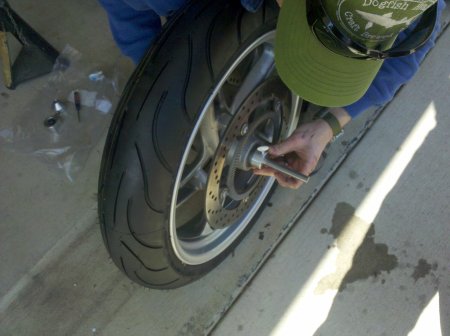
The the whole assembly is put onto jack stands. You have to make sure the cones are secure. If there's any slippage it affects how the wheel rotates and you won't get a good balance.
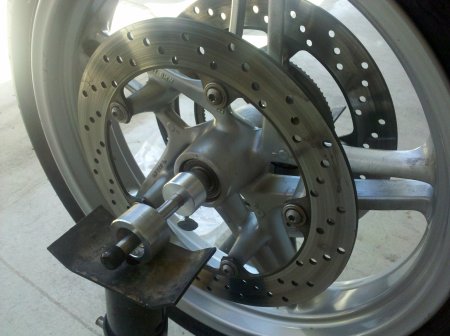
You then spin the wheel and watch it. If it spins then slows down and reverse direction the wheel is out of balance. You wait until it settles. This should mean the heavy spot on the wheel is at the bottom. You stick a weight on the top to compensate. You can see weights like this on your car wheels as well. If, as you're driving down the road you feel a shake, there's a good chance your wheels are out of balance. Sometimes weights fall off.

We repeated this process until the wheel simply stopped after spinning. It was remarkable how obvious it was.
I had run a timer during the process. To remove the tires and remount them took 54 minutes. Much of that time was spent explaining to me what was being done. Balancing took another 25 or so minutes. It may have taken another 30 to put the wheels on the bike. Based on this experience my feeling is that after a few times a bike could be done with two people in under two hours.
After thinking about it, I realized just taking the bike up to Bob's BMW to have the tires changed takes more time out of my life than this. I will be placing an order for the tire changer and balancer shortly.
Once we finished we took the bike out for a test run down the road where a buddy of mine crashed. "I don't like that road.", Josh commented. As I was snapping a photo, a train passed by. Pretty cool.
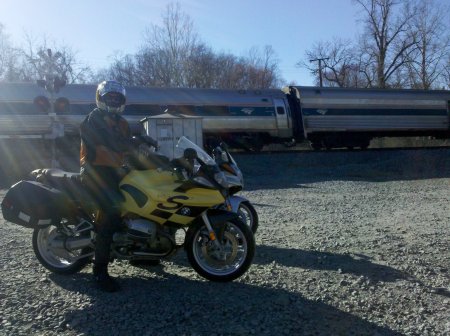
Josh had decided to try the Michelin Power Power 2CT tires which are a much softer compound tire than the Pilot Road 2's I've been running. After scuffing the tires in a bit he let me ride his R1100S on a twisty local road. Of course, his bike has Ohlin's shocks on it so any comparison to my R1100S bike is going to be questionable at best but I must say the new tires felt really good. I'm tempted to put them on my 'S as well. And despite the lack of income I am very tempted to slap some Ohlins shocks on my bike as well prior to Deal's Gap in May.
Now, as I mentioned above, this was my very first time doing a job like this. I am by no means an expert on the subject of tires and maybe not even motorcycles. I'm thinking I'll let loose the dogs of war and ask the super-knowledgeable guys from the BMW Tech list if they might give this artcle a once over to see if I am making any huge glaring errors.
If you liked this article, or any of the others I've written, please "like" Miles By Motorcycle on Facebook using the Facebook badge above or at the Miles By Motorcycle Facebook Page.
A few months ago, on a racetrack ...
It was the last track session of the last day. I was heading down the straight at something like 140mph, which is significantly slower than race speed but faster than my beloved Blue Bike can go, when my coach passed me and tapped his rear cowling to indicate I should follow him. This typically meant I had done something wrong, but not this time.
For nearly a decade, my refrain had remained the same. "No way, Ryan! There is nothing you can do, nothing you can say that will /EVER/ get me on a racetrack!". Each time, Ryan, who had raced for some years, would smile with a calm, patient, knowing demeanor as if to say, "It is your destiny. I have forseen it." I, to my credit, had an absolute resolve in my blind unwavering ignorance that would make even the staunchest Fox News believer green with envy. What would I learn on a racetrack, anyway? I'd probably get myself killed. Over the years I've talked to so many guys missing internal organs from being rear-ended on a track. My fear was that the kind of riders that I would share a racetrack with would be the kind of young reckless squids you see splitting lanes on the DC Beltway doing a buck twenty during rush hour. Even without that, I tried to imagine what it would be like to go really fast on a racetrack. I imagined a hectic twitchy "oh my god I nearly crashed there again" activity riding at the extremes of my ability. I figured the only reason racers were able to do it was that they just didn't have my sense of self-preservation; young kids taking crazy risks. Maybe they had faster reaction times. That's easy to believe. It seemed like something I wouldn't be any good at. Contrary to what some say, I'm not a fast rider. I'm really not. Ryan is much faster. "You'd be fast if you weren't so afraid." Phil used to say. Phil and his friend Geo are even faster than Ryan. I'm not. So I was immovable. Nothing Ryan could say would ever get me on a track.
Truth be told, I was afraid. So much about being on a track scared me, more than I think I've let on.
Then, one day, I made an error. I had read an article in Motorcyclists Magazine by a guy named Keith Code who is probably the most famous motorcycling race instructor in the world. His organization, the California Superbike School, has trained some of the top racers in the world. Keith had recently switched his school from using Kawasaki Ninja's to training on BMW's newly introduced S1000RR. With the introduction of the S1000RR, BMW had launched itself from being an old-mans go slow conservative brand to being the producer of one of the most sophisticated highly regarded sport bikes ever. This was the first real sport bike BMW had ever created and it was hit from the word go. A real BMW sport bike, something that at the time could walk away from every other production sport bike in the world while still being balanced and civilized? A BMW sport bike? That's just got to be tried, but not on a racetrack. Definitely not. What really started my downfall was Keith mentioned in his article that they had measured something like a 75% reduction in student accidents since switching to the S1000RR. This was due to its advanced traction control and engine management which essentially amounted to electronic training wheels. "Hmmm. That's really interesting." I thought and mentioned this on Facebook.
Error. I had not anticipated. Sonia, Ryan's wife, would see my post.
Then the email came.
"I saw your post. Ryan hasn't been on a track in ages. I want to send him to Keith Code's school for his birthday." she wrote.
"That sounds like an awesome idea! I think he'll have a blast." I replied.
"He's talked about getting you on a track forever. To make it really special, I want you to go with him." she responded evilly knowing I could not say no.
Shit.
During the Nightmare, Sonia was incredibly kind to me. She has never asked me for anything. How could I say no?
"ok", I wrote with a weight on my shoulder much like those that walk their last mile must feel. At no point did I consider that I might learn something truly valuable that went beyond motorcycling.
I resigned myself to my fate. I could just imagine those guys whizzing by me like I was standing still. Or maybe I would make a fool of myself. Or let Ryan down. Or be too slow. I just had no feeling for what I was getting myself into.
I read their signup page. "Students must have some riding experience -- we do not train first time riders." That didn't sound very serious. They didn't say anything about track experience required. I certainly have more than "some" riding experience. Yet, I was still uneasy.
As it turns out they conduct their courses all over the place including in this strange place called New Jersey.
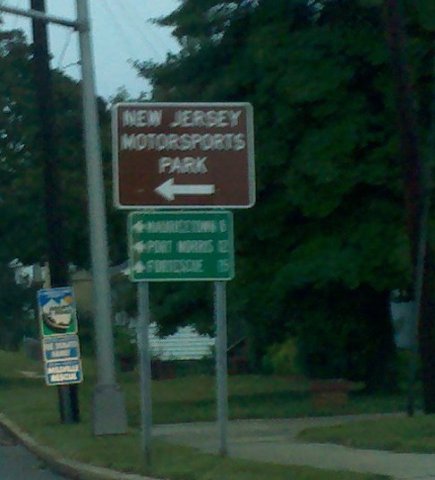
On September 6th, Ryan and I made our way up to the track. Ryan drove while I experimented with his EZ-pass. "If I put it on the dash ...", I mused. Nope. That didn't work. Another flash. "What if I hold it up here ...". Nope, that didn't work either. "How about if I do this ...". And so on. 'Sorry, Dude. I guess my experimenting is gonna cost some money." I confessed. "Don't worry about it. It's Sonia's." he replied with a smirk. Sorry Sonia. I hope the fines weren't too high.
Day 1
Morning arrived and we were at the track at a truly sadistic hour. The horror known as 7AM.
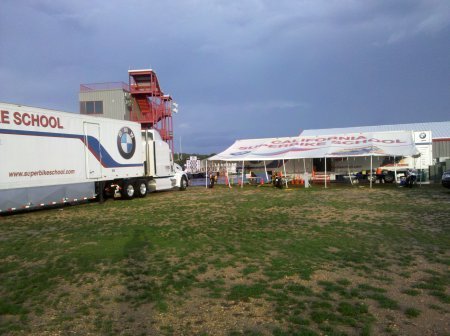
We came upon a pair of trailers prominently displaying the BMW and Superbike School logos. There was a staging area covered by a canopy. Breakfast was served in the trailer. They had a few items I could eat, some eggs and some fruit, and there was coffee, drinkable coffee. I tried my best to take in the scene but I confess I was honestly quite nervous.
And holy shit these guys could ride.
The school is run like a finely oiled machine with a sense of military discipline to it. There's always something happening. While those that know me realize I rarely notice much in the way of details, I did notice that there were more steel Rolex Submariners being worn by the instructors than I have ever seen in any one place. Some of these guys were former SEALS.
Each day was divided up into sessions. 20 minutes classroom sessions followed by so or so minutes on the track where students practiced a single topic. Students were assigned to coaches, 2 students to a coach. The coaches would ride on the track with us sometimes following, sometimes leading, often scolding, or so I thought. They were part instructor and part race cop. Ryan and I were paired up with coach Cobie, a great incredibly knowledgeable guy; and talk about grace in motion on a motorcycle.
There were corner workers with flags. There were people tending the fleet of bikes. There were managerial staff making announcements. There were people everywhere.
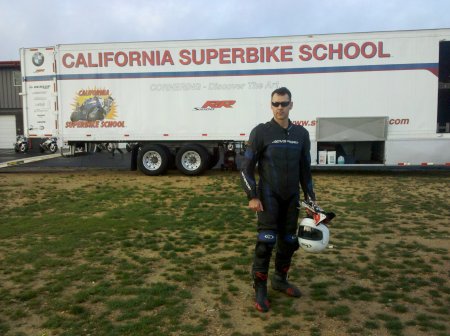
Then there's everything you have to remember. Was I supposed to study the track before I got there? "Turn 9? What do you mean Turn 9? How do you remember which turn is which? Black Flag? Checkered flag? Yellow Flag? Red Flag? What? When am I allowed to pass? How fast can I go? What's too slow? When I roll into the pit lane I have to raise my left hand to let riders know. If you get black flagged, which is bad, you're supposed to go into the pit lane as soon as you can. Black flag, bad. Pay attention and obey the coaches. Leave 10 feet between you and any other rider.", and so on. There were rules and they wanted you to follow them. They reserved the right to pull anyone off the track that didn't obey the rules. It seemed to me that it was really easy to run afoul of the rules and this added to my unease.
There's a whole backdrop to motorcycle racing culture that's fundamentally different from the sport touring or adventure touring world I'm familiar with. Simple concepts that are just part of the vocabulary or are assumed knowledge. I wish I had had a "street riders introduction to the culture of being on a track".
Ryan, on the other hand, was completely in his own element. And, it seemed to me, so were the other students. I felt like the odd man out. Would I make a fool of myself?
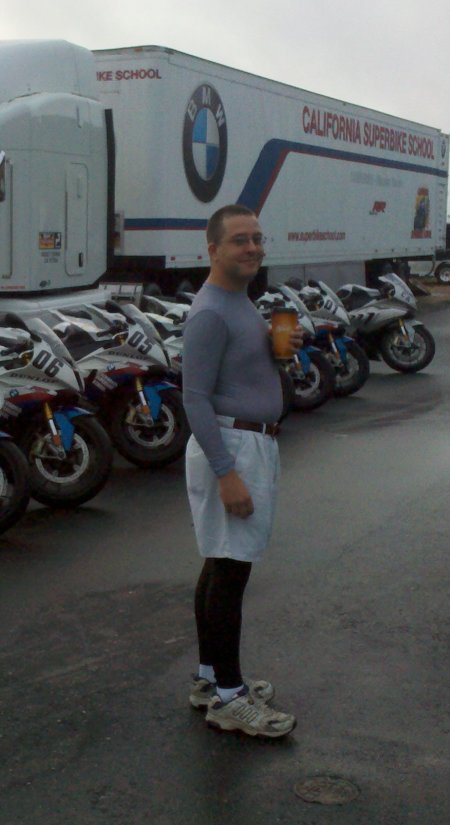
One piece suits are a pain to put on. I mean a real pain. Worse than the monkey dance you do putting on a rain suit. Experienced racers wear some type of slippery long johns under them to make it easier to get in and out of. I wish I had known.
We were assigned bikes. It was then a rush to get to the bike, get it fired up and go out to the starting position. Have I mentioned that I have not spent more than 15 minutes on a sport bike before? I had no sense of the throttle. Even in "rain-mode", this beast I was riding was incredibly powerful. The riding position was scrunched up, aggressive and at first uncomfortable as is to be expected on a bike like this. I fumbled to turn the key in my gloves and struggled to find the start button too distracted by trying to rush and follow the other riders. Pulling in the clutch I wondered how fast this thing was going to be. No sense of how much throttle it would need I gave it too little and creeped along tentatively. "Ummm. Where am I supposed to go?", I mused as I blindly followed the rider ahead of me. A staff member asks each rider before they are allowed on the track what the exercise of that session was. "Throttle Control", I responded mechanically.
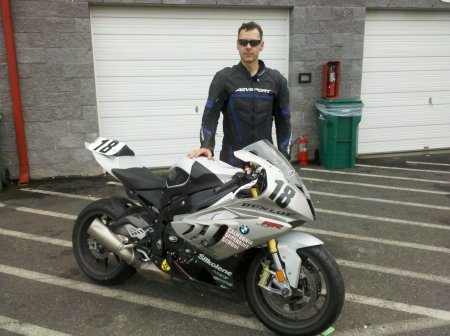
Oh, and I think I forgot to mention that WE WERE NOT ALLOWED TO USE THE BRAKES. "What??", I thought completely shocked. We were to remain in fourth gear and not use brakes at all in that first track session. My guess is to try to slow us down. Ummmm. I let the clutch out and tentatively rolled on the throttle out of the pit lane and up the hill to run two.
Remember how I said I had no experience with sport bikes? First, the thing is fast. Even in rain mode it feels faster than anything I've ever ridden. And then there's this thing called a slipper clutch that these bikes have. So there I am, the very first time on a track, coming up on my very first corner on a racetrack having no sense for the bike at all, how fast it is, how it responds and, mostly importantly, HOW IT DOESN'T SLOW DOWN LIKE MY BIKE DOES WHEN YOU LET OFF THE GAS! Needless to say, that first set of turns was a bit more than just inelegant. I didn't want to get sent home so I didn't touch the brakes. Not once. At one point my coach passed me, flagged me to stop with him and he dinged me for my riding. I was going into the first set of corners too fast. "Yea, I'm not familiar with these bikes. They don't slow down the way I'm used to." I thought but said nothing. He thought I was in danger of crashing. I already felt like I was in over my head. So much of my attention was being dominated by trying not to break any rules and do everything I was supposed to that there was little attention left for anything else. A lot of it was focused on worrying about the things I didn't know. My riding suffered and I fear that during those initial sessions that I came across as a significantly less capable than I actually am.
This compounded all my fears of doing something wrong, disappointing or looking like a fool.
I fear those first sessions gave my coach the wrong impression of my riding ability.
At one point, Ryan passed the coach and I too closely in a long left hand corner and got a serious talking to as a result. We were both afraid he was going to be pulled from the track. I became even more tentative as a result.
Those first sessions were rough. It seemed like I kept doing things wrong as if it was some existential confirmation of my being, of my being someone that did not belong here.
Time passed quickly. The second track session went a little better. We were allowed to use third and fourth gears but still no brakes. Progressively during the day I started being able to pay more attention to my surroundings.
The classroom sessions were extremely valuable. It didn't take long listening to Dylan Code speak to realize that I knew nothing about riding a motorcycle. He spoke in one session about tension. As many people know, I'm an easy going loose and nimble type. Yea, right. But they were making the point that if you were not relaxed on the bike it physically can't go as fast.
"Ummmm?", I thought as I pondered this being some new age mysticism applied to motorcycles.
He went on to share an anecodote as a lead-in.There's a thing that can happen on a motorcycle called a "tank slapper". The front wheel can become unstable and start oscillating back and forth violently. The period of the oscillation can increase to such a degree that the handlebars smack the tank left and right hence the name tank slapper. He described a racer who's name escapes me, get into a tank slapper. The racer held on for dear life only to be thrown from the bike. As soon as the rider was ejected, the bike stabilized and proceded to make it around the corner on it's own.
Then he went on to explain the mechanics of a motorcycle suspension and steering system. As it taverses bumps, the front suspension of the motorcycle is in constant motion. It's purpose is to keep the wheel in contact with the road surface regardless of what the surface is doing. As it does this, the wheel will tend to oscillate back and forth a bit over these bumps. It's normal. However, because of simple physics, if someone were to hold onto the handlebars too tightly, with too much tension, and prevent that normal oscillation from happening, the force that would normally cause the front wheel to oscillate gets transmitted through the tense rider to the seat and body of the motorcycle, and thereby the rear wheel. In a nutshell, grab the bar too tightly and the bike becomes less stable as it moves over the pavement. He went on to describe another racer who got into a tank slapper and apparently on the video they show him, at race speed, have such a presence of mind to literally let go of the handlebars which immediately caused the tank slapper to stop and he was able to continue on without crashing. Talk about controlling your fear. How fearless would that guy have to be to do that?
Yea, I know nothing.
He then went on to talk about loss of traction as it relates to tension.
I fear loss of traction. The idea of having both wheels on a motorcycle start to slide scares me like little else.
When you lose traction in a car, when it begins to slide, you have to make an active input to turn the wheel in the direction of the slide. Interestingly, and this is something I had never thought about, on a motorcycle if you begin to slide the front wheel automatically turns in the direction of the slide. So in contrast to a car, on a motorcycle, you gain control in a slide by doing nothing. And that nothing is more than just not make any changes, it means not holding on to the handlebars to such a degree that you're barely touching them letting the motorcycle do it's thing.
You gain control and speed, by doing less.
I found myself wondering if these guys are aware how incredibly philosophical they are.The more I listened the more these sessions began to sound ilke martial arts classes I took many ages ago.
I think it was the fourth session of the day I was told to do two laps then come in and switch bikes to the camera bike. They have this bike with a camera mounted on the back. You're supposed to do a couple of laps and then they review the video with you afterwards.
So off I went to do my two laps. My focus was on my riding, the corner workers, the other riders, my fear of doing things wrong, my fear of making a mistake, my fear of what I was doing, that I completely forgot that I was supposed to come in. On the third lap around, as I was coming down the straight I saw the black flag.
"FUCK! I forgot!", I literally said in my helmet as I rolled off the throttle as the pit lane disappeared behind me.
I was barely able to form the through, "Dammit." when coach was beside me shaking his head. He rolled out in front of me and tapped his cowling indicating I should follow.
I was in trouble.
He guided me off the track and we spoke.
I was sure that was going to be my last ride of the day. I had forgotten to do something I had been told to do.
"Don't roll off the throttle suddenly when you get flagged! I almost rear ended you.", he explained.
"Dammit. Sorry. I saw I was black flagged and thought I was in trouble. I thought I was supposed to go into the pit lane immediately. I didn't know but I should have.", I apologized profusely.
"If you get flagged and can't make the pit lane just go around again and then come in when it's clear." he said.
I didn't know. It makes sense but I wasn't told, or if I was, I missed it.
The thing I feared the most I almost caused.
Now I was bonafidedly terrified. But I wasn't asked to sit out. Sent to the camera bike, I did a lap. My lack of confidence and tentativeness was evident in the video.
One of the most interesting things told to us during a classroom session was about cornering. Cornering is the most difficult challenging thing to do on a motorcycle. Anyone can go fast in a straight line and stop again. But cornering, leaning the bike over and negotiating a turn, is an art that occupies most of a motorcyclists career. Even top racers continue to practice cornering.Cornering is the majority of riding a motorcycle. Watch top racers and you'll see cornering in the absolute extreme. You have to have nerves of steel to go around a corner that fast, no? They choose methods of traversing corners so that when they exit the corner they are set up optimally to enter the next one.
"We are not here to get inside your head." Dylan would say.
"If you're not where you want to be at the exit of a turn, don't think in terms of what you didn't do. It's not useful to say 'I didn't brake early enough', 'I didn't go in fast enough', because these things do not point to something concrete and active you can change. Focus on the concrete active things you did entering and during the turn that yielded the result you got. You adjusted the throttle. You applied the brake. You turned the handlebars. These are the only active inputs you can make to a motorcycle. The only difference between you and top racers in the world is 'what you do'. So step backwards one step at a time and adjust the active things you did until you get the result you want. We are not here to get inside your head."
And then it hit me.
It's amazing the power words can have and how quickly we can forget hard fought lessons we've learned elsewhere. I had been making the same mistake here on this track that I had seen so many guys make out on the Haul Road. They rode the road on their own terms. They didn't give it the time or attention it needed. Overwhelmingly their focus wasn't where it needed to be, on the here and now, because they were too concerned about external things, things outside of themselves, the business partner or wife, the deadlines, the job back home, all these thoughts that pulled them out of the moment and away from the road.
And they crashed by the dozens.
And here I was making absolutely the same mistake on a race track. I was not willing to fail. I was not present. I was not focused. I wasn't in that calm inner place where I could, if I needed to, simply walk away. Stop at any moment and turn around. It was that state that let me ride on a much more dangerous road under much worse conditions far far away from any help and call it easy. But here I was, in a much safer environment, being less confident and more likely to cause an accident because of all these thoughts and feelings of what I thought it meant to be on a track.
And all this did was pull me away from the simple mechanical task of negotiating corners.
"It's not about you. It's not about your history. Your problems at home. Your thoughts about who you are or what you have been through. It's not about how good or bad a rider you are. It's simply a question of, if you are not getting the results you decide you want, looking at the active things you do that yielded the result you got and adjusting the things you do until you get the result you want."
Events happen. How we interpret those events is so powerfully colored by the emotional context we are in. I was guilty of that because I felt all these things that had nothing to do with being on a track. My coach would tell me something and I would not hear him clearly because too much of my attention was focused on all these internal thoughts about what I thought about my own being.
The effect was as interesting as it was powerful. With these simple words, and the insight it produced, my focus adjusted. It was no longer about me. It was no longer about what anyone thought or my nameless fear. It was simply about experimenting and adjusting positive actions I took to get the results that I wanted to achieve and for the most part, on a track, it's nice and simple. Leave the corner travelling as fast as possible and be set up for the next corner.
But my sense is that this view, this way of looking at results as the direct consequence of positive actions as opposed to the result of some existential state that follows us around like a black cloud, applies in many more areas of life than just on a motorcycle going around in circles on a racetrack.
There is something about the motorcycle that brings out the philosophical.
Out on the track, this new perspective freed me to simply, dispassionately, ride the track. And I began to step back from my own toxic beliefs about what it all meant and trust that my coach was there to tell me how I could improve.
Early on, because I was so tentative, I had projected a lack of confidence to him that I'm sure made him concerned that I might try to ride beyond my ability. I also began to understand that my job as a student was to convey to him a sense of confidence that I was trying to learn what I was supposed to and that I would, at no time, ride beyond my ability. Simply ride the track.
Things started improving almost instantaneously. I was on a racetrack on one of the most powerful sport bikes in the world and finally I was starting to feel at ease. It's just another road.
During a break between sessions, I overheard that a guy had been pulled off the track for being "wreckless". He was sitting out a session. What surprised me about this was that I don't remember him passing me. Then again, I don't remember many people passing me except the instructors and Ryan.
At one point, a guy on a black bike whizzed by. He wasn't an instructor so I figured he was in the class. If he, a level I guy, can do it then surely I can. So I decided to keep up with him. I followed his lines. He was moving at a really good clip. Things were started to get fun.
Later on I would learn, at dinner, that the guy who's name I have forgotten, was in the level IV course and had been racing for decades. Oops. He seemed surprised that I kept up with him.
He was 63 years. 63. Very Cool. I hope in 20 years that I am still riding motorcycles.
I didn't get dinged again.
The first day ended. Ryan and I stayed at a hotel in town. Had dinner with the level IV guy then went to have a drink at a weird little local bar. New Jersey is a strange place filled with strange people. Even strange bartenders.
The night ended early and we were up and at the track at the horror of '7AM' the next day.
Day 2.
Level II is primarily concerned with vision and memory.
The classroom sessions went from discussions of the physics of the motorcycle to discussions of the evolutionary disadvantage human beings have. We are not evolved to ride motorcycles and it largely has to do with how our visual system evolved. If we had the eyes of a hawk, we would probably be able to ride much faster.
I had always thought racing motorcycles was a twitchy reaction-time dominated activity reminiscient of those times that I've ridden close to the edge my ability.
"To go fast you must go slow", Ryan would always say, but I never really understood what that meant.
It takes something like .35 seconds for photons to bounce off a target, have it enter your eyeball, get converted to nerve impulses, get transmitted up to your brain and then interpreted into an understanding you can begin to use as a the basis for a decision.
.35 seconds. If you are doing 100mph on a motorcycle and you look straight down at the pavement, what you are seeing is 51 feet behind you because of this delay. You are looking into the past. It also feels like you are going much faster than you are. What you decide to look at and how you decide to look has an incredible effect on slowing the scene. This is one of the reasons that people slow down when crossing bridges and going into tunnels. Because of the guardrails or tunnel walls the feeling of speed increases without any change in actual velocity.
As you run around a racetrack there are things to look at. You come up on a corner and you must decide where and when to let off the gas, apply the brake, turn into the corner. How you decide to do these things depends on the reference points you have decided to use. There are features on a racetrack, skid marks, repair patches, discolorations that you can use as reference points to help you remember what you did the last time around that corner and what you would like to change. For instance, at the end of turn 9a which is a long right hander where it turns into damn near a 90degree right they taped an X onto the pavement. That was the hardest corner for me to get right so I would experiment with that marker. Turn in before or after it. Maybe try to the left or right and I would try to remember how it felt, what position I was in. It took me forever to come up with a way of negotiating that corner that felt right.
But what happens on a track is that without some forced discipline you look at what you are afraid of. This happens on the road and even in a car. I would focus on that damned X in the road because that was my most difficult corner and the closer I got to it the faster I would seem to be going. I would slow down too much. The scene reduced down to nothing but that X and I would be squirrely around the corner.
Target fixation. We look at what we are afraid of instead of looking where we would like to be going.
They talked to us about peripheral vision and training yourself to take in the whole scene without moving your eyes. Remember the .35seconds delay? When your eyes twitch from target to target on a track there's a moment you can't really see as your eyes are moving. Go at 200mph and you've travelled over 100 feet during that time.
Scary.
The top riders focus a huge amount of effort training their vision, deciding what do look at, so they can get their mind to slow down. And beyond that they slow down their activity. They plan ahead for motions. On the straight there's nothing to do but wait until you reach your reference point to start slowing down. Then there's nothing to do until you reach the reference point to start your turn. Once leaned over, again, nothing to do. It's not twitchy in the least. It's slow. Action. Rest. Action. Rest. Do less. Move slowly. Decide what to look at and how.
"Do you believe that my being stronger or faster has anything to do with my muscles in this place?" to quote Lawrence Fishburne, one of my favorite actors, in my favorite movie, The Matrix.
At race speeds, because of visual system delays, even those with the fastest reactions times are no competition for those who have learned to slow the scene down. The less we fixate on what we fear the slower the scene moves the greater our ability to negotiate past it and achieve the results we want.
We focus on what we are afraid of. Again, I wonder if these guys know how philosphical they are? It's so easy to see this same effect in other aspects of life. The more attention, time and energy we spend focused on what we are afraid of, the things we do not want, the less there is to negotiate a path to avoid it.The more energy we waste in times when we should be resting, the less we have when we need it.
I continue to ask the question "what is it that I am able to do on a motorcycle that I am not able to do in other aspects of my life" and continue to be surprised.
The class sessions continued. They began to talk about how motorcycle racing is a 90% mental game. I've heard this said of so many sports but have never had anyone go into detail about it.
Another thing that separates top racers from everyone else is memory. Dylan shared an anecdote about how many details top racers can remember after having ridden around a new track just once. Every relevant skid mark, crack, discoloration, details about the camber of the pavement, etc. etc. And not only can they remember these places they can also remember exactly how long the interval is between those places. Once someone has a set of reference points they can then use them as decision points. Coming into turn 9b I scan over the X standing the bike up looking where I want to go but missing the X two feet to the right, or some such. I can only remember turn 9b in any detail now. Top racers can do that for every part of a track. Sick.
Racing motorcycles is nothing that I believed it was.
During a break a group of riders were talking. "I'm gonna have to make this up to my wife." one said while two others nodded in agreement.
"HIs wife sent him here." I said pointing to Ryan.
There was a moment of awe struck silence which yielded to envy.
In the next track session, I took the camera bike out again and this time a coach reviewed it with me. Despite knowing that I'm not supposed to put weight on the handlebars I was still clearly gripping too tightly and my body position was all wrong.
It was a disheartening realization.
So off to the lean bike they sent me.They have this bike outfit with elaborate training wheels so that while going slowly you can be coached on body position while negotiating corners.
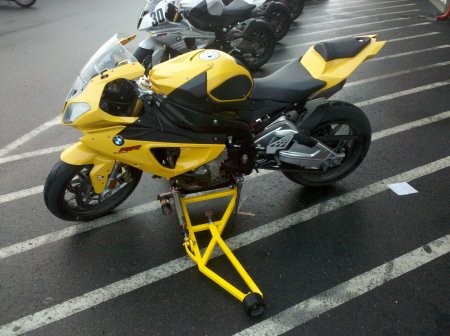
Unfortunately, because it was wet, I wasn't able to ride it. So a group of coaches stood around while I sat on the thing in lean position. They critiqued and moved me around until the position they had me in was half leaned off the bike, ball of my right foot on the peg, calf muscles extended forcing my knee into the ledge of the gas tank on the grip pad. All of my weight being supported by the right leg, knee and my torso so that I could let go of the handle bars completely. Left knee hung out slightly.
It hurt.
It hurt bad.
Clearly these were muscles I had not used before.
It made me look like a frog.
But I got the message loud and clear.
For years I've been having problems with a muscle around my right shoulder blade locking up on me when I ride. When I came back from my trip my arms were built, but not my stomach or legs.
I've been using the wrong muscles all these years. I'd been gripping the bars too tightly all this time. There's an interesting difference between knowing something conceptually and then knowing what it's supposed to feel like.
Out onto the track I went with this new insight. It had been raining so the track was wet.
It took me a lap or two of experimentation to finally nail it. My muscles just weren't trained yet. But when I nailed it, when I got my body off the bike , my leg locked into the tank and my hands so light on the handlebars that I was barely touching them magic happened. The feeling is incedible. There's this stability I had not previously known. I was running around the track. I finally nailed turned 9a and 9b. I managed to not fixate on the target but instead look to the next reference point. I flipped the bike over into turn 10 which is a long left hander. Two bikes were on the inside track in front of me. There was more than 10 feet to the right. "Hell with this", I thought as I leaned off slightly more and rolled on the gas a bit more passing the two riders on the outside. Open throttle as I came into the last turn onto the straight. I relaxed. Turn 1 came up quick. Off gas, reference point acquired. Look to the apex seeing the turn point in my peripheral vision.
Off I went. A number of turns were quite wet. Some had tar snakes, which are exceptionally slippery repairs in the pavement. Arounds these corners I went in the wet.
The bike lost traction and skipped over so slightly to the right. Both wheels. I did nothing. Not only that, it didn't phase me in the least. At no point did I feel like I was out of control.
Onward I continued. Another wet corner. Another slight lateral slide. Maybe it was 4 inches but it felt like a mile. Again I did nothing.
My coach passed me and pulled me aside.
"Did I do something wrong?" I asked expecting to be told to slow down.
"Can you feel around turn 7 how the bike skips a little bit?" he asked.
"Yea, I'm keeping loose on the handlebars and it's working out well for me." I replied. "Do you want me to slow down?"
To my surprise he said, "No, I just wanted to make sure you knew how close you were. In these conditions I would not want to go more than 5% faster myself."
"Yea, I'm not going to go any faster." I replied.
Wow.
Ok. So back onto the track I went.
By the next session, it had dried up a bit. My coach passed me and instead of slowing me down we bumped the speed up 5%. I kept up and at no time did I feel like I was going all that fast nor did I feel scared in the least. I was having a blast.
We pulled into the pit lane for the debrief. We had one more track session left.
"You've really picked up your pace quite a bit." he said somewhat surprised.
"I'm finally feeling pretty comfortable. Can we do that again?" I asked like an excited little kid, "but a bit faster?"
It was the last track session of the last day. I was heading down the straight at something like 140mph when my coach passed me again and tapped his rear cowling to indicate I should follow him. This time it didn't mean I had done something wrong. He slowed down for a second and then took off. And I followed. I followed his line, trying to apply everything I had been taught. I did more corners correctly than not. Sometimes I would miss a line or a turn but I kept up. He would look back from time to time and it was as if I could see the surprise on his face. Each time he would would pick up the pace incrementally. The way this guy could ride was grace in motion.
We came upon turn 9a, that long right hander. There was a bike to the extreme outside. As we passed him on the inside, I watched my coach lean his body off his bike for the first time, ever so slightly. And suddenly he started pulling away in earnest.
And I followed. That bitch of a right hander in turn 9b came up and i nailed it and staying right behind him. Flipping the bikes over left we took the outside track through turn 10 passing another couple bikes. We were moving.
The session ended as quickly as it began. We pulled back to the staging area. He pulled his helmet off with a big grin.
"Now that was fun." he said which I took as an incredible compliment.
Yes. It was. And I can't wait to go do it again.
The class was over. It was time to hand in our suits and head for home.
It would take me some months to understand how much this class changed me as a rider. Nothing I have done in years has been as eye opening and dramatic as those two days spent at Keith Code's California Superbike School.
I've been tormenting people with race school life analogies ever since.
If I were to do it over, I would have gotten a book on basic track ettiquette, if such a thing exists or I would have gone to talk to some more racers. I would have also gotten a printout of the track with turn numbers labelled. I would have also test ridden an S1000RR so I could familiarize myself with the bike and maybe asked for more details about how the class activities flowed.
Without a doubt I will take levels III and IV and will be better prepared and out of my own head leaving my toxic fears behind.
If you are a sport oriented motorcyclist of any kind, after taking Total Control, I would highly recommend to anyone to take this sportbike school. It simply rocks.
It will change your riding, and maybe more, for the better.
Thank you, Sonia. Thank you, Ryan.
If you like this article please forward "like" the Miles-By-Motorcycle facebook page using the box above.
If you know anyone who might like to read what I write please pass it along.
Thanks.
It was a simple plan. Bruce would arrive on Friday. We would pack the bikes and then get up early on Saturday to collect Duncan. We would hit the road by 9AM intending to take a leisurely 550 mile ride to Deal's Gap. We would meet Josh somewhere on route 81 and then arrive at the Gap sometime in the middle of the day on Sunday so we could do a few runs.
Well, that was the plan.
Unfortunately, I've been having intermittent boughts of insomnia. I had been unable to sleep much either Wednesday or Thursday night and by Friday I was having trouble staying awake. So tired. I headed up to BWI to pick up Bruce who was flying in from Los Alamos to ride the guest bike. I understand the Innuit have something like 200 words for snow. I have a similar set for fatigue and pain. At this point, I was already stupid tired. Stupid tired, as the name implies, is when you're so tired that you're just stupid. Mixing being stupid tired and 550 miles on a motorcycle is a recipe for disaster.
We had dinner at the Outback, as is customary for a Friday, and then headed back to my house to pack the bikes and get everything ready. Because I had been so stupid tired the past few days I failed to get everything quite up to the standard I usually achieve. I wasn't able to wash the bikes or get the luggage set up, but Bruce took it all in stride. All in all everything went smoothly and we had the bikes packed pretty quickly.
I was convinced I'd be able to sleep given how stupid tired I was. It was not to be. After packing the bikes and getting everything ready we called it a night at midnight. By 2:30AM, I was still fully awake with a racing heart. I realized I wasn't going to fall asleep any time soon. There was just no way I was going to be safe on the road the next day so I made a command decision and sent out text messages to everyone to postpone the departure time to 12:30PM.
I finally managed to fall asleep around 5AM. Bruce didn't get the message and dutifully woke me up at 7:30 but I was able to fall back asleep fairly quickly. No harm no foul. I woke up again around 11. I was really tired but not in a dangerous way. We had intended to go to a diner for breakfast but it was crazy busy so we opted to head over to Duncan's house sans breakfast.
Duncan to his credit was pretty much ready to go. The weather forecast had changed. Exhibiting an abundance of experienced realism, Bruce put on his rainsuit but refused to do the mandatory Monkey Dance. I tried to catch it on video but it was not to be. He was entirely too dignified. Foiled once again!
I, of course, having my beloved Toxic Suit on, had no need to do the Monkey Dance and just watched. Shortly thereafter Duncan rolled out his packed bike and we were ready to leave. The sky threatened but we were unconcerned.
We asked a group who were out walking to take a quick photo of the three of us.
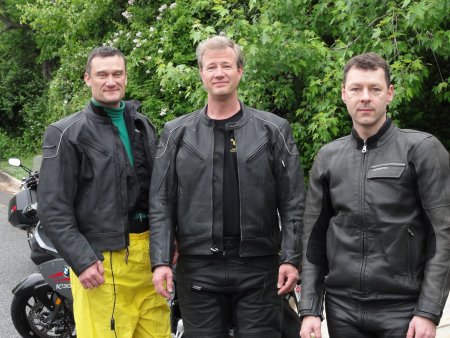
Last year's Deal's Gap trip was the first time the three of us had ridden together in nearly two decades. Crazy. Both Bruce and Duncan are great guys and they are like brothers to me. Family. They are the two biggest reasons I am still standing. They were there through everything; through every last step of the nightmare from the beginning all the way to the end 17 years later. No matter what happened or how bad it got, they never faltered. They were always there. I shudder at the thought of what my life might have become had I not met these two guys. No one has friends as good as I do.
That they would take time out of their lives and away from their significant responsibilities to family and jobs to go on some crazy adventure with me is a privilege I do not take lightly. That their wives would cover for them to take care of kids and households on their own is something I also do not take lightly at all.
I remember last year Bruce saying early on, "This is a lot of fun. Maybe I can swing a trip like this again in 5 years". Later that week it was "well, maybe in two years". By the end of the trip he was saying, "I'll be back next year!".
Duncan's progression was similar. Tragically Duncan broke his wrist in a fall a few months ago and it had not been clear that he would be able to go until the very last moment. His wrist still hurt but it was healed. We agreed that if it bothered him we would take extra breaks or potentially even stop the trip if it got too bad.
He needed to be back on Saturday before noon. No problem. Plans updated. We would leave on Friday for the return trip to arrive home on Saturday before noon. Of course our track record with plans ...
So around 12:30 we texted Josh to say we were underway, stopped at a gas station and then headed out. We rode about 100 miles in the first sitting. Traffic wasn't too bad. And because we are hard core, we stopped at a starbucks near Front Royal.
I was really tired and not feeling well at all. I texted Josh to let him know about our progress. Duncan did his mandatory silly stretches. You've heard of the Ministry of Silly Walks? Well, Duncan could be the Minister of Silly Stretches. We hung out at Starbucks for a bit pondering the changing weather forecast and headed on to Staunton where we had agreed to meet Josh.
Duncan and I met Josh last year prior to the last Deal's Gap trip at the Total Control course we took. After returning from Deadhorse, Josh and I took a short run down to the Gap in October. The original plan had been for a bunch of people to join us on this current trip. Unfortunately, things fell apart and almost everyone bailed. Doing a trip like this is a big deal and I can understand how life can get in the way.
After last years trips, we all agreed we needed more time down there. Unfortunately, Josh could only go for three days and needed to head back Wednesday.
We met Josh at a Shoney's. Josh rides a Yamaha FJR, a very big bike. It's his first. Josh has only been riding for two years and his riding is already on par with guys like us who have been riding for decades. Nuts. When mixing people who have never met one has to be careful. I'm very cautious about who I travel with. Styles matter. But I was convinced everyone would get along on this trip and as it turned out everyone got along wonderfully.
I was hungry having not had any breakfast. So I ordered myself an omelette times 2. They had a list of ingredients you could add. Not wanting to think I just asked them to add it all. Epic Omelette!
The cook came out to confirm that this is actually what I wanted. "Ain't never made an omelette that big before". The waittress, who was kind of cute, started teasing me about how there was no way I could finish it. "You do not know this man", Duncan told her. A few minutes later the omelette was gone and I was no longer quite as hungry.
At some point we started discussing what we were going to do, joking about the late start I had caused.
"So if we had a plan, what would it be?" Bruce asked. This became a refrain for the remainder of the trip. "Not that I suggest we should have a plan, but, you know, if we had one, what might it be?" Josh would joke.
We talked to the waittress for a while and listened to her tell stories involving too much alcohol and her ability to drink guys many times her weight under the table. It was all pretty funny. Eventually we decided the time had come to be gone.
"Do you think I should put on my rainsuit?" Josh asked.
"Yes", I replied.
A couple hours later when the rain started pouring down we stopped under a bridge for the rainsuit Monkey Dance.
I like this photo.
We rode for some hours well into the night. I had targeted Wytheville as a place to get a hotel. At a stop sometime before Wytheville Josh asked, "Do you think I can do without the electric vest?".
"No. I think you should put it on now." I replied.
A few hours later when it got cold, just pulled ahead and stopped at a gas station which was only something like 30 miles from Wytheville.
"I'm freezing. I'm going to put on the vest." he stated as if having discovered a new truth in the universe.
"Do you think we should get gas now?" Bruce asked.
So we got gas and Josh donned his electric vest and we were on our way to Wytheville. The rain was really coming down pretty hard in places. It had been a nasty ride. The intent was to find a hotel with a hottub which we found but we arrived too late. The hotel staff was really nice and let us park our bikes in the handicapped spot partially under the awning.
There was an Applebees about a quarter mile away so we decided to stroll over there. I was exhausted and feeling worse but the walk did me some good. The service there was terrible and it took forever. It was the same Applebees that Ian and I had eaten at some years earlier on a previous Deal's Gap trip.
I actually managed to sleep but only fitfully. The phone rang far too early. It was Josh telling me I had 50 minutes to get up and out before checkout time. We packed up our gear and rolled the bikes over to a Waffle House where I had the customary omelette and terrible coffee. We still had several hours of riding to go and things take a lot longer with a group of 4 than it does with 3 or 2. It's just the nature of motorcycle travel.
We rode south along 81. At one point we came across a swath of incredible devastation. A huge tornado had cut through trees and shattered buildings. I've seen images of this kind of damage before but never seen it up close like this to this degree. If I had been on my own I would have done a panic stop on the side of the road to take photos but with three guys following there was just no way. Route 81 has a huge amount of traffic on it and there's no way to make a stop like that safely. So I passed it up. Awesome devastation. Trees snapped halfway up like twigs. One house completely smashed, the one right next to it unphased. Frightening.
We came upon Knoxville and took the exit for 129. It had been some years since I had ridden out this way and I had forgotten what kind of establishments were along the road. I had thought there were a bunch of restaurants but didn't see any after more miles than I remembered. Josh and I both attempted to use our lying GPS's to find a place to eat and that then turned into an hour plus wild goose chase, our bitch GPS's lying to us repeatedly. Eventually, we found our way back to downtown Knoxville and found a grill where we could sit outside. We got parking a ways down the street just out of visual range. I pull my tank bag, grabbed my helmet and walked over to the restaurant to secure a table.
It was a surprisingly nice restaurant with a view down the street to the bikes.
The waiter was nice enough to take a photo of the four of us.
As we sat there we pondered how far South we were. What kind of people inhabit these parts? Are there perhaps any warning signs around us that we should pay attention to? Then Josh pointed out a disturbing sign:

No lunch is complete without a trip to starbucks. We headed to one to get our last cup of good coffee for a while.
This was a recurring theme. "I don't think it'll rain." Duncan would say. Josh would ask, "Do you think I should put on my rainsuit?". Bruce, ready to go helment and rainsuit on would sit patiently. I had given up attempting to give sage advice and merely looked in their direction and then at the sky. Josh got the hint and started putting his rainsuit on. Duncan followed suit with a few issues having to do with the order of things. You put the earplugs in first, then put on the helment then the gloves. It's amazing how many permutations and combinations of these three steps result in "Dangit! I forgot to ...".
Bruce waited patiently. I declared that I was revoking the democracy and it would now be a dictatorship with me as dictator. "King", one of them replied.
Route 129 out to Deal's Gap is a wonderful road. Sharp corners across a very lush and green countryside punctuated by stands of trees followed by open fields. It's a beautiful road, that is once you get to the two lane portion. The four lane portion sucks and the left hand where route 411 and 129 diverge sneaks up on you.
"If you're going to be King, Yermo, we require two things", Josh stated. "You must navigate without missing major turns, like let's say, the road we have ridden all this way to ride". I have forgotten what the second condition was.
It is good to be King.
The sun was setting as we headed into Deal's Gap, also known as the Dragon. Despite not feeling well, fatigue from not sleeping and a fully loaded bike, running the Gap was fun. The new suspension I have set up on my Blue Bike makes it a different beast. They said it would be better. They failed to tell me that it would completely change the bike. That was fun.
We arrived just after 7PM and got to our "apartment" suite, #2. The neighbors were friendly.
They were pulling our chain about riding BMW's. There was some comment about electric vests. "You should see his espresso maker." one of my crew replied. That got a good laugh.
We unpacked the bikes and got settled into our apartment suite. The Deal's Gap Motorcycle Resort is basically a motel with a gas station, fast food grill, campground and souvenier shop. Everything is geared towards motorcyclists. You park your bikes right in front of the room. There are benches outside so you can watch the mayhem unfolding in the parking lot. It has the added benefit that you immediately get to know your neighbors. They call it a resort because of the liquor laws in that county. A resort has to have a tennis court or swimming pool and then it's allowed to serve alcohol. So the Deals' Gap Motorcycle Resort has two unused tennis courts hidden somewhere.
Despite being wet, tired, and ill, I got on my machine and ran through the 11 miles out and 11 miles back through 636 challenging turns. Awesome. When I got back, Bruce handed me a shot of scotch and we stayed up fairly late talking. The rain had started again so there would be no fire in the firepit that evening. The accommodations are spartan but I like them. Cinderblock walls, cots, metal racks. What's not to like? It does kind of resemble what I imagine prison is like.
I couldn't sleep again and spent the evening in significant pain. Something I had eaten the previous day really disagreed with me. Monday is largely a blur to me. I was worthless tired. Bruce, Duncan and Josh headed out for a ride to Maryville. Given how I was feeling I opted to stay behind. It started raining in earnest again just after they left. I got a few cups of coffee and sat on the bench and watched the rain for most of the day.
In the background is the Tree of Shame. "No Gain and a lot of Pain". The tradition is to take any parts that have broken off your bike when you wreck and put them up on the tree. Everyone commented on how much it had expanded since the last time we were here.
I started feeling much worse. I was grateful for having a bathroom at my disposal. Unpleasant times. But it always seems like I suffer when I travel.
I decided to walk around for a while thinking that maybe it would help me feel better. I snapped a few photos and I strolled around. This is what the resort looks like. The beginning on the Deal's Gap Run is on the left and leads up the hill.
Motorcycle Mecca. It doesn't matter. Right is very good. Left isn't bad either.
I walked back and sat on the bench watching the goings on. After a while I noticed a sight I had not seen before. Another BMW K100RS rolled down the hill. I looked over and decided to be social. The rider's name was Joel.
Joel had been travelling with his dad, John, on a multi-week tour down the East Coast. Both of them rode 8V K100RS's. Awesome. As luck would have it they were staying in the room next to ours. I talked to them for a while about the modest improvements I've made to my bike. They were both particularly interested in the laminar lip I had installed on the fairing which significantly reduces buffeting. On my bike, BMW really did not do a very good job engineering the fairing. We affectionately call it the "turbulence generator". The buffeting is so bad that before finding out about the laminar lip, thanks to Duncan, I was considering getting rid of the bike.
We talked about suspensions and the Total Control course. We talked about the Gap and how to ride it safely. What impressed me about Joel was his interest in learning. He was cautious and interested and fundamentally not reckless. His dad would disagree but seemed really pleased that someone was there willing to take some time with his son. Personally, I got a real kick out of sharing what little I know with him. He really seemed to gain from it and it turned what had been a miserable day for me into one I'll remember in a positive light for a long time.
After some discussion, Joel asked if I could lead him through the Gap. He wanted to follow my lines. I touched base with his dad assuring him that I would not push his son in any way to ride beyond his ability. The Dragon, as Deals' Gap is called, can be a very dangerous road if not approached in the right way. There are 318 corners many of which decreasing radius multi-axis turns. Often, turns are hidden and seem to appear out of nowhere. You think you're doing a 30mph turn when suddenly it arcs sharply to the right and up a hill turning into a 10mph corner. To some degree to have to memorize the road. You also want to be very careful who you ride with. A very common way to crash on the Gap is trying to keep up with someone who is a better rider. It's easy to get caught up in appearances. If that old BMW guy riding that ancient machine can do it, I should be able to do it on my modern sport bike. Not necessarily. More importantly, it's not a given that another bike of the same make and model will be able to run the Dragon the same way. There's always that chance that there are hidden modifications. Joel rides an older K100RS. It has skinnier tires and his suspension was in dire need of some upgrades. My bike had fresh sticky tires and a completely redone suspension and brake system. Given comparable riders, my bike will run circles around the old K100.
So when you lead someone through the Dragon you need to assess their riding skill and comfort and adjust accordingly. Similarly if you follow someone and they are going faster than you feel comfortable with you slow down. Don't try to keep up. My group is really good about this. There's no ego involved. We're all here to learn, improve our riding and have some fun while doing it.
In many ways when you lead someone through the Dragon or even if you have a passenger on your bike, at that moment you are no longer riding for yourself. You're riding for the other person. In the case of a passenger it's very similar. There's some skill involved in being a good passenger. The bike leans and the body position of the passenger affects cornering. There's a ramp up time for someone who's never been on a bike before to get comfortable. I always try to introduce people gradually and carefully. Be cautious about getting on a bike with someone who doesn't take you into account. More often than not, especially for women, some guy will try to scare them. I hate that.
So I started out very slowly trying to get a feel for how Joel rode. As it turned out, he was a much more tentative rider than I expected. Almost too cautious. So we went through the entire gap mostly well under the speed limit. I had never run through the gap that slowly before and I found it quite tiring to keep looking in my rear view to make certain he was ok. I would stop every so many corners and touch base with him to see how he was doing. I'd give him pointers and critique his riding. He listened and attempted to apply everything I suggested. It was impressive how much he improved just running out and back again once. Interestingly, I found going through the gap like that beneficial as well. I found myself thinking about what an acquaintance had said she had been told. "Riding a bike is like playing an instrument. First you make sure you can play each note. Then you focus on putting them together, playing them faster and making music". Taking each corner slowly and focusing on my line, mostly to demonstrate how to enter the exit the corner to Joel, was great practice. I think it contributed to why I can run the Dragon much faster now. I'll do that again the next time I'm down there.
Bruce, Duncan and Josh returned. It had been pouring rain. They had run out to Maryville, about an hour away, gotten something to eat and bought some critical supplies.
The rains continued and we put an end to riding. It let us slightly later in the evening so I put some effort into building, what I considered at the time given the conditions, an impressive fire in the firepit. Hanging out around the firepit at night represent some of my best memories at the Gap. There are almost always interesting people to talk to from a variety of backgrounds.
Duncan had met Chad, on the left, who was in the other apartment room and rode an Aprilla. The running joke was, "Hey Chad, want to ride an R1100S? I could follow you on the Aprilla". Yea, he didn't buy it either. I didn't get a good photo of Josh's Dad, John. He's sitting on my left. I thought it was really impressive that he spent so much time with his son on a trip like this. He had recently gotten back into riding after a long hiatus. A good guy. I liked him.
We shared some of our booze with them. They said they were going to leave the next day. We tried our best to get them to stay and even offered to let them join us in the "Apartment Suite".
Bruce lost his "hoody", whatever that is, and was relegated to wearing his silly hat. I have gotten to spend far too little time with Bruce these last many years. Since Duncan's gotten his new job I don't seem him much either. It was very good to spend this time with my friends. My life is much better with my friends.
I've told many that my friends are virtually as polite as I am. Even when we're on our own and no one is there to listen, we so very rarely tell any off color joke or make any off color comments on any topic, especially when it comes to women. No one believes this, but it's true.
However, adding Josh into the mix added a "refreshing" level of wrongness, sometimes extreme wrongness that would get me to cringe.
Why is it that everyone enjoys buggin me so much?
Of course, we soon realized someone, Bruce, was taking pictures so we had to put on a serious front to keep up appearances.
When Josh is there topics go in directions that they don't normally. I think Bruce and Duncan have both long since given up on me in terms of relationships. They've seen first hand how miserable every single relationship I've been in has made me. I get too caught up in obligation, I guess. Then again I haven't been in a relationship "post-nightmare". Maybe things would be different. But they seem to understand that it's probably better this way. As is my lot in life, those precious few women that I could probably be happy with I can't be with for one reason or another. As Zathras from the Babylon 5 series said, "Is very sad life, will probably have very sad death, but at least there is symetry."
It's funny. I had always thought I would get all kinds of pressure from women, but it's actually been my male friends who are far more concerned that I'm single. Come to think of it, I get more comments from my male friends than I do even from my mom. Every now and then I'll get the "It's your own stupid fault you're alone." to which I respond, "You didn't do so well with son-in-laws. You sure you want a daughter-in-law?". That pretty much ends that discussion.
I think at some level it really bothers Josh that I'm single. I think it bothers him even more than I turn down so many offers. It seems to offend him at some existential level. So of course, he has all kinds of "constructive" advice. Add a little alcohol in the mix and they all started ganging up on me. It was all very funny in a cringing sort of way. Luckily for me, there are mercifully few women at the Deal's Gap resort and the few that are there are married.
The next day, Tuesday, the rain let us a bit and the Dragon started drying out. I offered to take Joel through again and shoot from video of his riding with the GoPro Hero cam I have. The Dragon is one hell of a twisty challenging road.
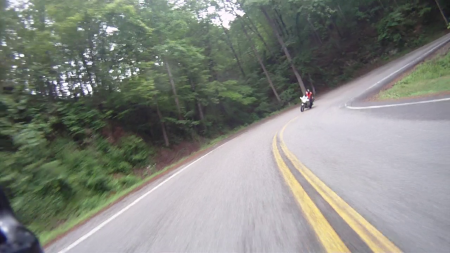
Joel said that me leading helped him judge his entry and exit points since he did not know the road all that well yet. He continued to improve. John thought it was really cool that I got video of him. I offered to do the same for him but he said he wanted me to spend time with his son. "He's getting a lot out of it and I would just detract from that." he said. Instead, he headed off to run some errands.
It turned out that Joel's dream bike is the BMW R1100S. Coincidentally, that happens to be, as we all know, the guest bike. I checked with Bruce and then offered to let Joel give it a try. Since he was a relatively new and tentative rider, I asked him to ride it up and back in the parking lot first so he could get somewhat of a feel for the bike.
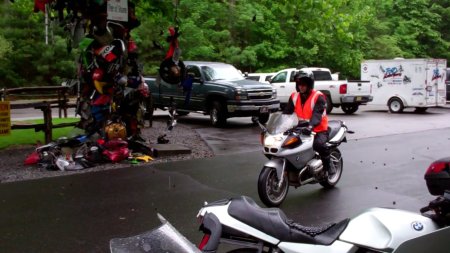
I then led him through the gap.

He was even more tentative on the 'S than he was on his bike. The 'S can run circles around the K100RS, even mine. It's a beast. It took me a bit to realize what the issue was. "Are you concerned about dropping the bike?" I asked. He confirmed my suspicion. "Listen, the intent is for you to have some fun. If you are over-cautious it's even more dangerous. You won't drop it, but if you do it's my responsibility. I'm the one letting you ride the bike. If you drop it I'll fix it. No worries. ok?". He started having a bit more fun on it after that.
I spent a couple hours with Joel going out and back. It was fun but I was starting to feel the need to push it a little bit. Josh's riding has really come along. He offered to mount his camera to his bike. He picked up his own GoPro. I followed him through the Gap at a decent clip. The video never looks as impressive as it feels but I did manage to put up a few in this forum thread.
The most challenging thing about riding a motorcycle is cornering. The bike leans. The suspension and drive train get all squirrelly. There's a lack of confidence in tire traction. You feel like you're going so much faster than you actually are. You feel like you're so much closer to the limits of traction than you are. There's a careful dance between body position, throttle position, braking, counter steering, picking an appropriate entry and exit points. Negotiating the corner apex. A very common accident is to come into a corner too fast and then panic. Either you hit the rear brake which does next to nothing, or you grab the front brake and crash, or you go wide and run out of the corner when the correct answer is to just lean the bike over more and take the corner harder. If you haven't practiced this time and time again, chances are in a panic situation you'll screw up. Deal's Gap presents an opportunity to practice worst case cornering over and over and over again. It's an awesome education and any rider who approaches this road seriously and applies some cornering discipline will become a much better safer rider as a result.
It completely changed me as a motorcyclist. As a matter of fact I have a few friends and acquaintances who are talking about getting into riding. I hope to talk them into going to Deal's Gap after they have some mileage under their collective belts and after they've taken Total Control.
For some reason I didn't take many photos Tuesday. We went down to Fontana Resort for dinner. It's a wonderful 11 mile ride down route 28, known as HellBender. We saw Josh's piglet on the side of the road again.
Since the rain had stopped I had planned on building another good fire but by the time we got back one had been built.
I was a little intimidated by the wastefulness of this awesome fire. They had /filled/ the pit with wood and created a fire so intense we had to stand outside the outer ring. It was drizzling but the water wasn't making it to the ground anywhere near the fire. That evening I met James, the Mississipi push boat captain. We got to talking about the gap. I think he saw me ride and had asked if he could follow me. "I want to see your lines." he said. This was strange since he rode a Super Motard which is basically a dirt bike with street tires and suspension. They are the fastest bikes through the Gap.
"Ok, but just pass me if I go too slow." I replied.
Very late that evening we retired to our "suite". This is what stupid tired looks like.
I managed to sleep. I slept really well. Finally.
Unfortunately, it was the end of Joshs trip. He got up at 6AM and headed out. We were all sorry to see him go.
When I woke I felt better than I had in weeks. The healing effects of motorcycle travel, I tell you what. I did a run out to the overlook early. While there I saw an Suzuki SV650 and a Bandit take off. The SV650 is a very competent bike and should be able to run the Gap pretty well. I wanted to follow someone fast so I got on my bike and chased them.
Unfortunately, the Bandit rider was a noob. Interestingly, I found following him for a while really educational. After a while, to realize what you're doing right you should watch someone do it wrong. His lines were all wrong as was where he was looking and how his body was positioned. He didn't let me pass but eventually I found an opening and went for it. After a bit I caught up to the SV650 rider who was much faster and was leaning off well. The faster corners he was taking correctly but to my surprise the short sharp corners he was slowing down way too much. I followed him for a while but was starting to get distracted by the fact that on the short corners I kept getting too close to his rear tire. This happens when you look through a corner ahead of the rider in front of you.
So I decided to pass him. After I hit my horn he let me by. Off I went. He stayed behind me for most of the Gap except in the tight corners. I don't run the straight sections that quickly preferring the more technical cornering sections. Old man needs his rest, after all.
I rolled up to the suite and he followed me. His name was Tyler.
"Damn", he said or something similar. James the pushboat captain showed up on his motard shortly afterwards and we went through the Gap again. "Can I tag along?" Tyler asked. "Sure." I replied. So we went through and by the time we got back the compliments started flying.
"You know, we used to rag on you old guys on your Beemers. I tell you what, not any more. Damn, you can lean that thing over. You could have dragged knee in places if you wanted to." James exclaimed.
I mentioned this all, jokingly, to Josh at some point some after the trip. "I didn't think I'd keep up with a Motard". We got into a discussion about brands and posuers. These guys weren't. They were relatively new riders but they took it seriously. Nothing Poseur about them. But in many cases down there you see the guys dressed in full race leathers on the super sport bikes that can't ride worth a damn. They buy bikes and gear inappropriate for their skill level.
When I started futzing with my suspension I went through some similar thoughts. It this just BS? Sure the suspension is beat but maybe I should just rebuild it to "stock" instead of trying to improve it. I've always believed in buying less competent equipment and then outgrowing it. It's much more difficult to ride a BMW K100RS through Dragon than a Super Motard or a sport bike. But I learn alot doing it. I have to be much smoother. I have to pay so much more attention. It's difficult.
But I had not considered that improving my equipment might actually allow me to learn something new. I would not have imagined that I would learn to become a better rider by improving my suspension. But I have. Even Duncan, Bruce and Josh commented on it. And I'm having significantly more fun as a result.
Joel and John left. We were unable to convince them to stay. They ended up riding the Blue Ridge. I heard from Joel recently. He said his time with me gave him the tools and confidence to really enjoy the Blue Ridge with alot less tension. I took it as a huge compliment.
Ego so huge now ... intolerable really.
For Ian's benefit, I figured I'd comment on the couple of old guys who took the room next to us who had Ducatis.
We decided to spent the day hanging out at the most challenging corner on the Dragon, the Gravity Cavity. James the pushboat captain showed up and offered to take some photos. So Bruce and I decided to see if we could improve our negotiation of this corner by repeatedly going through it. It's actually a beautiful spot.
And so we gave it a try.
Bruce on Duncan's K1300S.
Duncan shot some video of us using his Flip Camera. I'll have to do something with the video at some point but don't yet actually know anything about video editing.
That evening there was another fire. A guy was playing "Ring of Fire" on his harley stereo at the time when a huge flame fired out of the pit. Gasoline. Unfortunately the wood was so wet it could hardly burn. I worked on it for some time and slowly got the wood dried out. The guys once again said anything less than overkill was not enough so the pickup truck got loaded up with firewood and the pit was once again filled.
Eventually it caught and we had another good fire.
The next day the weather was beautiful. We met Doug who was travelling across country from California. He was a video effects designer for major motion pictures. The last one he worked on was an animated film for Disney called Mothers for Mars or some such. Duncan and Bruce wanted to ride the Skyway. Doug joined us. He's a good guy and very disciplined rider who has clearly done a lot of miles.
Bruce had been talking about R1200GS's for some time but had never ridden one. "Hey Doug, how would you like to ride an R1100S up here?" I asked with a wry smile on my face. "Sure!" he replied.
So Bruce got to ride Doug's R1200GS.
And he liked it. We joked about getting him one.
The skyway is beautiful with incredible vistas.
Because of the nice weather it seemed like every bike was at the Gap. It was just too busy.
We went back to the Gravity Cavity to watch the mayhem.
And then to the overlook.
There's a reservoir. For the first time we saw a boat.
In motorcycling there's this concept of a "wanker strip". It's the strip of unused traction surface on the side of your tires. The larger the "wanker" or "chicken" strip, the less you lean the bike over. I regularly have leaned my bike so that there's virtually no wanker strip on the back tire. But I have never, in all the years I've been riding, had that happen to the front.
At this point I've spent most of my day writing and I'm running out of time. There are too many other stories and events to describe. There were the guys who had disassembled a bike with a broken frame.
"What was it?" I asked. "A CR500", the guy replied. "What will it be?" I asked. "A CR500 before I go to bed. The frame had broken. He was replacing the frame. I didn't believe he could get it done.
I was mistaken. Impressive.
The details are fading. The stories dissipating. It's now Tuesday. We got back late Friday night. We did the whole run from Deal's Gap back to Duncan's house in one day. 550 miles. Because we took breaks and didn't push ourselves too hard it was surprisingly easy.
Here's to next year. I'll have the bikes ready.
When I was Out There, it seemed to me that time slowed down. Fleeting moments felt like hours that left lasting impressions. However once I came home, time began to slip into the future quicker than it had. Days turned to hours. Weeks slid by. Before I knew it, six months had past. It's been three months since I've written anything and I started this article two weeks ago on my birthday. It feels like I just put it down moments ago.
We've all heard the cliche that time seems to pass more quickly as we age. I think this is only partially true. I feel it's more that we fall into familiar patterns where we encounter the same scenes and ideas day in and day out. Having nothing new to anchor our sense of the passage of time, time begins to slip.
As children, time passed slowly. Each day was filled with new experiences and ideas. There was always something to learn. Moments make an indelible mark that last a lifetime, like the only time I saw a flying squirrel. What we as adults would consider trivial was endlessly fascinating. The sight of our first bird, a bug or creek. It was all new and time past slowly because of it.
But as adults we've largely seen it all. Filed away as something familiar, repeat experiences no longer fail to slow us down and pull us into the moment.
But, travel to new and interesting places seems to. While I was Out There, I saw things I had never seen. Coyote. Buffalo. Bear. Moose. Elk. Carribou. Eagles. Whales. Endless day. Emerald lakes. Incredible people. Views into so many different lives. Every day held something new and time slowed down to the point where in some cases it felt like it stopped completely. How long did I stand there on the edge of the Dalton Highway on the North Slope alone? I remember that moment, standing in the middle of the big nothing as if I had spent days there. It's image is still burned into my brain. I may have stood there for less than 20 minutes.
There's something about having time slow down that makes writing easy. Being here, I've found writing to be vastly more difficult. Even now, as I try to type these words, I struggle in ways I didn't while on the road. The daily stresses and distractions take a toll on my ability to concentrate. The themes and words simply don't flow like I remember. While I was riding, alone in my helmet with only my thoughts to occupy me, exposed to the new, I found it strangely easy. By the time I stopped for the day, I had entire articles written in my head and it was just a matter of typing them in as fast I could.
Here things are different. The voice is fleeting and time passes so quickly it's hard to stop it long enough to craft words. After all the praise I've received for these words, I've felt a strange pressure to hold myself to the standard set by my previous self, a previous self that was in a different place and wrote under much different circumstances. As a result, I haven't written for fear of disappointing. Of course, this is a silly perspective. I have no idea what aspects of this people like or don't. For me it's always seemed that as soon as I have some goal in my mind, for instance I really want you to like what I write, it all falls apart. Instead of letting the story unfold as it will, the way I did while underway, I fixate on this artificial target, please like this, which narrows my field of view, reduces my options and causes me to fail. In motorcycling, target fixation is a classic way to crash. This pattern has shown up in so many aspects of my life. It seems as soon as I try to engineer some particular result or achieve some very specific rigid goal, I have always failed. This has been true as well with business, friendships, women ... I was always taught, and it's often been reinforced, that this is weak and is no way for a man to be. In American thinking, you choose a target and then you narrowly, using sheer force of will and dogged persistence, acquire that target to the exclusion of everything else. If you fail at that acquisition, then you are a failure at some existential level. Fear of that failure paralyzes you. Fear of the judgment that follows prevents you from even trying in the first place.
Coward.
It's interesting that every time I have succeeded in any business venture it's followed the same pattern as writing. It was never what I thought it was going to be and it was always more about just letting an opportunity develop on it's own terms rather than me forcing it to be something it could not be. Interestingly, if you listen to talks by the top business guys out there, you will inevitably hear the bravado where they with great conviction will attempt to convince you that it was their genius that led to their success. Think Google, Facebook, Microsoft and others. None of these companies knew with any clarity what they were going to become, despite what their founders might like you to believe. While they were in many ways brilliant, and worked very hard along the way, their success was much more related to the fact that they got out of their own way and let the opportunities unfold and define themselves.
This is something I have to remember but it is so easy to forget. Like difficult muddy roads, writing and life is something that, at least for someone like me, cannot be forced. I simply can't engineer my existence. I can't write to produce some effect.
So I will remind myself not to try.
When I started writing this article, it had been exactly a year since I made that fateful decision to go cross country. On that day, I didn't know I would go to DeadHorse. I only knew that I had to get away. I had envisioned a trip like the one I had in 1992. It would be long, grueling and involve a lot of miles. I imagined doing the near 1000 mile days which would, as I used to describe, sandblast the cobwebs out of my mind and leave a calm emptiness in it's place. In a masochistic way, I looked forward to the torture and wondered whether I could actually still do it. I didn't expect any great changes or insights and I certainly didn't believe I could run away from any of my problems. But I did think that maybe I could take a break from them for a little while. Maybe through grueling miles and the emptiness that results from them, I could quietly slip into the future and put some temporal distance between me and my troubles.
Of course, we know that the trip turned into something vastly different. I sometimes wonder where I would be today if it hadn't been for the blog. In the beginning, once the idea of going to DeadHorse for No Good Reason At All started forming in my head and I started mentioning this to close friends, most of them mothers. The overwhelming response I received was you're going to die! You have to send me an email or a text message every day so I know you're alright. After it got to be over a dozen, I began to realize there'd be no way I could ever keep up with that many messages.
You should write a blog, Maria, also a mother, said. That way anyone who's interested in your untimely demise can follow you and once the blog updates stop we'll know roughly where you bit it..
That made sense to me so I promised I would and I do try to keep my promises.
As I mentioned early on, a trip from Washington DC to DeadHorse Alaska isn't in and of itself noteworthy. Sure, it's a long way but it's a far stretch from the epic adventure one might think it is. It's done every year by little old ladies in RV's.
I remember thinking early on, if everyone has done a particular trip why bother doing one? It's a commodity trip to an arbitrary destination and there's no point to it.
I've started reading motorcycle magazines again. Last month, Brian Catterson wrote a little editorial in Motorcyclist Magazine called High Adventure where he wrote Please don't call to tell me you're riding around the world ... Hate to say it, but circumnavigating the globe on a GS has become a cliche.
In one way, he's right. If it's been done so often by so many, why do it?
He misses the important point.
We live in a world where most things have been done. With over 6 billion people on the planet it's unlikely that any of us will do much in our lives that truly has not been done before. Add to that the thousands of years of recorded human history and the chances become even less. All the great adventures have been had. The paths have been cut ahead of us. The most we can realistically hope for is to follow in someone elses footsteps to do what has already been done.
And it's completely irrelevant and lessens nothing.
This is because of the nature of stories.
If it weren't for a few serendipitous events, I would never have understood this.
My plan had been to ride the 15,000 miles focused, as I had been in 1992, only on riding miles like so many guys I met out there. On the '92 trip, I didn't meet a single person on my own. I spent all day every day on the bike from dawn till dusk. The country was a blur and the trip was over in a heartbeat my perspective over the handlebars largely unchanged. It is possible to go from one end of this country to the other and experience next to nothing.
I have to thank Maria for suggesting the blog. Without that one off hand comment, I would never have considered doing something like this. I knew I couldn't write. But I figured I would at least give it a try since no one would read it anyway. I figured those interested in my untimely demise might skim over the photos.
I learned to ride 36 years ago. I've been across the country three times and have taken countless lesser couple thousand mile trips. I've done it so often that much of what I do slips by too quickly because it's so familiar.
I figured I shouldn't write a typical road report. None of the people who expressed concern rode. Most had never been on a motorcycle. So these people would not be interested in the typical kinds of things that occupy the minds of motorcyclists. Tire wear. Oil consumption. Gravel. Road conditions. Speed. Miles. Pain. Antics. Monkeybutt. Boring.
Sometimes to get the an answer you have to ask the right question.
I asked myself, as I sat on my motorcycle crossing into Pennsylvania, What is it about this experience of riding a motorcycle cross country that I take completely for granted? What is it that is so routine that I don't even notice it or think to comment about it but that might give someone who has never ridden like this a sense of what the experience is like?
That question at that moment completely changed the nature of my trip. It prompted me to look at what I was doing through what I imagined were the eyes of people who cared about my well being but had no idea what it was like to travel many Miles by Motorcycle. It was not new for me, but it was new for them.
As I rode along on my little commodity trip out to some random point on the globe, I tasked myself to pay attention to those things that I have seen time and time again; that I take completely for granted but that someone who has never ridden across the plain states, or up in the Rocky Mountains or through deep canyons would not know about.
Suddenly time slowed down as if it was my first time. The nature of my trip changed from an external brutal assault of miles into an internal story I wanted to tell myself.
I tried to imagine what questions would others ask and what stories I could tell. Why do I ride? What's different about riding? What happens to someone traveling so far by motorcycle that does not happen to people in cars? Of course, these stories are old hat for anyone who rides. They are normal, even potentially boring because we've been Out There. We know. We've seen it all before.
But that's irrelevant for a story. Stories are not for us. They are for you. For you who have not done, seen, thought, felt, or experienced the things we have. Stories are how we, as human beings, share our experiences with others. It's core to what makes us human.
We are a storytelling species.
In the old days, merely doing a thing was sufficient for a story. There were technical challenges to overcome and the practical aspects of trips or any accomplishment were worthy of the telling. But today, where virtually everything has been done, merely telling the what, as Mr. Catterson implies, no longer cuts it. At the practical level, there are only so many ways to do a trip. So you ride bike around the planet. Maybe you try to distinguish yourself by riding an old bike around the planet. Or maybe you try another practical approach and do it one handed. Etc. etc.
Futile. It's been done.
I just finished watching the Long Way Down
The first, which they also turned into a mini-series is called Long Way Round
I watched Long Way Round some time ago and last night as I finished watching Long Way Down, I wanted to see more. I found myself hoping that they do another trip and document it. I wanted to hear the story despite having heard and read about similar travels. The parts I found most compelling were not the scenery, the difficults roads, but instead the people they met. The lives they touched and most importantly the internal challenges they faced as they did their 15,000 mile trip. Ewan McGreggor is at times quite philosophical and introspective and is someone, given the chance, I would like to ride with.
Many of the themes and internal changes that I felt on my trip they talk about on theirs. Despite the fact that so many of the themes in their story are familiar to me, I was still captivated by their telling.
There's something significant here.
We seem to have a never ending capacity for listening to stories, especially stories about other people. I spent good money and watched many hours of video about a couple of guys riding motorcycles. In a way, it's absurd. I can go do that anytime. I also know, that even if they were to ride across the US and produce a video of it I would buy it and take the time to watch it. It'd be a good story.
So, on the one hand, while even just watching these guys try to pitch a tent in the cold wind and rain is interesting to me (Are you listening, Ian??) when it comes time to express my own experiences I become self conscious. Clearly, a story of pitching a tent is not worth telling ... but maybe it can be, especially to someone who has never been camping.
And I think there-in lies the difference. We lead finite lives. We believe firmly that our own stories are too boring, too common place to ever be worth telling. Yet somehow we crave the stories of others outside our experience. I've talked to so many people who feel that they have nothing worth telling.
I was recently at a bar talking to a guy who had served in Afghanistan and Iraq who was born in Ireland, lived in France for a while. He had been shot twice and had incredible stories of people and places. I've got no stories, he would tell me. What? Are you kidding??, I replied. Well, I've never ridden a motorcycle cross country, he answered. When he talks, I listen. It's always a good time but I think there's something here. Here's a man who's experienced things that I will hopefully never experience. Yet he doesn't feel that the stories are worth telling.
I think of Phil, the former America's Cup sailor who I stayed with in Boston. He's an incredible story teller. He has a way of taking even disasterous events and making them worth listening to. He's another individual who has experiences and insights I will never have. I benefited greatly from the stories he told me.
And I think that's the key. We all have our stories whether we believe they are worth listening to or not. Most of us, if not all of us, being so intimately familiar with our own stories, lose sight of how others might benefit from them.
We demand of our own stories that feeling we get when we listen to the compelling stories of others. I think the trick is to realize that we never feel that way about our own stories, because they are our stories. We share them not for ourselves but for others.
I recently got a friend request from a guy in Zimbabwe who had happened upon the blog. Zimbabwe?? I found myself wondering what his daily life is like. He could tell a story of getting up in the morning and going to work just describing what he saw, heard and most importantly felt during his day and while he might be bored in the telling of it, I would find it interesting. We live in a ridiculously small world.
How many people are there in the world that would feel the same about the mundane aspects of your own life? Or maybe put another way, what have you done that I never have? Can you remember the very first time you did a thing? Can you remember what drew your attention? Do you remember how you felt?
Stories start there.
I recently met Josh at the International Motorcycle show down in DC. He had mentioned some time before, based on the last article I had written, that he had wanted to tell me something; something that he thought I would benefit from.
We met for lunch before heading into the show and he tells me, "You may have been through hell, but you have great stories and I never get tired of listening to them. I don't have any stories but I hope to make up for lost time." I was floored. Thank you, Josh.
Josh has great stories too. He, like so many of us, just doesn't know it.
Something snapped over the last few days. There's this distinct point when idle musing starts to become something else, something dangerous.
I've been sitting here at my desk in front of this computer for hours on end working on the software that runs this site. I really want to get the tagging and mapping software done because I think it would be cool to have especially for the next Deal's Gap trip. But as the hours turn into days and weeks my mind begins to wander.
The last time I was at Bob's BMW having my bike worked on to fix the heated grips I noticed a flyer on the wall about a presentation by a guy, Allen Karl, who had ridden around the world. "Ah, another Long Way Round.", I thought as I considered attending. It's the kind of thing I never do and I thought maybe I would learn something. Maybe I would meet some interesting people. Maybe I would have a chance to talk to the guy.
I went home and forgot about it until an evening or two later. I decided right as the registration deadline approached to sign up.
Later that week, while getting my hair cut the woman said, in her thick Vietnamese accent, "I read about your trip". I was floored. I think I had mentioned it to her after I got back. We got to talking about it. A guy walked in who, coincidentally, wanted to get into motorcycling. A few minutes conversation turned into 45. I talked about Deadhorse and the road. "So where are you going to next?", he asked me. I mentioned I didn't really have a Next. I described how I had toyed with the idea of South America. Could I make it down to Tierra Del Fuego? "That's really dangerous", I think he said. "Naw, you should ride through Eastern Europe", he said.
Less than a second later when I realized the full implication of what he had just said I replied, "Awww, man. I wish you hadn't said that!". Of course, this is how I got myself into trouble the last time. Really, it was only supposed to be a trip to Victoria, British Columbia to see my buddy Ian. But of course if you're in Victoria you might as well jump across to Vancouver. And if you're in Vancouver, well Frazer Canyon is just up the road. Well, Prince George isn't too much further, where, as an aside, you have to stop at the Twisted Cork restaurant. From Prince George the Alcan Highway isn't so far. And so on. Before you know it, you're in Deadhorse.
"You know, if I make it to Eastern Europe I'll be too tempted to keep going ...", I explained.
Europe. I heard that Danny the Real Adventure Rider shipped his bike to Europe. It's probably more doable than I imagine. I began to daydream about riding through Europe. Maybe I could do that next summer or the summer there after. A friend of mine here in DC is moving back to Europe for a while. I could ride by and visit her. I could visit my family in Ahausen, Germany. I could visit Henrike outside of Frankfurt. Then there's Andrea and Thomas in Zurich, who did a huge year and a half long trip through the Western Hemisphere. I just heard from Andrea and they are considering new trips. I could ride to Berlin and visit a friend there. Then there's riding through former East Germany. I even have friends farther east.
I let myself idly consider a trip through Europe as I wondered what route Allen Karl had taken. "Around the world?", I thought. In my typical fashion I didn't read up on him or look at his website. I wanted to leave myself free of any preconceptions before his presentation.
Since I've gotten back things have been very different. I'm continuing to meet new people. The Nightmare is really beginning to feel like it's over. My mom has finally put Fort Lamers on the market and once that property is gone, the last physical vestige of the Nightmare will be past tense. I'm working like a madman on a new project that I hope to be able to do something with. I want to combine motorcycling, software, writing and business. Slowly, I'll turn this site into the vision I have for it. But questions of what I'm going to do Next with my life still loom large like some kind of ominous cloud. Eventually, I will have to start making money again, a fact that weighs on me more heavily as the days pass.
But something's not right. I'm not the only one who feels it after having come back from being Out There. I heard from Richard Giffin, the epic bicyclist I met on the Alcan highway. He described a feeling of emptiness since he's gotten back. Maybe that's the right word. Something's missing here, but I don't really know what it is.
The feeling of the road is gone. I feel more closed. Darkness has been finding it's way back inside. Maybe it's this house. Or is it this area? Or is it simply the fact that each day I wake up in the same place and go through the same ritual looking forward to nothing other than getting out of the house very late in the day to go grab dinner and a drink out somewhere. Most days here, I spend entirely alone.
I asked myself a dangerous question. "What am I living for?". I have no epic Nightmare to consume all of my being. I've been tempted to try to save ones in need only to face the harsh reality that I don't have the power to do any good. Maybe impulses like that are an excuse not to focus on the bigger question.
"What am I living for?"
The people I know on the standard plan live for their kids. Some others I know live for work. Some live for their spouses.
I fear most don't live but instead just exist.
I've done the workaholic thing for most of my life, where by most I mean since I was 8, but it was all tied to the Nightmare. I've built businesses, none of them terribly successful but I've learned from each one. Anatoly and I have been working very hard on a new business concept which might actually become worth something. Can building something like that be a reason to live?
I had dinner with Rachel recently as I had been thinking about these topics and I mentioned, "I think that cliche of live every day like it's your last isn't right. I think what was so good about my trip is that each day was the last in that place." To which she replied, "I think you should live every day like it's your first in a new place". Wise as always. I just don't know how to do that here, at least not yet.
I still think about fear a lot. I fear that the way I live my life is too irresponsible and will catch up to me. I fear what happens when I get older. My health is not the best but then again never has been. I fear failure. I probably fear success even more. In some ways I think I fear change. Rachel is moving back to DC completely changing her life. It's scary but she's doing it, a life redirected.
I have not been able to, in my day to day life, do what was so easy for me to do on the road. I fear I am still a coward in many ways, but maybe ever so slightly less so.
Because thoughts of fear dominate my thinking at times, I asked myself another question. "What am I most afraid of?". My mind wandered off topic and drifted southward as I consider Andrea and Thomas' trip.South America scares the shit out of me.
What scares me even more than South America? Africa.
Being a masochist, I began to consider the trip that I would fear the most. I could ride South to Tierra Del Fuego, knowing full well I would not survive, and if I did somehow make it, I could ship the bike to South Africa and ride north. I'd never make it. Certainly anyone who tries a trip like that would end up dead. But if it could be done, how incredible of a journey would that be?
I put on my gear and headed out as the sun set to ride up to Bobs BMW to listen to this presentation. I wondered what route he had taken across Russia? Or did he maybe descend into Mongolia as Ewan McGreggor did?
I was surprised how many people had showed up. I think it must have been 50 or more. Surprisingly few people rode, but then again it was forecast to dip down to 34degF.
Bob had the thing catered. The shop was nicely set up to accomodate alot of guests and it was kind of a business party atmosphere. There was wine and beer. I got to talking to a few people around a table. A woman, Linda, had gotten into riding a few years ago. She was 58 when she started. She rode for 30 days I think she said and then went on a 2500 miles ride from Victora BC down the West coast. She got into motorcycling because, she reasoned, it was the most uncharacteristic thing she could think of doing. It turns out she had lived through her own Nightmare and turned to the motorcycle to gain some perspective when nothing else worked. She's in the process of writing a book about it and has a blog. I promised I would link to it, but haven't had a chance to read any of her writing yet. It's called Blind Curves.
I talked to another woman, but I did not get her name, whose ambition it was to ride a dual sport bike through third world countries. She was in her 50's as well.
I talked about my trip, the blog and what I learned. When asked how I could take so much time off, I alluded to the Nightmare. We talked for maybe an hour and I was a little embarrassed when they asked me what other adventure riding around the world I had done. They thought initially I was the presenter. "Nope, I'm just some random guy, but me being here is such a bad idea". "Why is that?", they asked.
"I might get inspired."
The shop had been cleared out and rows upon rows of chairs had been set up. They had projector. The rider and presenter, Allan Karl, started with multimedia presentation. A collage of photos and video put to music, in the fashion of what people suggested I do but didn't. Following an emerging pattern, Allan had run into life problems, sold all of his belongings and rode his bike 62,000 miles for 3 years through 35 countries. He's in the process of writing a book and wrote an extensive blog while he was Out There. Sound familiar?
I looked at the photos and the video and slowly I started to get this sinking feeling.
Contrary to what I assumed, he did not go East.
He went South.
All the way South to Tierra Del Fuego. Despite being warned not to, he rode through Columbia and ran into potentially life threatening situations but emerged not only unscathed but with new, albeit very dangerous, friends.
To make matters worse, he did not stop. He shipped his bike from Argentina to ... you guessed it ..
AFRICA!
Allan is a good story teller. The stories he chose to focus on reflected themes from my own trip. Risk. Fear. Patience. Humility. Trust. Human connection. The kindness of strangers. He spoke for about an hour and mostly covered his time in South America.
Unfortunately, he made this trip seem much more doable than I could ever have imagined.
It has gone from idle musing to a Thought(tm). And Thoughts(tm) are very dangerous.
"What am I living for?" Could I live for a trip that could end it all?
I will not do this ...
Angela sent me a text, she's out running a Hare Scramble in the sunshine. I haven't ridden a dirt bike in years. I'm envious.
I've also, while writing, been chatting with Josh about taking the Total Control 2 course sometime next year. That should be fun. I had intended on writing about our trip to Deal's Gap and the many conversations we had there, but strangely I've found it almost impossible to write about.
Duncan just called. As I saw the number I knew he wanted to go for a ride. He's on his way over and we're about to head out into the chilly autumn air to ride through fall colors, so I'll have to cut this off here. I may come back to this later.
So I had this vision for what I wanted this review to be. Unfortunately, this is not that review. This is a lesser review. I made an editing pass and added a few more impressions here and there.
The Executive Summary of My Impressions of the Aerostich Transit Suit
Yes, it is 100% water proof. A couple thousand miles of epic rain proves it. The only time water gets in is if you're stuck in slow traffic and some leaks down your neck or there's no one to remind you to close your pockets.
Yes, it is about 30% cooler in direct sunlight when compared to comparable black leather.
Despite having no vents to speak of, it does breathe surprisingly well.
Yes, it's very well constructed and is surprisingly comfortable as a result of the softer TF armor.
In 100% humidity DC summer heat it does NOT vent nearly well enough when compared to traditional leathers with large vents such as the Tourmaster Magnum Jacket.
The pockets leave something to be desired.
No, it is not worn over clothes.
No, it cannot be dry cleaned. As a matter of fact, it has to be washed by hand in cold water with a sponge using something like Woolite.
People seem to like the way it looks.
I think it rocks and wear it every time I ride.
For more info read on ...
It had been my intention to write up a Road Report about the Deal's Gap trip with Josh. I may yet get around to that but the memories are starting to fade a bit.
The problem I have is that when I'm developing large software projects, such as the one I'm working on now, my mind gets so deeply into it that I don't have the mental "space" in which to write prose. When I was traveling Out There I would spend my whole day just thinking about how I could present what I was seeing, feeling, and thinking. Here, now, in the midst of these practical concerns, I just don't find those calm introspective hours in which to craft words the way I want to.Sometimes it's better to do something badly, or at least not as well as you would really like to, than not to do it at all. So here it is.
While I was traveling to Deadhorse and back, I got a few requests for more photos of my Aerostich Transit Suit.

I've gotten quite a few compliments about this photo, so, by request, I've posted this larger version, bug splatter and all.
Last week, a new m-by-mc member, JohnnyDanger from the West Coast, asked if I could post a longer review of the toxic suit. That has put me over the top. Now that I have the Facebook login code finished, I figured it'd be a good point to stop, take a break and put together some of my impressions.
I've now put over 14,000 miles on this suit through every imaginable weather condition.
On day 4 of my 77 day journey I stopped by the Aerostich wearhouse in Duluth Minnesota as I made my way to Missouri. I must confess right up front I am quite the Aerostich fanboy. They have this fantastic catalog of serious functional gear for motorcycle travelers. I've bought so much stuff from them over the years, for instance my coveted motorcycle espresso maker, that if they were publically traded I think I'd have to own stock.
Aerostich is primarily a garment manufacturer. They produce extremely practical armored riding suits designed to be worn over normal clothes. For years their Roadcrafter suit was the defacto standard commuters and tourers alike. A large percentage of the long distance riders I've met wear Roadcrafter suits. I've had one myself for years but rarely wear it. It's too hot for the summer extremes here in DC and, I hate to say it, but it looks like shit. As is the case with almost all of Aerostich's stuff, the Roadcrafter suits will never win any fashion contests. They are about the ugliest looking things out there.
After Gesa's fatal accident, I decided to retire my ancient set of Hein Gericke V-pilot leathers in favor of armored gear. I eventually settled on a jacket and pants combination made by Tourmaster. They were armored leathers and pretty substantial. The Tourmaster gear is not bad and for the money it's hard to beat. Even from the start, though, I viewed them as a stop-gap solution while I looked for something more to my liking.
I saw the Transit suit in the last Aerostich catalog but didn't understand that it was anything special. My first impression based on what I saw in the catalog was not all that positive. I thought that maybe Aerostich was feeling the pressure to produce something a little bit more aesthetically pleasing. Then a few days before I left for Deadhorse, I happened upon the Motorcyclist Magazine long term test where they mentioned that this suit is completely water proof and gave it 5 stars, which they rarely do.
That got my attention.
It began to rain on my first day out and after needing to put on the rainsuit one too many times, I decided to head North and take a look at one of these suits. I endured some of the longest hardest rains I've ever ridden through on my way up to Duluth. It was absolutely pouring when I arrived at Aerostich.
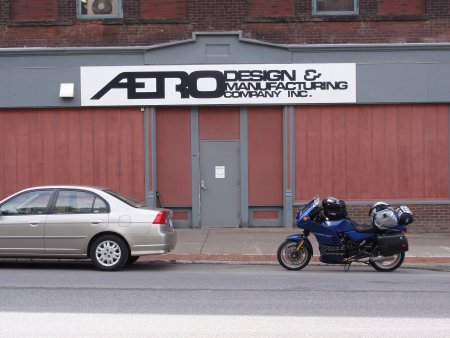
I was fortunate in that they had just gotten a shipment of suits in in various sizes. These suits are not made on premises like their Roadcrafter line, but instead are outsourced to a factory in China. They currently do not have the ability in Duluth to make alterations. They mentioned they needed some additional equipment before they can do that.
They had a number of sizes and my first impression was that they are not cut that well for my frame. The 40 jacket was too short in the arms and too tight in the shoulder but seemed to fit across the chest just fine. The 42 had correct arm lengths but the waist was much too large. There's a stretchy draw-string on the inside of the jacket around the waist to tighten it up a bit. Once I pulled that in tight, the jacket seemed to fit ok, but definitely not perfect. I would have preferred a much more tapered cut. There's too much room around the waist in my humble opinion.
The pants were a much easier fit and generally seem to follow the cut of regular jeans. This suit is not designed to be worn over regular clothes. There's enough room in the jacket for a fleece sweater and a heated vest. The pants fit like jeans.
They claimed the suits are completely water proof, as in rainsuit waterproof, and that they are cooler in direct sunlight than comparable black leathers. I didn't believe either claim but was willing to suspend my disbelief and take a leap of faith.
So largely because I was absolutely disgusted with my rainsuit and soaked Tourmaster leathers, I bought my Transit Suit.
If you visit them they'll give you 10% off the purchase price. I'll have to check my receipts but I think out the door with taxes and all it was a little over $1400, which is alot for "normal" leathers but not out of the ordinary from what I understand for high end suits.
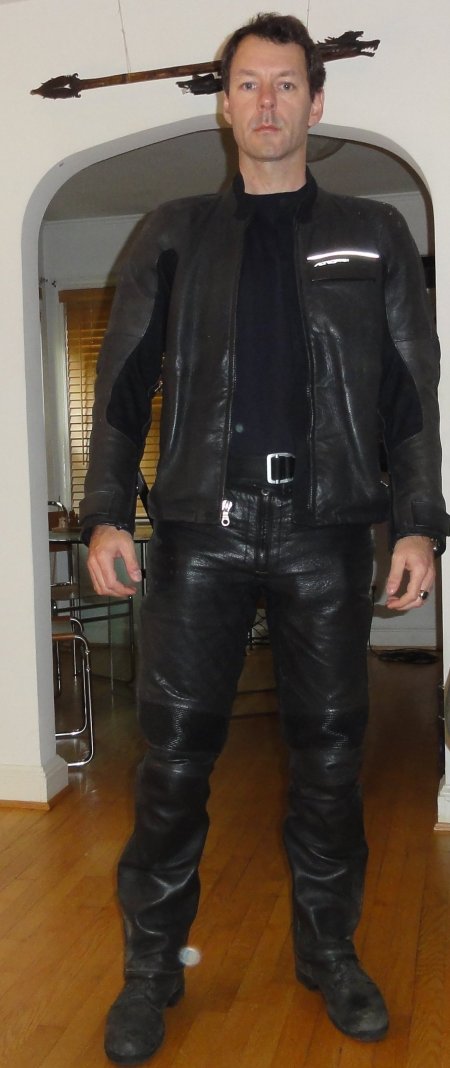
They kindly packed up my Tourmaster leather and rainsuit and and shipped them back home for me for free. That was nice.
It was absolutely pouring down rain as I left the building. I put on my helmet, walked outside and stood there in the pouring rain for quite a while in this brand new suit. I wanted to verify that it didn't leak.
I can't believe it, but no lie, this damned thing is 100% water proof! During my whole trip which involved a tremendous amount of rain, I got only mildlywet in two conditions. Since there was no one to remind me that I needed to zip close the pockets, water would get in that way. Note to self, zip pockets closed when it rains. The second way water got in took me a while to figure out. I was caught for hours doing 25mph in a soaking rain in Pennsylvania. Everything got wet and as best as I can figure it, water got in around the collar. Doing highway speeds, that was never an issue.
What's interesting is the entire suit is perforated across almost all surfaces, I'm guessing to help breathability. There's an inner goretek shell that gives it it's waterproof quality. Wearing this suit I have ridden through literally thousands of miles of the worst rains I have ever been in and it is waterproof. I mean, like rainsuit waterproof. By contrast the Roadcrafter is at best water resistant.
The perforated leather doesn't actually feel like leather. It's "krinkly". Even after all these miles it does not feel like it's broken in. I don't get the impression this stuff will stretch or loosen the way normal leathers do.
I've gotten quite a number of compliments on the pants. I had been riding earlier today and didn't bother to change out of them. They are pretty comfortable. My friend Donna came over unexpectedly and commented on them.
In terms of having something to wear when you're off the bike, these pants actually perform pretty well. They have belt loops, which is something I'm very grateful for. Both the Tourmaster and the Hein Gericke pants don't have belt loops so without a jacket to zip to they tend to fall down. Not so with the Transit Suit pants. They have two front pockets deep enough to accomodate wallet and keys.
I find that because the pants are so "wearable" I can tour without packing extra jeans, which is a great benefit. I like to travel light and only bring what I really need.
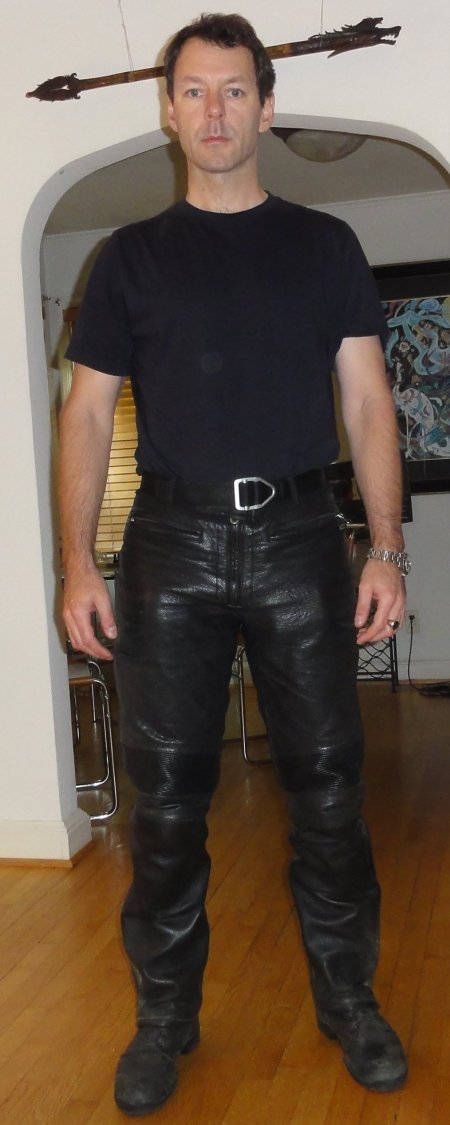
They are armored in the knees and hips. Interestingly, they have extremely long zippers which extend up to the lower edge of the pockets. This makes getting in and out of these things much easier than other leathers I've had.
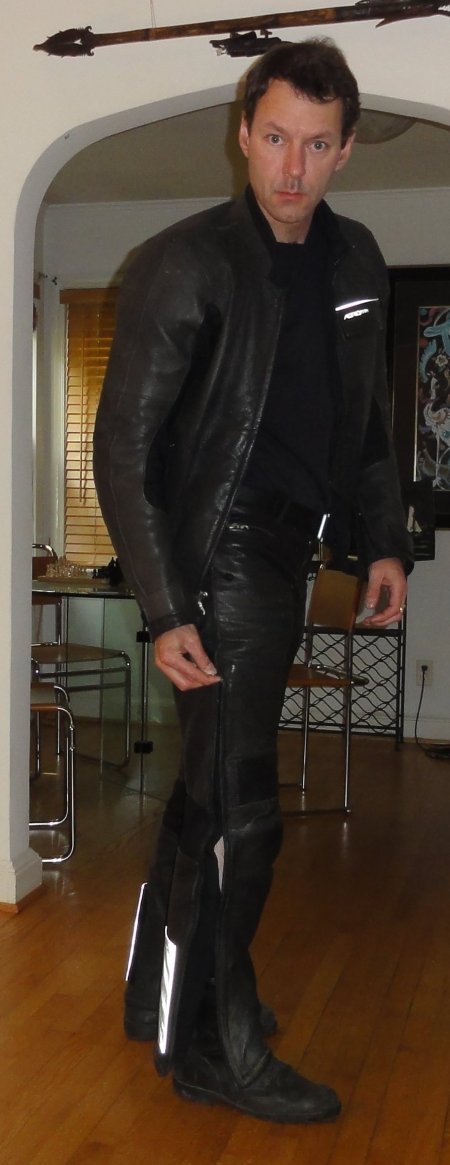
One concern I have is that because this zipper is so long I wonder how it will perform during a get off. I can see, over time, the zipper wearing and losing some of it's strength. It's easy to imagine skidding down the pavement and having the zipper teeth let go. It's a fine toothed zipper.
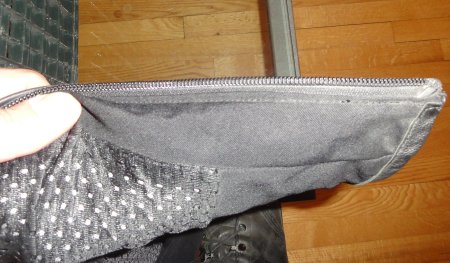
They are gusseted in the crotch with stretch material that extends down the inner thigh and wraps around the back of the knee. The rest of the material is the perforated leather.
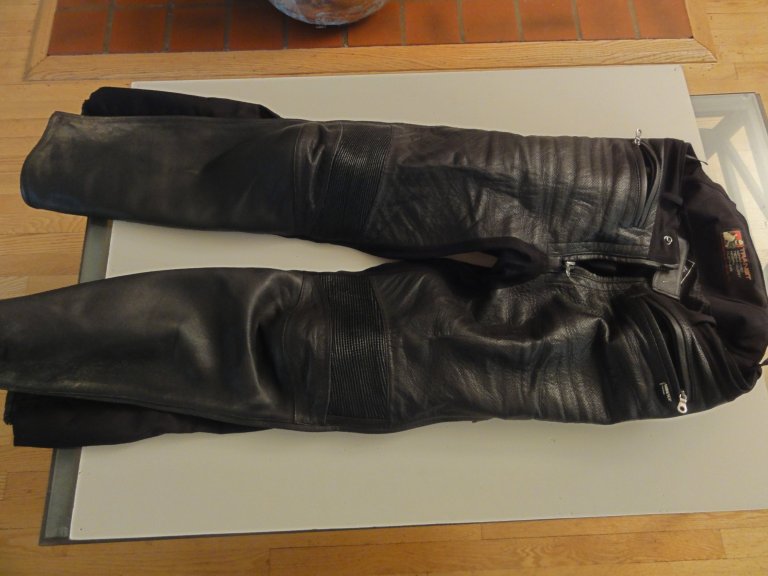
The front zipper is very heavy duty. There a snap at the top.
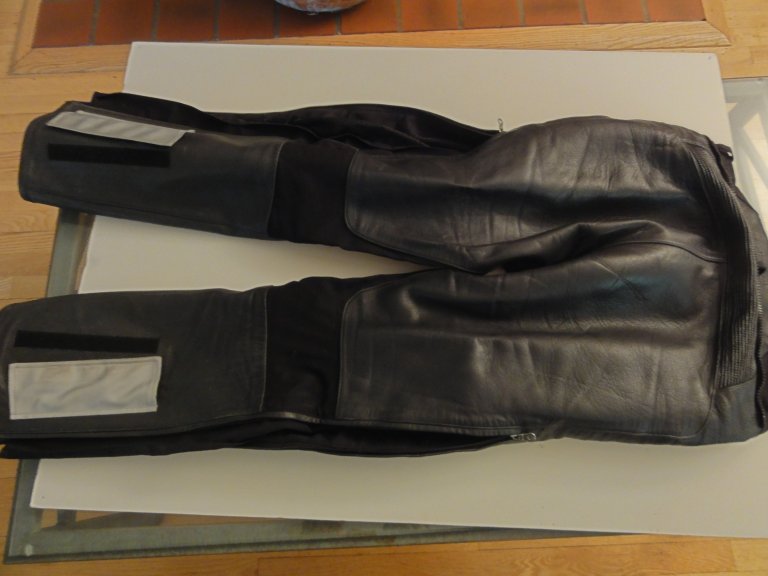
At the base of each leg is a large reflective patch which is surprisingly visible at night. It has a velcro backing and can be used to tighten up lower leg. In my case, I haven't needed to do this.
While they are comfortable as expected they can be quite warm if you're moving around, so it's not advisable to go on hikes in them. A mile hike down into the Pennsylvania Grand Canyon and back out again on a 95degF day was a bit much.
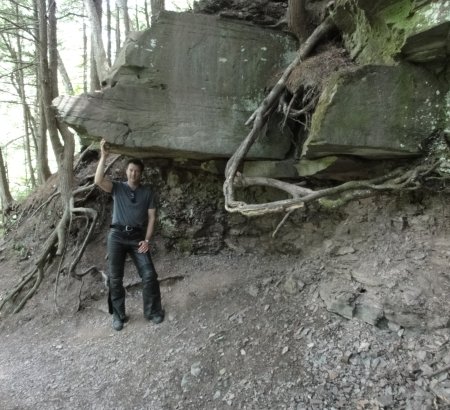
The construction of the jacket is similarly to the pants.
It has a full back protector, shoulder armor and elbow armor.
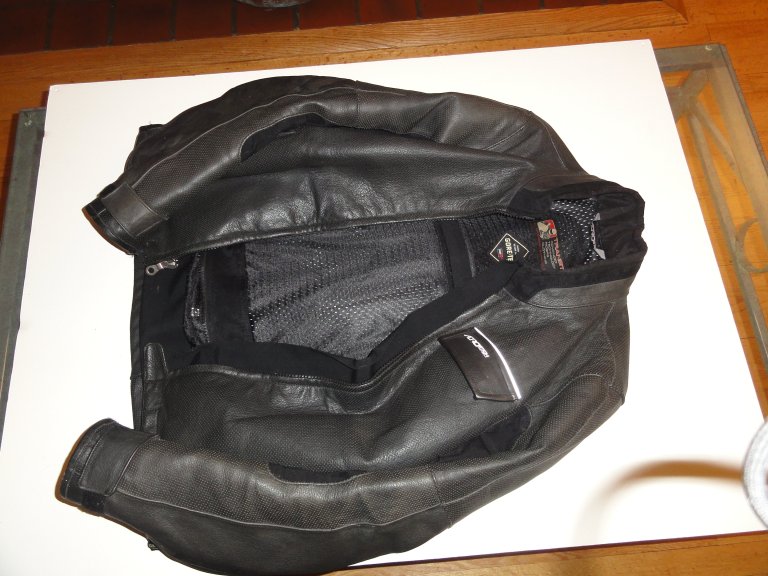
There's stretch material that extends from the armpit down to the elbow on the underside of the arm. It also extends around back slightly to the edge of the reflective band.
There is no liner for this jacket. The inside material is a very light and thin perforated fabric. I wonder how this is going to hold up over time.
There are three pockets on the front of the jacket.
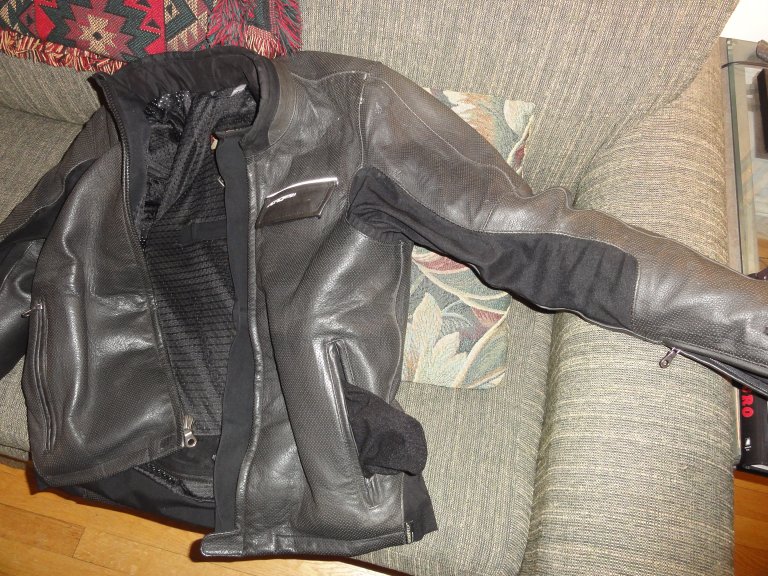
The two main pockets are lined with what could be described as something that feels like felt.
Gripe #1: When your hands are wet or you have gloves on it seems damn near impossible to pull anything out of the side pockets without the liner sticking to your hands and coming out with whatever you're trying to grab which then summarily dumps the contents of your pockets into the muck or whatever else you happen to be standing on, which of course will be wet because it's raining. I would much prefer some kind of other material that didn't stick so much.
Gripe #2: I really miss a pocket on the armsleeve for keys and earplugs. The side pockets are not that deep and if you ride with them unzipped in a vain attempt at additional airflow the contents are likely to spill out. I have, however, since gotten used to keeping my keys and earplugs in the right front pocket.
The back of the jacket features a reflective strip of the same material that's used on the pants.
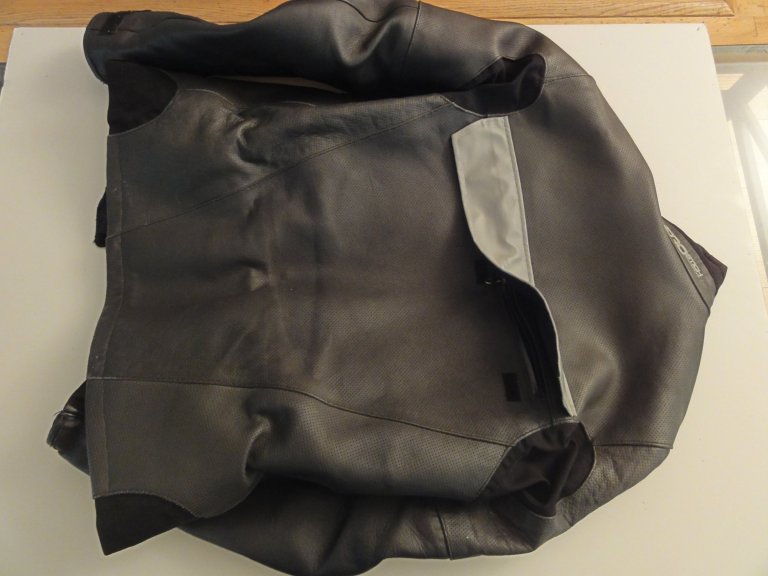
Where you see the folds near the waist is where I have the drawstring pulled in tight.
The reflective strip conceals a zipper that supposedly acts as a "vent".
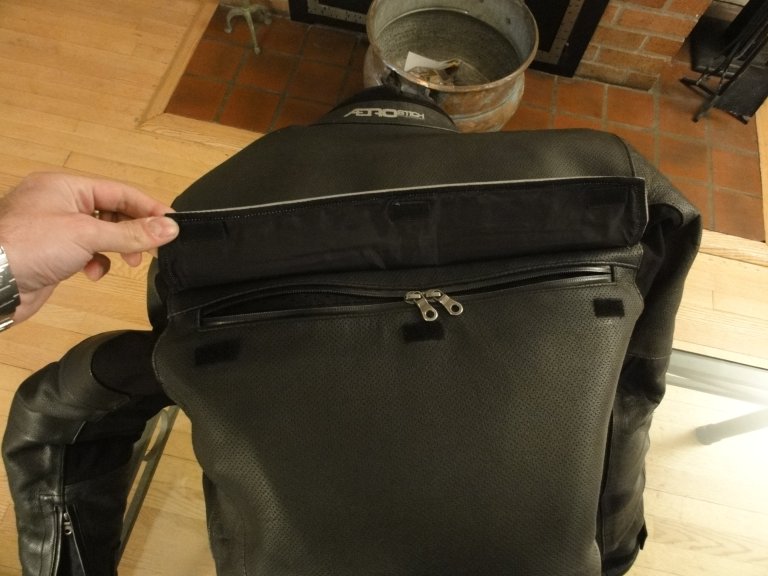
I've left this open for the entire trip. Under the reflective strip it doesn't seem to let any water in. However, I don't know how much good this actually does in terms of venting.
On the subject of venting, this suit breathes much better than I would have expected given how water proof it is. Compared to the Tourmaster Magnum jacket, I find that I need to add layers under it much sooner as it gets cold. I picked up a fleece sweater thing that I use in place of a liner. It works surprisingly well.
In direct sunlight, as they claim, the suit is cooler than comparable leathers. If the ambient temperature isn't too hot, you'll sometimes forget that you're standing in direct sunlight.
However, this suit does NOT perform that well in Washington DC summer heat. It's hot and humid weather performance is probably it's weakest point. While it does vent, you need to be moving at a good clip. If you're stuck moving at only 25mph in traffic you'll cook much worse than in comparable leathers with huge vents. In 90+ degrees of soupy heat the Tourmaster jacket with all the vents open vents much better than the Transit Suit.
Gripe #3: I really wish this suit had zippers in the armpits to let air through there. That would go a great length towards improving it's extreme heat performance probably without sacrificing much in terms of water proofness. Extra vents across the front of the suit would be a welcome addition. Obviously, waterproofness and good venting are contradictory design goals.
Being stuck in the humid heat in this thing is just miserable. "'orrible I tell you! Simply 'orrible!". Dry desert heat when you're moving is no problem. The heat reflective treatement they have on this suit works as well as advertised.
There is also a single breast pocket.
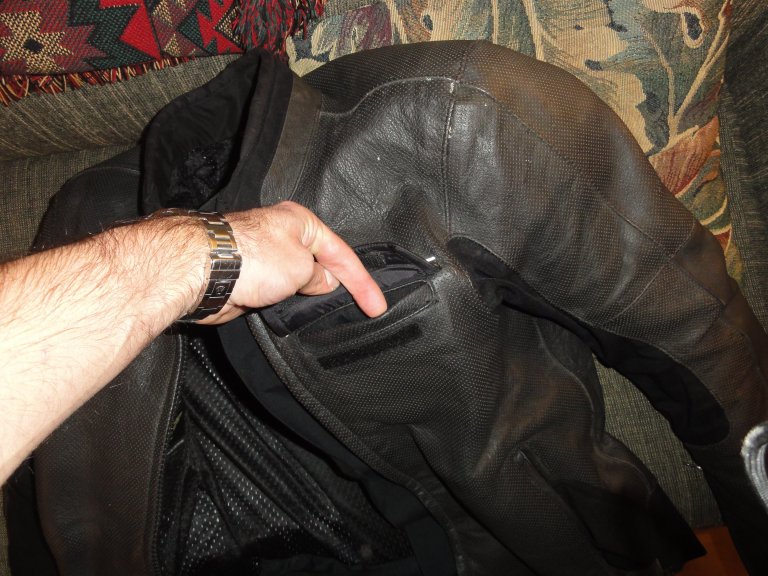
With the jacket on it's very difficult to get anything out of that damned pocket. I have a carbon fiber plate I use under the kickstand when parking on very hot pavement or dirt. I also have my small air pressure gauge there. Both are quite difficult to extract.
The inside of the jacket features two pockets. Both pockets are made out of this perforated thin material, so I would not put keys or other pointy objects in these pockets.
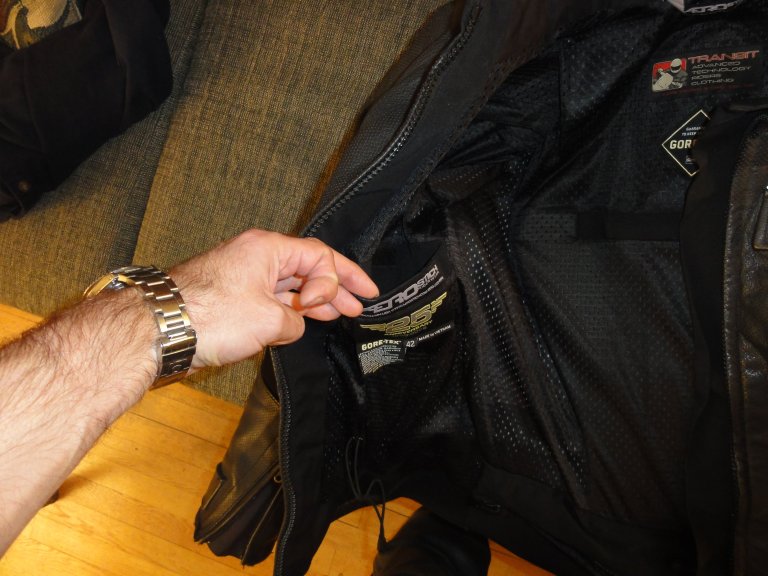
The right pocket is closed with velcro. I find it's suitable for holding a smartphone.
The left pocket is closed using a small zipper.
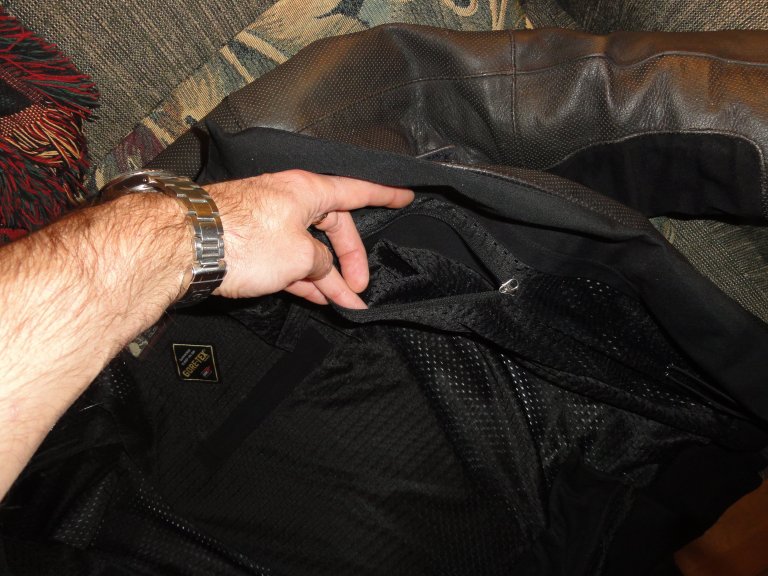
I find the left pocket is useful for holding a wallet. Of course, from a safety point of view you probably don't want to be carrying anything in any pockets while you ride, but sometimes practical concerns override strict safety issues.
The jacket zips to the pants using a Hein Gericke style connector in the back.
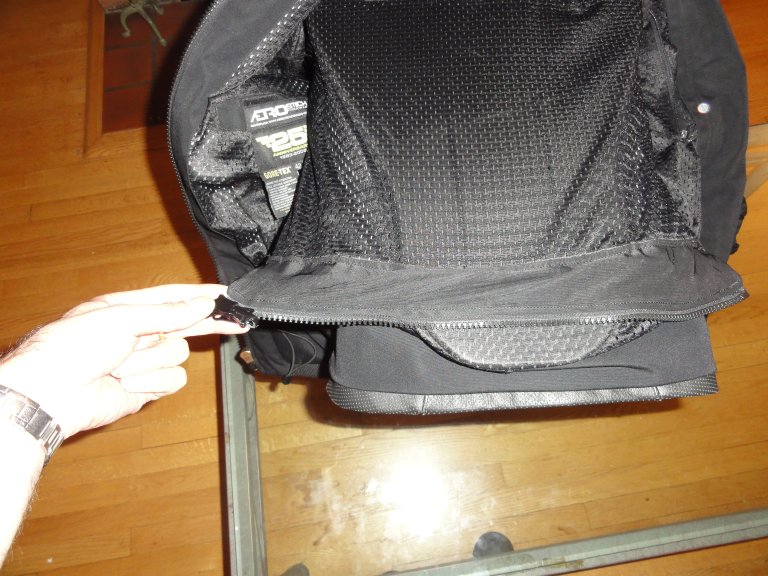
It's a substantial zipper but I find it's very awkward, especially if I have a sweater on to connect this zipper to the pants. It requires quite the twist. The first time I tried it it took me several minutes to figure out how to bend my torso enough and reach around to get the damned thing to line up. With a lot of practice, I now hardly notice it. If you get this suit especially if you have a gut and or back problems, you may want to try that maneuver a few times to make sure it's going to work for you.
This jacket to pants zipper issue was almost a deal breaker for me as I was trying the suit on. As is the case with so many things in life, first impressions have to be tempered. As I mentioned, I now no longer see this as a problem although I do wish the zipper extended further around. My concern is, again, what happens in a crash. You won't want the jacket and pants to separate exposing your back.
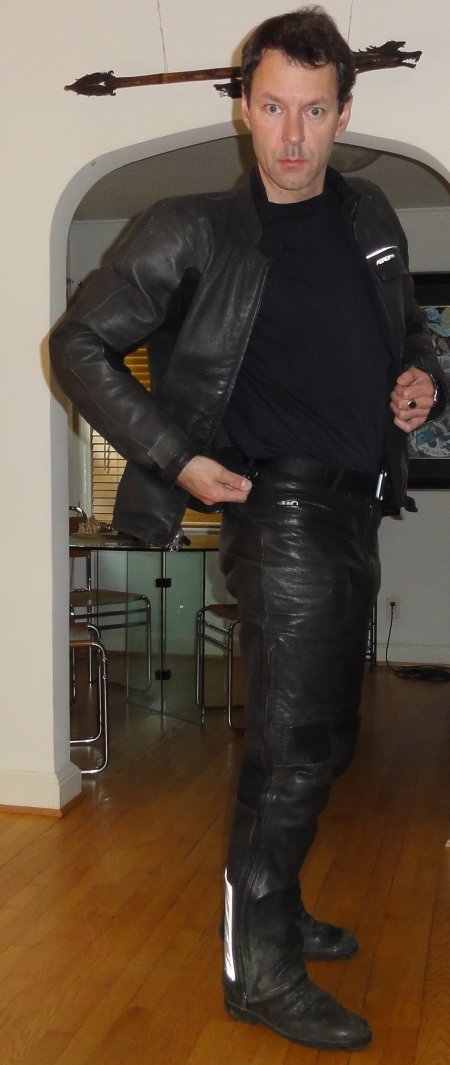
Yea, I know. Scary picture. When I first got the suit I could only get the zipper to "start" using both hands.
As for armor, the components are made out of this TF material which is flexible and "squishy".
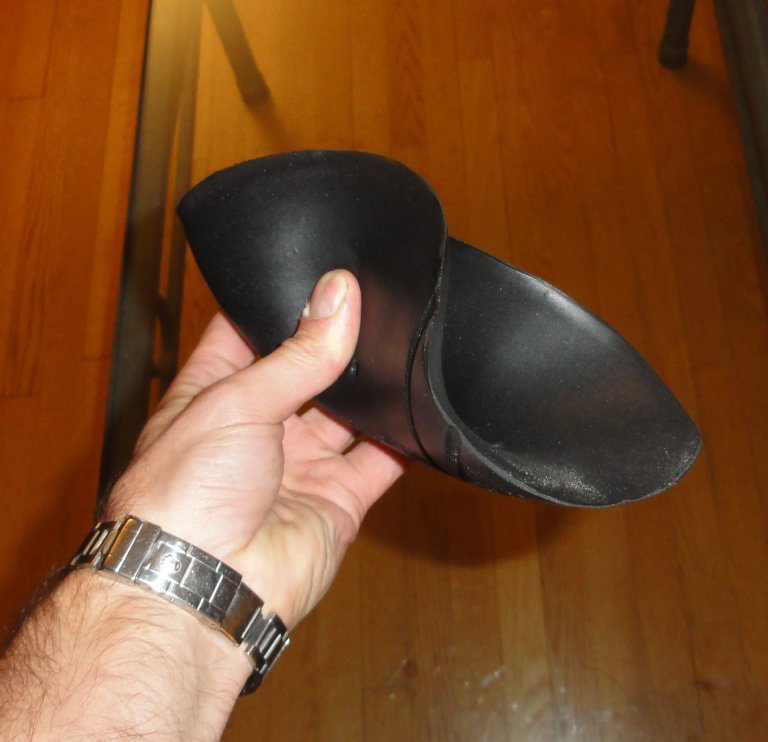
For example this is a photo of a piece of shoulder armor. It bends readily but when you let go it returns to it's former shape very quickly.
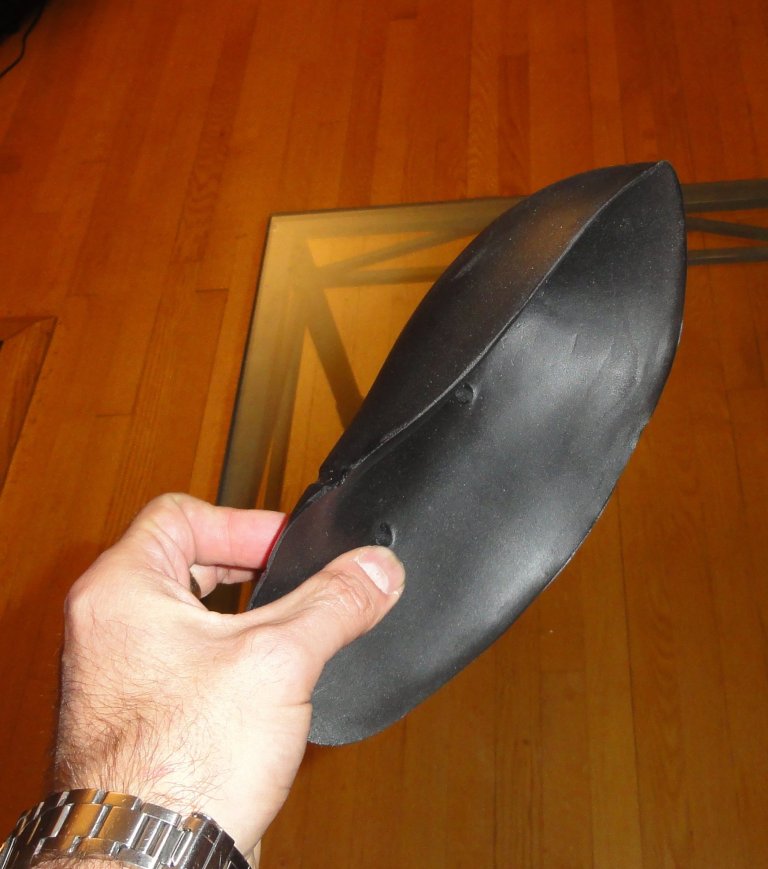
One side effect of this, however, is that if you hang the pants or jackets up on a chair or fold them over you can fold the armor which then gets to be a bit awkward when you go to put the suit on. I end up having to bend the armor back into shape or move it around more often than not. This seems especially true of the left shoulder armor which always seems to need to be positioned. It's another thing you get used to and it's not a big deal. The fact that the armor conforms to my shape is a benefit in my opinion. In fact, most of the time you don't notice that you're wearing something that's armored.
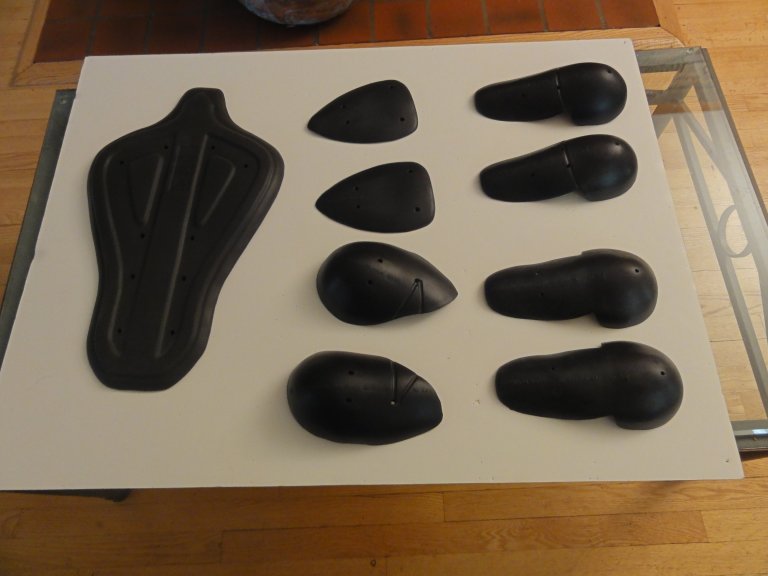
The armor is easy to remove, largely because it bends. Each armor compartment is made out of that thin perforated fabric and feels very lightweight. They are closed with velcro. I question how long those pockets will last. To get the armor in or out you end up bending the armor into contorted shapes. To get the back protector out, I literally had it fold it over on the edges. Putting the armor back in caused me to become concerned about ripping the fabric.
I do find the shoulder armor tends to move around and it's easy to get it caught on your arm as you're trying to put on the jacket.
As I mentioned above, there's a stretchy draw string that can tighten up the waist.
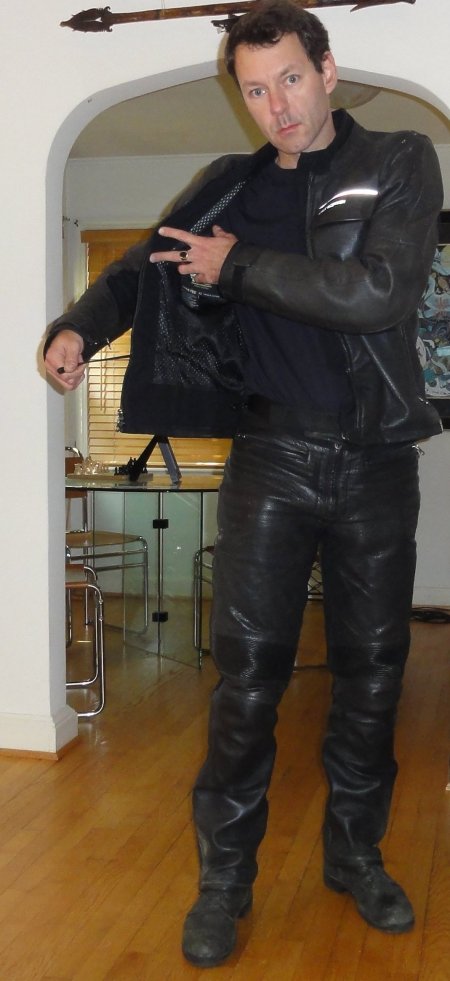
But even with the drawstring pulled in as tightly as you can, the fit is not the greatest. Part of this is because it's cut for a riding position, but my impression is it could at least be cut a little tighter.

As you can see, the jacket tends to bunch up around the shoulders, but again it's optimized for the riding position.
Despite there being only three reflective strips, they light up impressively so I don't think lack of visibility is an issue.
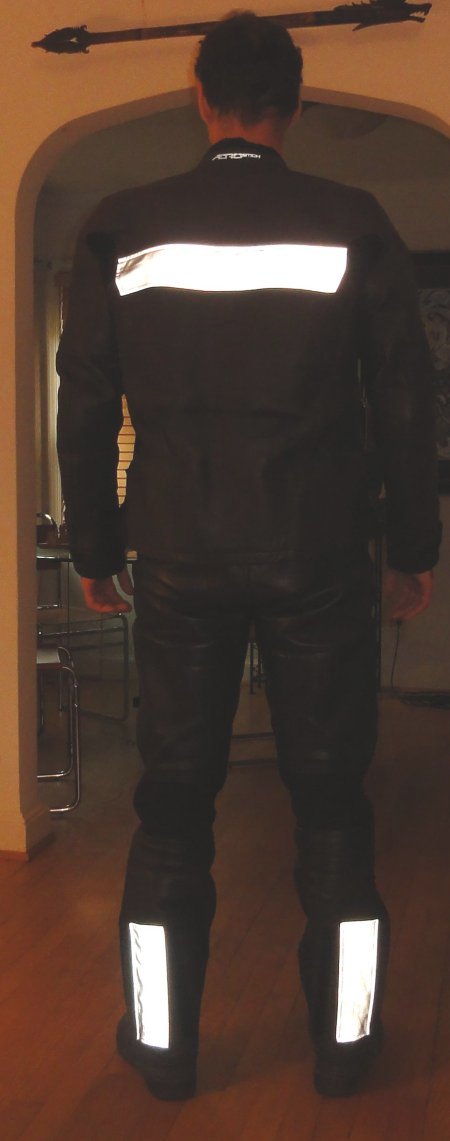
One concern I had very early on was that the stitching wouldn't hold up to the punishment. No later than the day after I bought it, some of the stitching on the sleeve started to unravel.
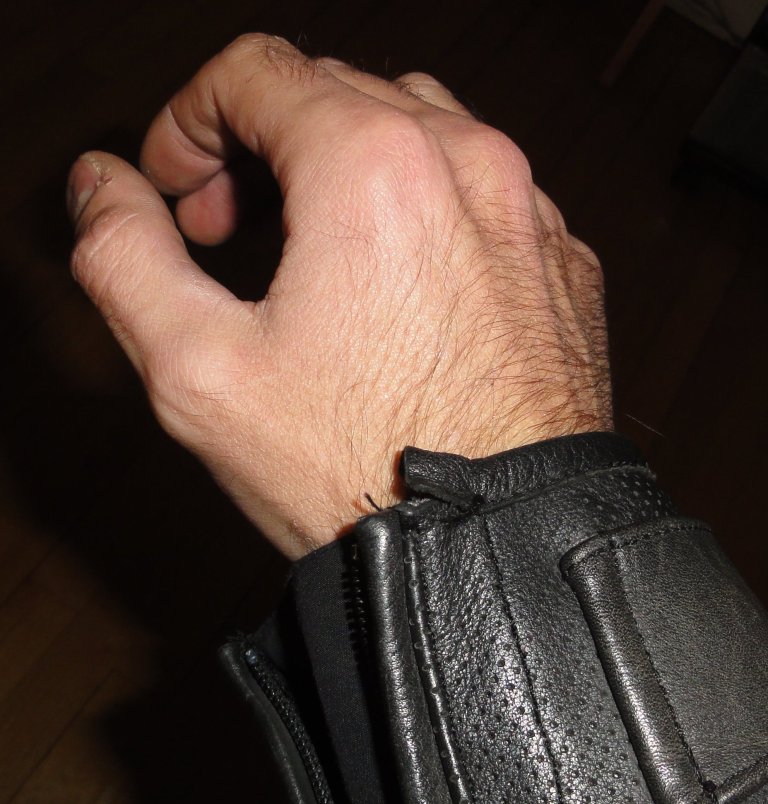
I was pretty bummed about this because I feared the whole suit had some manufacturing flaw that would cause it to unravel. I'm happy to report that so far this is the worst it's gotten. There are a few threads on the right sleeve that also show signs of coming undone, but they have not gotten any worse in the last 14,000 miles so I think it's probably a non-issue.
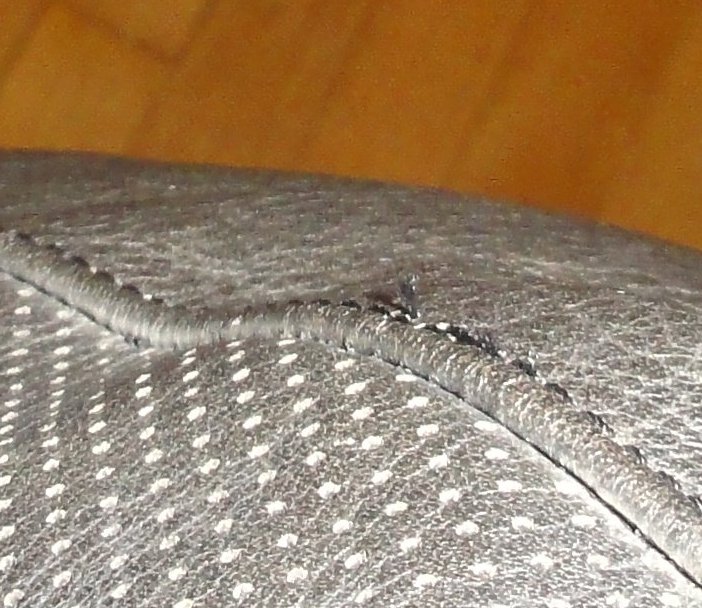
The suit held up well. I thought after taking it all the way to Deadhorse with all that calcium chloride eating away at it that it would look worse for wear but it really isn't too bad.
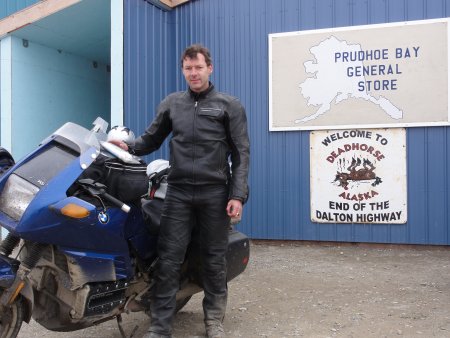
As Phil outside Boston commented, these leathers can develop quite the serious funk especially after you've been stewing in them in East Coast heat and rain. By the time I reached Pennsylvania they were truly foul. I began to call it my Toxic Suit. I would sit down at a bar and people would clear out. I guess, depending on how social you're feeling, the could be considered an advantage.
Yea, it was bad.
Unfortunately, the suit CANNOT be dry cleaned. As a matter of fact, it has to be washed by hand in cold water with a sponge using some kind of light detergent like Woolite. So there I stood, sponge in hand in front of the sink trying to clean the inside and outside of the thing. It worked surprisingly well. I had to remove all the armor. Putting the armor back in can be a challenge, but actually cleaning the suit was not nearly the chore I had feared it would be. The result wasn't bad either.
So in summary, I really like the suit. The more I wear it the more it grows on me. It has a serious feel to it. It's comfortable. It's water proof. It's leather. It reflects heat better than comparable leathers. It doesn't look too bad. It's functional. Strangely, it gets a lot of attention from the hardcore longdistance riding set. Standing around in Deal's Gap, I heard someone say, "Hey, you, do you know what the Alcan is like? You look like you've been to Alaska". He was talking to me. Weird, eh?
The gripes about the suit I have are minor and are mostly related to the lack of a key pocket on the sleeve and insufficient venting for the brutally hot and humid days we get here in DC.
However, all this aside, the big innovation with the Transit Suit is the fact that it is actually completely water proof while remaining breatheable. This seemingly minor detail has completely changed the way I ride. I just don't pay attention to weather as much anymore.
"If it rains, just let it rain and ride on."
In some ways it seems like I just got back from the big trip a few moments ago. In other ways it feels like I've been "away", in other words "home", for far far too long. I am officially underway and am currently hanging out downstairs at Josh's house in Woodbridge typing on this kickass new ultra compact notebook I got, a ThinkPad X100E, specifically for this purpose.
As soon as I reached for my tank bag, I was immediately pulled back to the time when I was Out There. It was a strange surreal moment where it felt to me that this moment I have spent "home" was merely a stop over and where I really needed to be, where home is, was out on the road. I've struggled to find the motivation to write but as soon as College Park is in my rear view it becomes easy. I'm tired as hell right now. Actually I'm exhausted. I had trouble sleeping last night, but here I sit, scotch in hand, typing away.
Duncan and I met Josh at the Total Control course we took in May. In Total Control you learn to apply racing techniques to road riding but not for the purpose of going fast, instead for the purpose of making you a safer rider. The concept is that learning race inspired techniques will provide you with more options for handling the bike when Bad Things(tm) happen. I found the course to be extremely valuable and look forward to taking the more advanced course at some point in the future. It was a relatively small group and Josh was definitely one of the better riders. We got to talking a bit and you could just tell immediately he was "one of us". Given how well he could ride, how well he could control his bike and how balanced and mature his attitudes towards riding were, I was very surprised to hear he had only been riding for a couple of years. Typically if you get into riding this late in life, Josh is about my age, you don't pick it up that quickly. Both Duncan and I were impressed. I have to admit I'm glad we stayed in touch. Josh is good people.
While I was in Kansas City I conspired with Angela to put this trip together. Originally it going to be a bunch of us. I've been calling this the "Angela Inspired Deal's Gap Trip". Unfortunatetly, life happened and Angela and Mike are not able to make it. Bummer. Phil and Geo also had conflicts and can't make it. In the interim, Josh had mentioned an interest in going. It turns out he's never done more than 200 miles in a day and has never done an overnight trip. As I've mentioned before, riding styles matter and traveling that far can stress even the best of friendships. It's been an interesting experience talking to him and answering questions. You don't realize how much you know about a subject until you try to share it with someone else. This should be interesting.
I noticed on facebook that an old friend had just completed a six month trek on foot and has started to write a blog. She wrote a post about diet and how human beings are designed to move. Of course, whenever I embark on a trip by motorcycle I think about risk I take. But I got to thinking if maybe the risk of riding a motorcycle might actually be less than the risk of sitting at my desk not moving day in and day out. How many people do I know who have had heart attacks and strokes as a percentage of all people I know? How many motorcyclists do I know who have gotten hurt as a percentage of all motorcyclists I know? I have the sneaking suspicion that the percentages of the former are greater. Josh and I talked about this for some time this evening after I arrived.
Some time ago, my business partner in our little stock market software company, Anatoly, mentioned he would be interested in how I pack so much stuff on a bike. I had intended on writing some huge description but have somehow never gotten around to it. It felt weird to me to pack up only a subset of the gear I took cross country. It's only a 5 day trip so I really don't need much, but still I thought I'd try to document what I take because I told Anatoly I would.
For this trip I'm packing three bags. I have a tank bag, which as the name implies, is a bag that attaches to the gas tank. Typically you put things in the tank bag that you need while you're underway. It's right there in front of you and is as a result easy to reach. I keep my wallet, keys, cameras and electronics in the tank bag along with some maps.
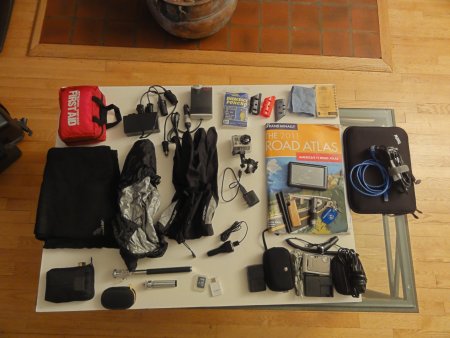
Because the motorcycle can be subject to some harsh movements, I try to mitigate the impact on my electronics by layering a large Aerostich microfiber towel down at the base of the bag. Originally I used this towel for camping, but it leaves countless microfiber strands on you, very annoying. But it acts well as a base. My thinking is also that if any water gets into the bag the crazy absorbant microfiber towel will wick it away. I'm not sure if my logic holds.
On top of the base layer of the towel I put my notebook itself protected in a padded case. I carry an ethernet cable with me because some places still don't have wifi. On top of the notebook I put the 75watt inverter I have. The inverter converts DC power to 120 volts AC and is useful for running low draw AC devices such as a battery charger. On top of the inverter I put the little 12V distribution box and I run a power line to the GPS I have on top and another one to my cellphone charger.
I the helmet cam next to the inverter and the first aid kit to the rear. I have a plastic bag filled with usb cables, battery chargers for my two cameras, a battery charger for my phone and a USB card reader and spare 4gig usb card.
In the top mesh compartment I keep a paper atlas and a couple of maps of the Smokey Mountains.
In the left compartment I keep the indestructible camera along with water proof mits and the rain cover for the tank bag in addition to a microfiber lens cleaning towel I use to clean my sunglasses. I also have some faceshield squeagies.
In the right compartment, I keep the camera tripod, the camera telescoping wand and the Sony Cybershot camera. It's easy to reach there and I've gotten pulling the camera out to shoot something quickly down to a science.
In the forward compartment I keep pens, change, and a flashlight along with lighter and some odds and ends.
The replacement GPS goes on top of my tank bag in a waterproof clear bag. It's a total kludge. I use a sock to prop the GPS up so I can see it while I ride. At some point I'll have to come up with a better mounting system.
All packed it looks pretty clean.
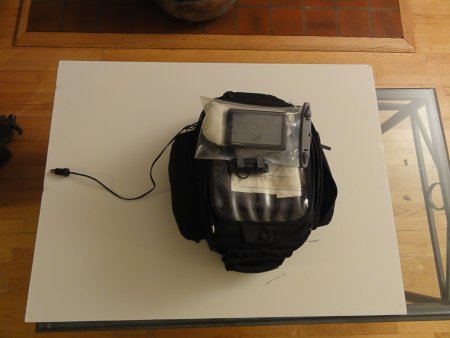
I carry a few repair pieces in a small plastic bag.
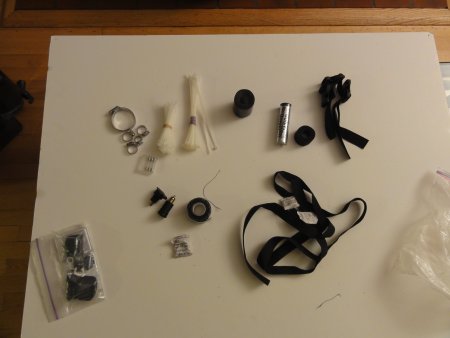
These include:
- a few hose clamps of various sizes
- duct tape
- heat resistant tape (for coolant lines)
- velcro
- straps
- wire ties
- epoxy paste for doing all kinds of road side repairs
In the left saddle bag, since I'm not taking any camping gear with me on this strip, I'm keeping all my clothes, food, and drink.
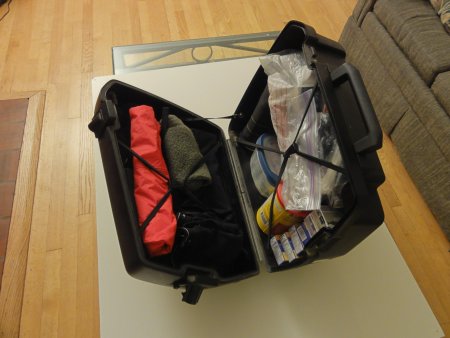
I apparently failed to take a photo of everything carefully displayed. One thing that I regularly forget is to carry a water proof stuff sack to put dirty clothes in. On so many previous trips I had failed to do this and the funk of dirty laundry gets into everything.
In the right tank bag I keep my riding gear. It goes in the right bag because when you put down the kickstand on the left you can quickly get into it.
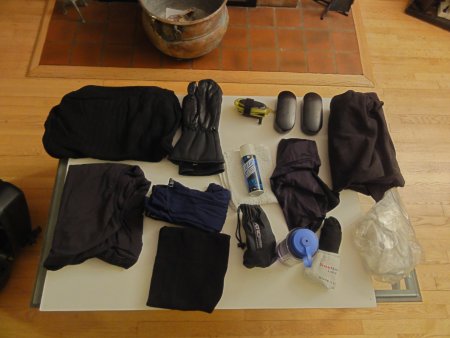
The contents of the right bag go with me no matter where I go, even if it's just a day ride. These include:
- a wool sweater
- a fleece jacket used as a liner under my transit suit
- long johns
- an electric vest
- Plexus plastic cleaner and a terry cloth towel for cleaning my face shield.
- a liter water bottle
- water proof socks
- a mini-compressor for pumping up tires.
- a fuel transfer pump for moving gasoline from one bike to another.
- cold weather mits.
- a neck "gator" for keeping wind off your neck when things get crazy cold.
- two pairs of sunglasses.
- a quart of oil
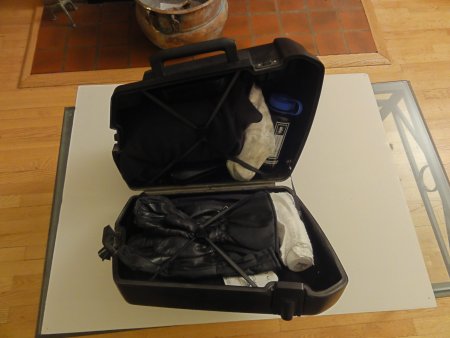
In addition to all this, I have a compartment under the seat at the rear of the bike where I carry:
- tool kit
- owners manual
- tire patch kit
- spare headlight bulb
- spare bulbs for the rest of the lights.
- a "buddy tow" strap for pulling disabled bikes with.
- a BMW plug to plug jumper wire.
- an oil filter wrench.
All packed up the bike looks pretty clean:
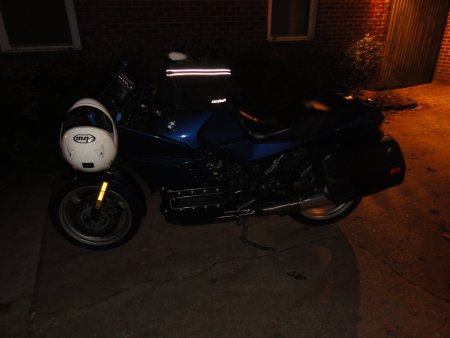
I don't expect I'll do more than 1500 miles on this little trip, not that it matters.
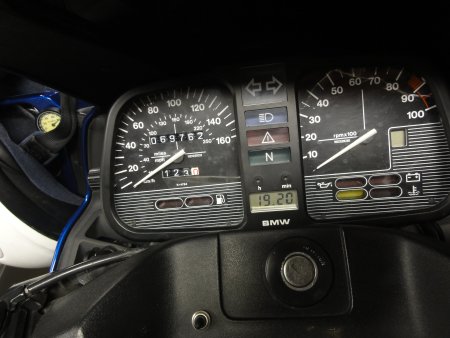
And I did put a very cool Miles by Motorcycle sticker that Stacie designed and that Phaedon printed out on my bike:
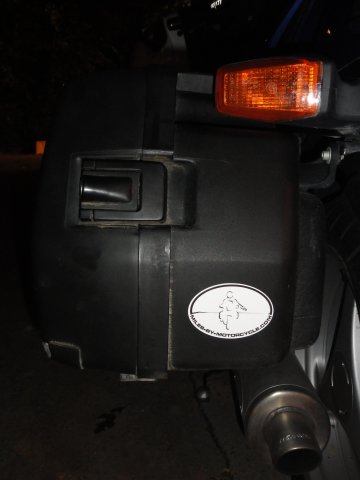
Very cool.
I left the house around 7:20PM and rode down to Woodbridge. Because of the incredibly irresponsible drivers around here, I often think the most dangerous riding I ever do is the riding I do locally. Nothing in Deal's Gap compares to being nearly clipped by some idiot swerving across four lanes of traffic doing 50 over. Idiots.
I arrived at Josh's about 25 minutes later than planned. He rides a Yamaha FJR, a bike that is much faster and better handling than my bike, but is nevertheless is basically the same class.
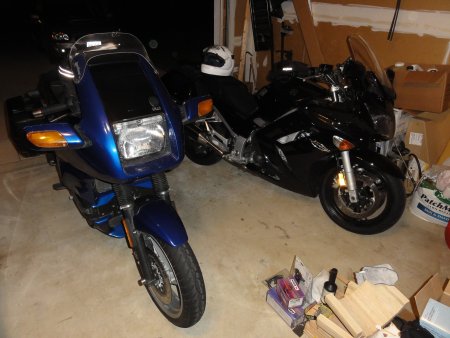
I'm going to have to call it a night. I need to get up at 7:30 tomorrow and have a 500 miles day ahead of me.


